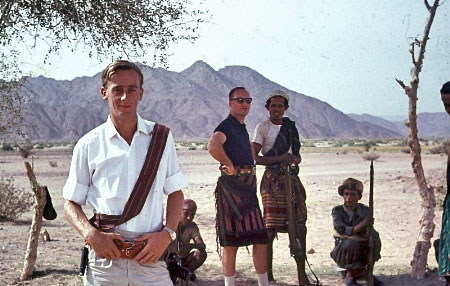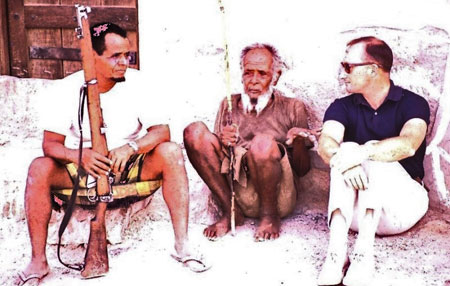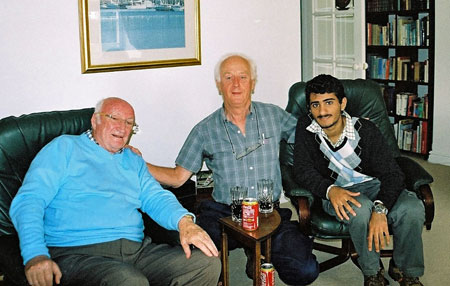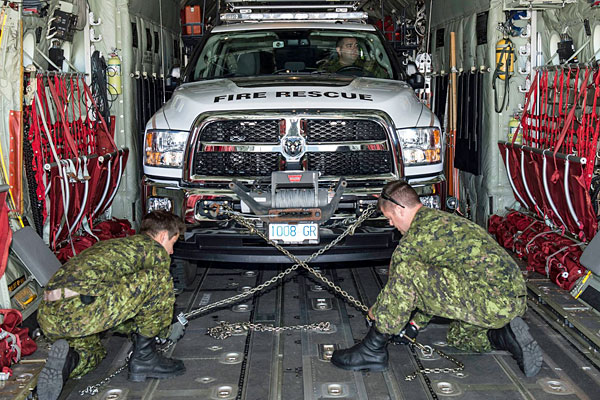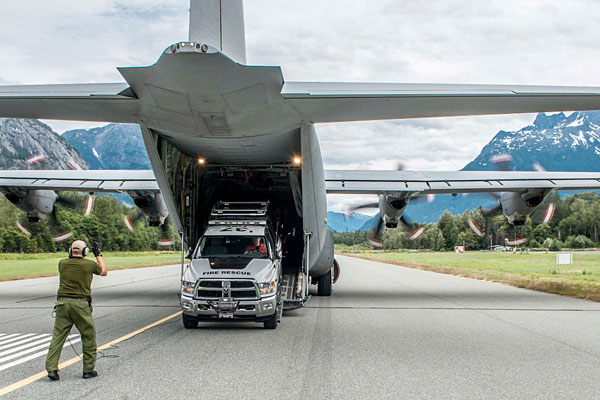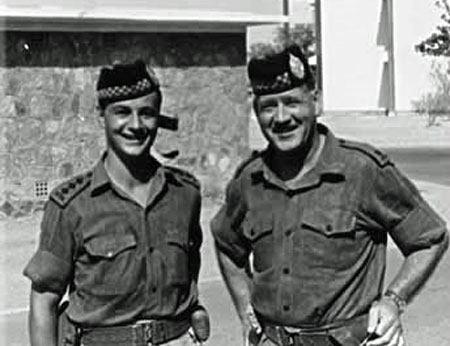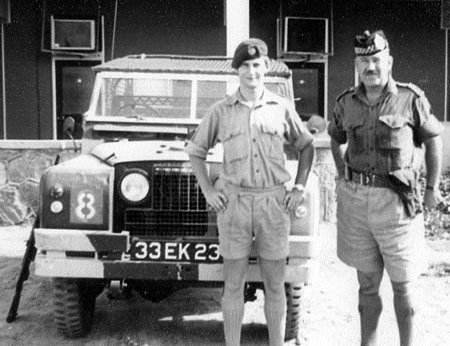


From: Charles Collier, Ewhurst, Surrey
Subject: Aden Days 1966
Aden from 1965 to 1967 was an eye-opener of a first tour of duty for a 24 year old RAF zombie officer doing my duty selling service scrap equipment to 70 odd Arab contractors.
Where I worked in Cemetery Valley, the Aden Forces Pistol Club had a range – so I joined them. The matches were grand affairs including when we visited Djibouti as guests of the French where lavish entertainment was laid on and no expense seemed to be spared. On the other hand, when the French were our guests in Aden, the celebrations were very muted under the stricture of non-public funds which were deemed sufficient by the Command Secretariat for the entertainment of foreign forces during matches. This situation prevailed throughout the two years I was on posting and was, to say the least, a complete embarrassment for us. Nobody complained - least of all the French - so we all had a good time while it lasted.
I was telephoned by a Sqn Ldr Alan D’Arcy, an Arabist of HQMEC, to ask as I was a member of the Aden Forces Pistol Club and had my own weapon would I be prepared to act as his personal escort as he was going to live with the Upper Aulaqi tribe of Arabs for some 10 days and I would be responsible for protecting his life – I was 25; so I agreed!
Subject: Aden Days 1966
Aden from 1965 to 1967 was an eye-opener of a first tour of duty for a 24 year old RAF zombie officer doing my duty selling service scrap equipment to 70 odd Arab contractors.
Where I worked in Cemetery Valley, the Aden Forces Pistol Club had a range – so I joined them. The matches were grand affairs including when we visited Djibouti as guests of the French where lavish entertainment was laid on and no expense seemed to be spared. On the other hand, when the French were our guests in Aden, the celebrations were very muted under the stricture of non-public funds which were deemed sufficient by the Command Secretariat for the entertainment of foreign forces during matches. This situation prevailed throughout the two years I was on posting and was, to say the least, a complete embarrassment for us. Nobody complained - least of all the French - so we all had a good time while it lasted.
I was telephoned by a Sqn Ldr Alan D’Arcy, an Arabist of HQMEC, to ask as I was a member of the Aden Forces Pistol Club and had my own weapon would I be prepared to act as his personal escort as he was going to live with the Upper Aulaqi tribe of Arabs for some 10 days and I would be responsible for protecting his life – I was 25; so I agreed!
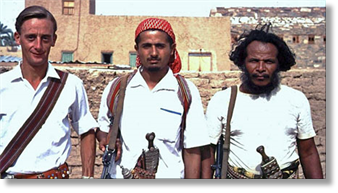
I took sufficient 9mm ammo boxes for the 10 days and waited for the call forward which had been agreed by my CO. We travelled out from Khormaksar on a Beverley of No 84 Sqn, staging at Habilayne camp and then onto Ataq where we were met by representatives of the Upper Aulaqi tribe including their leader called the Naib.
At this point I must explain the role of Alan D’Arcy’s trip up country. He was a secretarial officer at HQMEC but was also a fluent Arab speaker; and as such he had offered his services of Arabic translation to the HQ branch concerned. Hence, he was asked to visit the leader of the Upper Aulaqi tribe and to explain to him what British government policy was with regard to their tribal future in the politics of the day.
At this point I must explain the role of Alan D’Arcy’s trip up country. He was a secretarial officer at HQMEC but was also a fluent Arab speaker; and as such he had offered his services of Arabic translation to the HQ branch concerned. Hence, he was asked to visit the leader of the Upper Aulaqi tribe and to explain to him what British government policy was with regard to their tribal future in the politics of the day.
The Tribal leaders decided that the next day - after Alan and I were refreshed - we should all go for a picnic in the desert close to the edge of the Aulaqi territory.
The journey started early next morning before the sun rose too high in the sky so that we could get shelter from it, at the huge boulder you see here. Our day out was to include a sumptuous meal which would be slaughtered and cooked on site. The main course of the meal was tethered in the back of the Landrover, being completely unaware of what the future held for her!
Water was carried in hog skins so that coffee could be prepared and the cooks had their knives sharpened. We were going to the outer fringes of the tribal region so attack from neighbouring tribes and nationalists was a distinct possibility.
The journey started early next morning before the sun rose too high in the sky so that we could get shelter from it, at the huge boulder you see here. Our day out was to include a sumptuous meal which would be slaughtered and cooked on site. The main course of the meal was tethered in the back of the Landrover, being completely unaware of what the future held for her!
Water was carried in hog skins so that coffee could be prepared and the cooks had their knives sharpened. We were going to the outer fringes of the tribal region so attack from neighbouring tribes and nationalists was a distinct possibility.
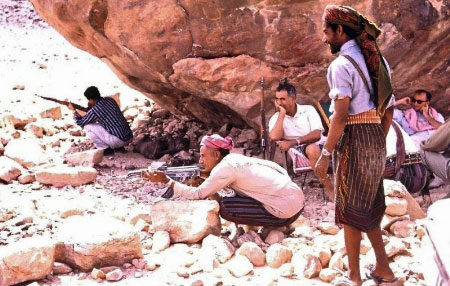
Alan completed his mission of confirming that all was well with the South Arabian Federation which would be supported by the UK forces even after our departure. However, whilst we had been out of communication with the outside world little did we know that the Foreign Secretary, George Brown, had spelt out Aden’s future in that he said that independence for South Arabia would be granted on 9th January 1968 but that in departure from the Government’s policy of military assistance with ground forces then - no support – instead after Conservative opposition badgering the Government, he relented, and offered a force of Vulcan bombers with conventional weapons which would be available to assist the Federation, based on the island of Masirah. The bombers would be supported by a strong naval force in South Arabian waters. Our departure from Nisab and the Upper Aulaqi tribe was imminent. We returned to Khormaksar and re-established our lives in our respective jobs.
I was commanding a patrol controlling a checkpoint on the coastal road from Khormaksar to Crater, stopping all traffic apart from service on duty going into the district. As there had been a recent fire-fight traffic was sparse. I noticed two Landrovers, one with a commander’s pennant, approaching from the Crater region. I called to my scratch team of RAF tradesmen operating as soldiers to warn them of a senior officer approaching and to look smart. The lead LR arrived and out stepped Lt Col Colin Mitchell of the Argyle and Sutherland Highlanders (AKA: “Mad Mitch”). I saluted whereupon two shots from across the bay aimed at us tore through the air between Col Mitchell and myself at head height and struck the cliff on the other side of the road splintering the rock face but no damage to us! The good Colonel said, “I think I’ve outstayed my welcome!”
Since I retired I searched the internet and to my amazement found news of Alan D’Arcy. He was a member of the British Yemeni Society and takes parties to Aden each year. I contacted him by e-mail and at his request sent him pictures of our time in tribal areas – he was amazed with these pictures for he explained that the tribal leaders and their henchmen had been wiped out by NLF insurgents after we left. The Naib managed to get his heavily pregnant wife out of the country to Saudi Arabia – she escaped just before he was summarily executed with the rest of his tribal henchmen. Alan told me that the Naib’s wife had a son and now that he was mature he had been asked to return to the Yemen and resume the leadership of the Upper Aulaqi which he did, and Alan showed him and his tribal brothers pictures of their fathers whom they had never seen.
It was with certain excitement that I waited on Sunday 12th July 2009 for the arrival of my good friend Alan D’Arcy whom I last saw in Aden some 44 years ago, accompanied - on this occasion - by Mohammed Awadh the grandson of one of those Arab leaders that were highlighted in my “Aden Days” article which you will have seen.
Mohammed is a 19 year old student at the Pearson College on Vancouver Island Canada. After his studies there, he may well do a university course on Arabic studies in Britain before returning to the Yemen to take leadership of his tribal region north of Aden.
As he explained, his grandfather’s generation were all executed when the communist insurgents swept into Aden after we, the British, had left and this laid the way for the Union of Soviet Socialist Republics (USSR) forces – the Russians - to move in unhindered.
Alan had asked me if Air Vice Marshal Riseley-Pritchard RAF (Rtd) - one time the principle medical officer of the RAF - who lived locally (to me) could attend as he had been in Aden when we were both there and had also accompanied Alan in recent years visiting tribal leaders who were sick. I, of course, accepted and the photograph shows the principle players in my office.
As he explained, his grandfather’s generation were all executed when the communist insurgents swept into Aden after we, the British, had left and this laid the way for the Union of Soviet Socialist Republics (USSR) forces – the Russians - to move in unhindered.
Alan had asked me if Air Vice Marshal Riseley-Pritchard RAF (Rtd) - one time the principle medical officer of the RAF - who lived locally (to me) could attend as he had been in Aden when we were both there and had also accompanied Alan in recent years visiting tribal leaders who were sick. I, of course, accepted and the photograph shows the principle players in my office.
Mohammed also explained that I possessed amongst my 35mm slides precious pictures depicting his country’s history which he was profoundly thankful when I gave him my total holding of slides of the Aulaqui Tribe of Arabs. As I have most of them on my PC I don’t mind if I never see them again. ~ Charles
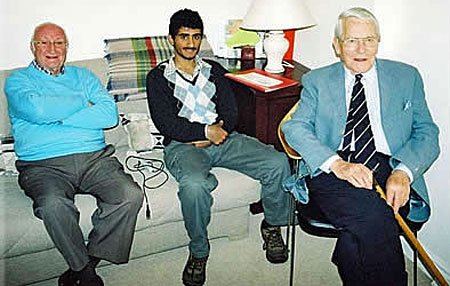




Five Decades Ago
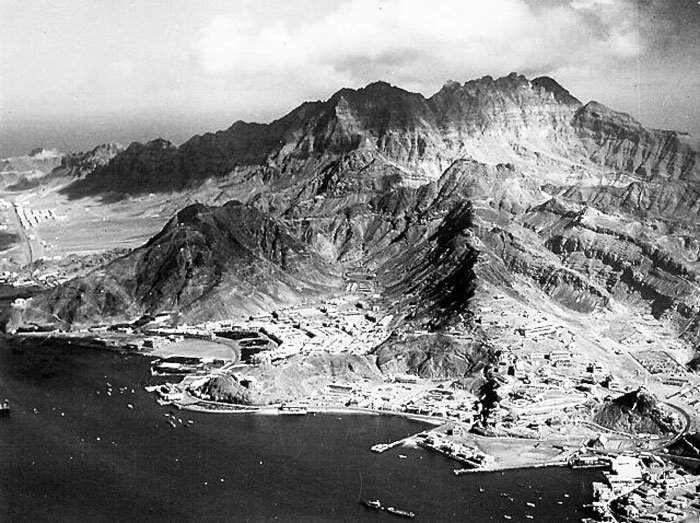
Two years on the barren rocks of Aden -
one of the last outposts of the British Empire
one of the last outposts of the British Empire
Thomas P. Iredale
From: Thomas Iredale, Heidelberg
Subject: Memories of Aden
Subject: Memories of Aden
Discovery
Reading an article about Arthur Rimbaud, a 19th century French poet, in a German newspaper, I noticed that it mentioned that the gentleman had worked as a coffee trader in Aden. More specifically he was in Steamer Point from 1880. I then looked up the various details on the Internet and came across the website of Aden Airways. This site provided a great deal of information on the history of Aden and had many links to other websites dealing with this country. Here I found out about the railway! Reading the contents of the website and the contributions by people who had also been stationed there (military or civil) is why I started to focus on Aden. Before I begin, by the way, the railway was dismantled in 1930 because it lost money and therefore its place in the subsequent history of Aden faded. But here’s the full story:
Yes, there was a railway in Aden!
As early as 1906, a light railway from Aden to Dhala (Dthala) had already been under consideration for some time but nothing had materialised. Mr Cowasjee Adenwalla Dinshaw, (a Farsi gentleman, originally from Bombay, was a businessman in Aden), won the concession to build and operate the 120 km proposed rail link from Aden to Dhala after successfully negotiating a deal with the Sultan of Lahej, who would receive a 4% commission on the profits of the line plus one penny per square (?) of area taken by the line. The first 60km stage of the line was to extend from Aden to Nobet Dukeim. It seems, however, that the railway plan, for some reason, did not materialise.
Some years later in 1915, the CRE (Commander, Royal Engineers) requested permission to lay down a light railway from Aden to Sheikh Othman to supply the British forces fighting against the Turks, with the intention of extending it to Lahej once it was back in British hands. Approval was given and a 1000 mm gauge military railway was built by the Royal Engineers. By December (1915) work was completed on the new railway, providing a quick and efficient way to move troops and equipment to the Sheikh Othman defences.
In 1919, the Aden Government approved the extension to Lahej. The 46.3 km line was made available for public traffic in 1922. Aden was at this time still under the control of Bombay as part of the British Empire and materials for the railway were sourced from the Bombay, Baroda & Central India Railway (BBCIR) and the Eastern Bengal Railway (EBR). The Arabian system was operated by the North Western Railway (NWR) of India under one of its officers, who was designated Engineer-in-Charge. The railway carried passengers, grass, charcoal, green vegetables, potatoes, skins and other goods, and also large quantities of water for the army outpost at Sheikh Othman, which included a mobile force of cavalry and a camel corps.
Some years later in 1915, the CRE (Commander, Royal Engineers) requested permission to lay down a light railway from Aden to Sheikh Othman to supply the British forces fighting against the Turks, with the intention of extending it to Lahej once it was back in British hands. Approval was given and a 1000 mm gauge military railway was built by the Royal Engineers. By December (1915) work was completed on the new railway, providing a quick and efficient way to move troops and equipment to the Sheikh Othman defences.
In 1919, the Aden Government approved the extension to Lahej. The 46.3 km line was made available for public traffic in 1922. Aden was at this time still under the control of Bombay as part of the British Empire and materials for the railway were sourced from the Bombay, Baroda & Central India Railway (BBCIR) and the Eastern Bengal Railway (EBR). The Arabian system was operated by the North Western Railway (NWR) of India under one of its officers, who was designated Engineer-in-Charge. The railway carried passengers, grass, charcoal, green vegetables, potatoes, skins and other goods, and also large quantities of water for the army outpost at Sheikh Othman, which included a mobile force of cavalry and a camel corps.
To carry water, the railway was extended in 1920 to Hassaini Gardens, 13 kms north of Lahej. The Terminal Building in Maalla also housed the Maalla Sub-Post Office which opened in 1922 and closed seven years later, simultaneously with the closure of the railway in 1929. The railway had until that time carried mail. It has been suggested there were 7 locomotives in operation but this number seems rather exaggerated. Upkeep of the railway proved very expensive. £41,707 was outlaid since construction started in 1915 up to 31st March 1920. The operation was not a viable, commercial proposition; the line was closed in 1929 and dismantled in 1930.
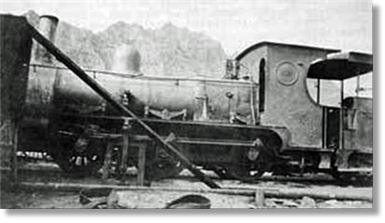
One of the locomotives in Maalla
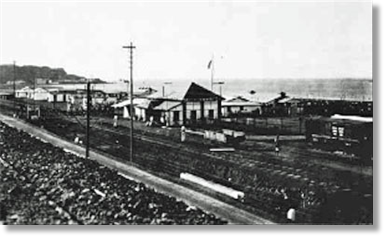
Railway station at Maalla

On 19 January 1839, the British East India Company landed Royal Marines at Aden to secure the territory and stop attacks by pirates against British shipping to India. The port lies about equidistant from the Suez Canal, Bombay (now Mumbai), and Zanzibar, which were all important British possessions. Aden had been an entrepôt and a way-station for seamen in the ancient world. There, supplies, particularly water, were replenished, so, in the mid-19th century, it became necessary to replenish coal and boiler water. Thus Aden acquired a coaling station at Steamer Point and Aden was to remain under British control until 1967.
Until 1937, Aden was governed as part of British India and was known as the Aden Settlement. Its original territory was enlarged in 1857 by the 13 km² island of Perim, in 1868 by the 73 km² Khuriya Muriya Islands, and in 1915 by the 108 km² island of Kamaran. In 1937, the Settlement was detached from India and became the Colony of Aden, a British Crown colony. The change in government was a step towards the change in monetary units seen in the stamps illustrating this article. When British India became independent in 1947, Indian rupees (divided into annas) were replaced in Aden by East African shillings. The hinterland of Aden and Hadhramaut were also loosely tied to Britain as the Aden Protectorate which was overseen from Aden. After the Suez Crisis in 1956, Aden became the main location in the region for the British.
Until 1937, Aden was governed as part of British India and was known as the Aden Settlement. Its original territory was enlarged in 1857 by the 13 km² island of Perim, in 1868 by the 73 km² Khuriya Muriya Islands, and in 1915 by the 108 km² island of Kamaran. In 1937, the Settlement was detached from India and became the Colony of Aden, a British Crown colony. The change in government was a step towards the change in monetary units seen in the stamps illustrating this article. When British India became independent in 1947, Indian rupees (divided into annas) were replaced in Aden by East African shillings. The hinterland of Aden and Hadhramaut were also loosely tied to Britain as the Aden Protectorate which was overseen from Aden. After the Suez Crisis in 1956, Aden became the main location in the region for the British.
Federation of South Arabia and the Aden Emergency
In order to stabilise Aden and the surrounding Aden Protectorate from the designs of the Egyptian backed republicans of North Yemen, the British attempted to gradually unite the disparate states of the region in preparation for eventual independence. On 18 January 1963, the Colony of Aden was incorporated into the Federation of Arab Emirates of the South against the wishes of North Yemen. The city became the State of Aden and the Federation was renamed the Federation of South Arabia (FSA). An insurgency against British administration known as the Aden Emergency began with a grenade attack by the communist’s National Liberation Front (NLF), against the British High Commissioner on 10 December 1963, killing one person and injuring fifty, and a “state of emergency” was declared.
In 1964, Britain announced its intention to grant independence to the FSA in 1968, but that the British military would remain in Aden. The security situation deteriorated as NLF and FLOSY (Front for the Liberation of Occupied South Yemen) vied for the upper hand. In January 1967, there were mass riots between the NLF and their rival FLOSY supporters in the old Arab quarter of Aden town. This conflict continued until mid February, despite the intervention of British troops. During the period there were as many attacks on the British troops by both sides as against each other culminating in the destruction of an Aden Airlines DC3 plane in the air with no survivors.
In 1964, Britain announced its intention to grant independence to the FSA in 1968, but that the British military would remain in Aden. The security situation deteriorated as NLF and FLOSY (Front for the Liberation of Occupied South Yemen) vied for the upper hand. In January 1967, there were mass riots between the NLF and their rival FLOSY supporters in the old Arab quarter of Aden town. This conflict continued until mid February, despite the intervention of British troops. During the period there were as many attacks on the British troops by both sides as against each other culminating in the destruction of an Aden Airlines DC3 plane in the air with no survivors.
From “Around the World in 80 Days”
by Jules Verne (1825-1905)
“….the next day they put in at Steamer Point, north-west of Aden harbour, to take in coal. This matter of fuelling steamers is a serious one at such distances from the coalmines; it costs the Peninsular Company some eight hundred thousand pounds a year. In these distant seas, coal is worth three or four pounds sterling a ton. The “Mongolia” had still sixteen hundred and fifty miles to traverse before reaching Bombay, and was obliged to remain four hours at Steamer Point to coal up. ….Mr. Fogg and his servant went ashore at Aden to have the passport again visaed….”
by Jules Verne (1825-1905)
“….the next day they put in at Steamer Point, north-west of Aden harbour, to take in coal. This matter of fuelling steamers is a serious one at such distances from the coalmines; it costs the Peninsular Company some eight hundred thousand pounds a year. In these distant seas, coal is worth three or four pounds sterling a ton. The “Mongolia” had still sixteen hundred and fifty miles to traverse before reaching Bombay, and was obliged to remain four hours at Steamer Point to coal up. ….Mr. Fogg and his servant went ashore at Aden to have the passport again visaed….”
Some historical background
On 30 November 1967, British troops were evacuated, leaving Aden and the rest of the FSA under NLF control. The Royal Marines, who had been the first British troops to arrive in Aden in 1839, were the last to leave — with the exception of a Royal Engineer detachment.
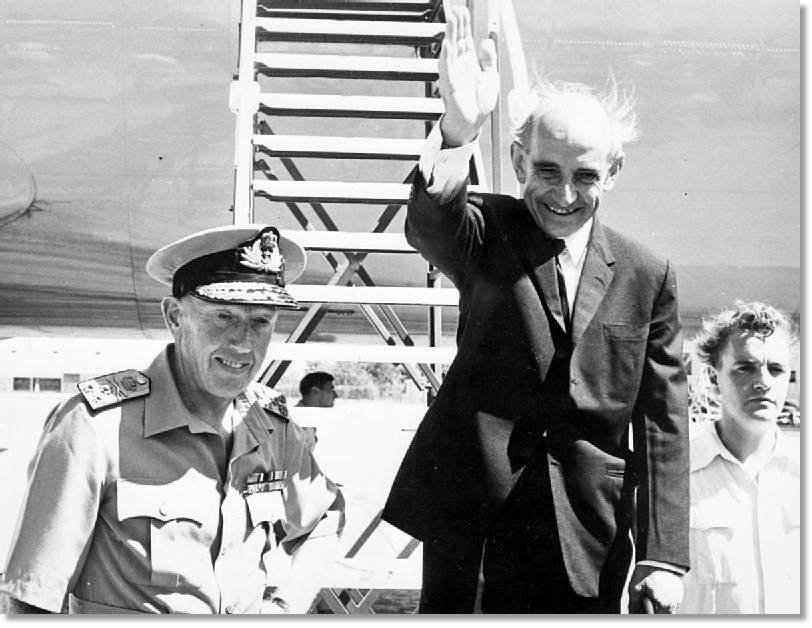
The departure of the High Commissioner of Aden, Sir Humphrey Trevelyan, from Khormaksar on 28 November 1967. The Commander-in-Chief in the Middle East, Admiral Le Fanu, is seen in the foreground.
Exit the Royal Marines and with them, the Empire
Privileged:
Falling into this category were all the other officers and civilians of officers’ status. If married and accompanied, all their accommodation was comfortable and serviced.
As the people in this category were generally in the younger age group and amongst all categories, there was probably more going on for them in the social world.
Unaccompanied, a single officer lived in the Officers’ Mess and enjoyed a watered-down version of their married counterparts. Access to the “watering holes” of the privileged was restricted to the appropriate category where a downward mobility was always possible but never an upward one, without a specific invitation, which was probably extremely rare.
Falling into this category were all the other officers and civilians of officers’ status. If married and accompanied, all their accommodation was comfortable and serviced.
As the people in this category were generally in the younger age group and amongst all categories, there was probably more going on for them in the social world.
Unaccompanied, a single officer lived in the Officers’ Mess and enjoyed a watered-down version of their married counterparts. Access to the “watering holes” of the privileged was restricted to the appropriate category where a downward mobility was always possible but never an upward one, without a specific invitation, which was probably extremely rare.
Privileged status: this is not from Aden, but from the days of the Raj in India
The colonial system still flourished: Long live the British Empire!
In varying degrees, life among the British population - I think I’m safe in saying here - both military and civil was categorised according to status. Broadly speaking, the categories were as follows:
Most privileged status:
General, flag and air rank; high political appointments; their wives and dependents. Surrounded by servants both local civil and service, they lived a life of splendid luxurious isolation in their villas, which were all located in the more salubrious (and guarded) areas around Steamer Point.
They had universal access to everything Aden and neighbouring countries had to offer: sea and land transportation was provided almost on-call. In other words, they walked on water! All those below this exulted status deferred and served in the traditional British manner; these were the colonial royalty.
Very privileged:
These were senior service officers (Group Captains, Colonels, Wing Commander’s and Lieutenant Colonels) and civilians, who were awarded similar status according to their job, as well as their wives and children. They were more in touch with the day-to-day routine of life on say RAF Khormaksar with all its attendant activities and occurrences. They did not live in splendid isolation, but had well-appointed, very comfortable and segregated residences. Their needs were attended by local and Service staff and they had access to virtually all the facilities Aden had and could organise transportation to a limited degree. These were the colonial aristocrats.
Most privileged status:
General, flag and air rank; high political appointments; their wives and dependents. Surrounded by servants both local civil and service, they lived a life of splendid luxurious isolation in their villas, which were all located in the more salubrious (and guarded) areas around Steamer Point.
They had universal access to everything Aden and neighbouring countries had to offer: sea and land transportation was provided almost on-call. In other words, they walked on water! All those below this exulted status deferred and served in the traditional British manner; these were the colonial royalty.
Very privileged:
These were senior service officers (Group Captains, Colonels, Wing Commander’s and Lieutenant Colonels) and civilians, who were awarded similar status according to their job, as well as their wives and children. They were more in touch with the day-to-day routine of life on say RAF Khormaksar with all its attendant activities and occurrences. They did not live in splendid isolation, but had well-appointed, very comfortable and segregated residences. Their needs were attended by local and Service staff and they had access to virtually all the facilities Aden had and could organise transportation to a limited degree. These were the colonial aristocrats.
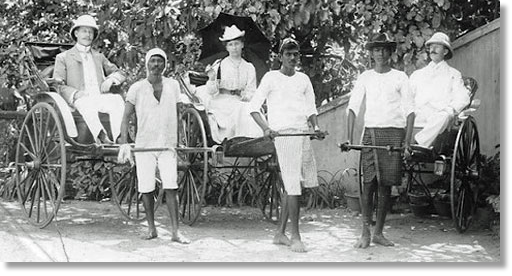
All the rest:
Senior non-commissioned officers and civilians of this status enjoyed a status which enabled them to live a relatively comfortable and carefree life, without the class restrictions and social responsibilities of their officer counterparts, which have been mentioned above. The Sergeants had their own mess and their own beach; Corporals enjoyed a better status than airmen or private soldiers. Not many of the married corporals were accompanied, but those who were enjoyed pleasant serviced accommodation either on or off base. The airmen and private soldiers were all classified as BORs which means “British Other Ranks”. Their access to any place off-base was regulated by a sign outside an establishment, which said “Out of Bounds to BOR”. Even if you were a BOR, why couldn’t you go into a civilian establishment in say, Steamer Point, if correctly dressed, behaved yourself and could also afford it?
Senior non-commissioned officers and civilians of this status enjoyed a status which enabled them to live a relatively comfortable and carefree life, without the class restrictions and social responsibilities of their officer counterparts, which have been mentioned above. The Sergeants had their own mess and their own beach; Corporals enjoyed a better status than airmen or private soldiers. Not many of the married corporals were accompanied, but those who were enjoyed pleasant serviced accommodation either on or off base. The airmen and private soldiers were all classified as BORs which means “British Other Ranks”. Their access to any place off-base was regulated by a sign outside an establishment, which said “Out of Bounds to BOR”. Even if you were a BOR, why couldn’t you go into a civilian establishment in say, Steamer Point, if correctly dressed, behaved yourself and could also afford it?
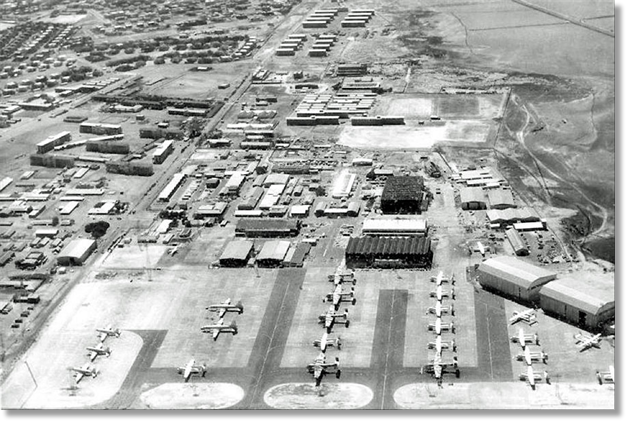
Three-quarters of Middle East Command aircraft were based at Royal Air Force Khormaksar, its main flying station. Khormaksar was a joint user airfield – that is, it was Aden’s civil airport as well as an RAF station, the RAF providing airfield, navigational, meteorological and communications facilities to the many civil airlines operating from and through Aden. Broadly, RAF Khormaksar’s tasks could be grouped under two main headings – tactical and transport.
On the tactical side, its main jobs were to defend Aden and the Protectorates from external attack and to maintain law and order within the territory. The units based there were also called upon to operate, as required, elsewhere in the Command’s area of responsibility. Also included in this side of its duties were control over sea communications within the area, responsibility for the search and rescue organisations in the Command and the maintenance of airfields, navigation aids and facilities extending from Hargeisa in Somaliland to Masirah Island at the entrance to the Persian Gulf.
On the tactical side, its main jobs were to defend Aden and the Protectorates from external attack and to maintain law and order within the territory. The units based there were also called upon to operate, as required, elsewhere in the Command’s area of responsibility. Also included in this side of its duties were control over sea communications within the area, responsibility for the search and rescue organisations in the Command and the maintenance of airfields, navigation aids and facilities extending from Hargeisa in Somaliland to Masirah Island at the entrance to the Persian Gulf.
Royal Air Force Khormaksar was established in Aden in 1917 and then enlarged in 1945 as the British spread their influence deeper into the Arabian Peninsula. In 1958, a state of emergency was declared in Aden as Yemeni forces occupied nearby Jebel Jehaf and RAF squadrons were involved in action in support of the British Army. In the 1960s, during operations around Rhadfan, the station reached a peak of activity, becoming overcrowded and attracting ground attacks by rebels. It was the base for nine squadrons and became the RAF's busiest-ever station as well as the biggest staging post for the RAF between the United Kingdom and Singapore.
In 1966, the newly elected Labour government in the United Kingdom announced that all forces would be withdrawn by 1968. Khormaksar played a role in the evacuation of British families from Aden in the summer of 1967. The station closed on 29 November 1967, becoming Aden International Airport.
In 1966, the newly elected Labour government in the United Kingdom announced that all forces would be withdrawn by 1968. Khormaksar played a role in the evacuation of British families from Aden in the summer of 1967. The station closed on 29 November 1967, becoming Aden International Airport.
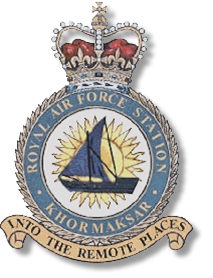
RAF Khormaksar
Aspects which have stayed in my mind
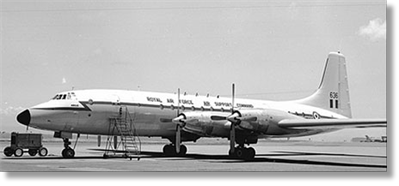
When I arrived to begin my two year tour at RAF Khormaksar, I was 20 years old and single, had been in the Air Force for 22 months and had attained the rank of Senior Aircraftsman (SAC). The flight on a Britannia took twelve hours. All the accounts that I have read about first impressions of Aden, open with the remark that stepping out of the aircraft was like “walking into an oven going full blast.” For me, it wasn’t any different; the heat was awesome, the average mean temperature in November was 28°C. All new arrivals stood out, being pale and were the subject of playful derision by those already there. The usual cries of “moonie” and “Get your knees brown, lad” echoed in our ears. After a few weeks, we new arrivals also blended into the scenery. It was my good fortune that a friend of my father’s and a neighbour at RAF Headley Court, Flight Sergeant Alan Keech was also there and within the first few days he helped me to settle down. He had me order “proper” KD, lightweight civvie trousers and shirts from the tailor in his workshops at 131 Maintenance Unit. He also suggested that I join the Theatre Club.
There were twenty beds to a room when I moved into the Suppliers' block and lying reading on one of the beds was an old school chum, Mick Fox. We were both in the same fifth form at St Mary’s College in Crosby, Liverpool. I had not seen him since 1959 and did not know that he had also joined the Air Force. He was an SAC Supplier Accounting like I was and worked in the Stock Control and Accounting Squadron (SCAS) in Supply Wing. Through him, I was able to get the lowdown on how things were and he gave me lots of tips, because he’d been there for quite some time already.
No longer can I remember the number of the block, which housed the Supply Wing personnel. It was however situated on the right hand side of the road that came up from the gate, where the bus and taxi stops were, past the Officer’s Mess to the main gate of the active part of RAF Khormaksar. The block is still there according to Google Earth. It was well-built, with two floors, having wings on either side of a central stairwell to the first floor. Each wing had twenty bedspaces, ten on each side. Each space was equipped with an iron bedstead, big locker and a small one. On every floor, there was a water cooler, which was a good thing. All furniture was standard Air Force issue, not made locally. The ceilings were high and there were three or four overhead fans, which never broke down. There were wide balconies on either side of the rooms with both glass and louvre doors on the outside. It was OK in the cool season (October-March), but in the hot season took some getting used to.
The Bristol Britannia - the passenger seats in RAF transport aircraft were all backward facing
Life can’t be all that bad! The author lying on his bed - note the tailor-made KD
Each room had a bearer or chai-wallah, who made the beds, collected and delivered laundry, cleaned shoes and kept the place clean. He also made tea and sandwiches and lived from the money he made from us. How much, I no longer recall. He had a small room adjoining the dormitories, where he kept his tools of the trade. By and large, everyone in the block got along with each other. As we worked from seven in the morning until one pm, the afternoons were free. I can remember some marathon games of Monopoly, real cliff-hangers! Some played cards, but I wasn’t into that. Then sometime at the end of 1964, the blocks were due to be air-conditioned, which would really be luxurious in the hot season. The drawback was, that everyone in a room had to find alternative accommodation, whilst the ducting was being installed in his room. I was very fortunate to be able to bunk in with my two buddies Cpl Terry Fowler and Cpl Gerry (surname not remembered), who had their own room downstairs in the block. But bed only – lockers had to stay upstairs, so I had to go up to the first floor to change and get dressed. This all lasted a few weeks but I don’t recall any big “switch-on” euphoria, when the air-conditioning was switched on.
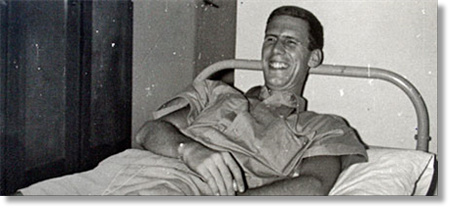
Supply Control and Accounting Squadron (SCAS)
I was posted to Supply Wing at RAF Khormaksar, possibly the largest RAF station in the world and started to work in Stock Control. In SCAS, my job was to take the telephone orders for items required from authorised users. An authorised user was an NCO or officer, responsible for an inventory or section. Among the hundreds, if not thousands of items which fell into my remit was ground equipment (section 4). I cannot recall the others.
There were five of us doing this in my particular section. There were three sections altogether. The stock control cards, called Form 1640s – one card for each item – were in a bin on wheels next to my desk. This was also close to one of the air conditioning units set into the wall, which made SCAS quite a pleasant place to work in, when you consider the climate. When a call came, I would write down all the items requested, pull the 1640s and check them for stock. If we had stock, I wrote out the preprinted voucher (a Form 674 for “Issue”), put it into a folder with the card(s) and passed it on for vetting to the Corporal, who passed it on the Sergeant for approval and issue. Part of the Form 674 went on its way to where the stock was held and the other part went with the F 1640 to be processed in the machine room. That is an easy description, but it was in fact somewhat more complicated and not madly exciting.
My Corporal’s name was “Taff” and obviously he was a Welshman, but I can’t remember his full name. My Sergeant was John Shaw, a strict and very fair person who smoked a pipe, who had been in the RAF for a fair while and knew the Supply business inside out. One of the Sergeants responsible for another section was Des Strongman. I don’t recall the name of the other one, but he had a very distinctive moustache.
There were five of us doing this in my particular section. There were three sections altogether. The stock control cards, called Form 1640s – one card for each item – were in a bin on wheels next to my desk. This was also close to one of the air conditioning units set into the wall, which made SCAS quite a pleasant place to work in, when you consider the climate. When a call came, I would write down all the items requested, pull the 1640s and check them for stock. If we had stock, I wrote out the preprinted voucher (a Form 674 for “Issue”), put it into a folder with the card(s) and passed it on for vetting to the Corporal, who passed it on the Sergeant for approval and issue. Part of the Form 674 went on its way to where the stock was held and the other part went with the F 1640 to be processed in the machine room. That is an easy description, but it was in fact somewhat more complicated and not madly exciting.
My Corporal’s name was “Taff” and obviously he was a Welshman, but I can’t remember his full name. My Sergeant was John Shaw, a strict and very fair person who smoked a pipe, who had been in the RAF for a fair while and knew the Supply business inside out. One of the Sergeants responsible for another section was Des Strongman. I don’t recall the name of the other one, but he had a very distinctive moustache.
“An inch and a half above the knee”
Not much when you think about an inch and a half, yet this small dimension caused more than a ripple to the hundreds of Air Force personnel stationed in Aden during the mid-1960s. The legendary WW2 fighter pilot ace, “Johnnie” Johnson was the Air Officer Commanding (AOC) Air Forces Middle East (AFME), and in that capacity was “Lord of the Rings” in Aden. I could never quite fathom out, why this particular bee with the “1 ½ inches above the knee” got into his bonnet, but the effects of the edict were wide-ranging! I presume that somewhere in the dress regulations for the Royal Air Force, there must have been a detailed description concerning how KD had to be worn. Having said all that, he may well have had a point. The hemlines - if I may call them that – of the shorts worn by RAF personnel did vary between quasi bell-bottoms and mini-skirts. As the AOC, it was his duty to see that regulations were adhered to. After the order came out, there was a rush to the tailors (for the poor unfortunate unmarried) to have the shorts’ hemlines lowered to the required length. It was most amusing, because you could see the colour difference of the let-down material. Honestly speaking, it seemed to me to be a bit ridiculous, for by and large there was very little, which was “inappropriate”. Nevertheless, the tailors, most of whom were Indians, profited from this unexpected surge in turnover.
Starched stiff as a board
I recall another bee that the AOC had in his bonnet. He was very keen on stiffly-starched KD. There was the annual AOC’s inspection, preceded by a parade (in the very early hours of the morning, thank heaven) at Khormaksar. He went down the ranks, stopped in front of an airman, remarked on his Khaki Drill (KD) uniform, which had been starched stiff as a board, complimented him and asked him, how much it cost – 50 cents or whatever. The starching was usually so extreme, that you had to prise open the sleeves to put it on. Needless to say, after a day’s wear in that climate, especially in summer, the starched uniform KD was limp. Most of us wore our issue KD, suitably starched, only for parades, but I had 2 sets of tailor made KD, which were very comfortable.
Still on the subject of Johnnie Johnston, in 1964 he had a book published, called “Full Circle” about the evolution of air fighting.
A bookshop in Crater was selling this book and being curious (and a little impressed) I bought one and found that it had been signed by the man himself. I still have the book 50 years later. The jacket is a bit torn, but otherwise in very good condition.
A bookshop in Crater was selling this book and being curious (and a little impressed) I bought one and found that it had been signed by the man himself. I still have the book 50 years later. The jacket is a bit torn, but otherwise in very good condition.
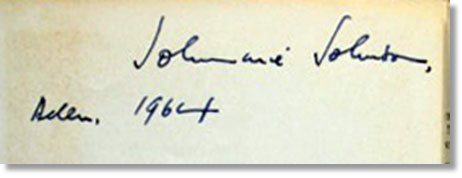
“Full Circle”
Food
My recollection of the food in the Airmen’s Mess is a bit hazy as I use to dread going there, because it was so stifling hot in both the dining and the serving area. To give them their due, the cooks did not have an easy time in the heat, but the menus seemed to be all traditional UK-type mess food, heavy and basically unsuitable to the climate. What does stick in my mind is that when fresh grapefruit was served at breakfast, I was up early to get some before it all went. Otherwise, I never went to breakfast, was content with a cup of tea from the bearer and then had some rolls at the Supply Wing Stim bar. I never found out if there was any truth in the rumour, that the Mess cooks put bromide into the tea! Eating out was on the whole quite good. I remember the small restaurant in the shopping centre not far from the camp gates. On the other (back) entrance to the camp, there was a fish and chip wagon, which was very well patronised and I believe, is still there, although now it seems to serve hamburgers.
Uniform
The usual footwear in (or out of) uniform was the desert (or Bondu) boot, made of suede leather with a crepe sole. They were actually very comfortable, but you had to buy them yourself. I even had a pair custom-made (but with leather soles) by an Indian cobbler, who drew the outline of my bare foot on a piece of paper. When I came to wear them they were a bit tight, because of course, these boots were worn with socks. So it was not exactly the best investment I had ever made. The RAF issue black shoes were not really ideal for tropical wear, as they were heavy and a tighter fit than the desert boots.
Flip-flops were omnipresent in the off-duty hours and they were practical and comfortable. The long socks we wore were made mainly of nylon, which to modern thinking is not a very healthy idea, but with the help of Mycota or whatever the anti-athlete’s foot powder was called, feet problems were kept to a minimum. The beret was a bit stupid, because it was not tropical weight and afforded no full protection from the sun. My dad was issued with a toupee when he was posted to Egypt in 1938 and these days, floppy sun hats have become accepted head wear. Of course, you had to take all your kit with you, when you are posted. Amongst my kit was a greatcoat, which I certainly didn’t need in that climate and for once, the Air Force made a sensible arrangement, whereby your greatcoat was vacuum-packed and held in storage for you. Then you were issued with a deficiency chit for “Greatcoats, Airman, 1”, which had to be produced when there was a kit inspection. I never knew what happened to it after I left, as I didn’t take it with me. Perhaps my greatcoat is still there!
Flip-flops were omnipresent in the off-duty hours and they were practical and comfortable. The long socks we wore were made mainly of nylon, which to modern thinking is not a very healthy idea, but with the help of Mycota or whatever the anti-athlete’s foot powder was called, feet problems were kept to a minimum. The beret was a bit stupid, because it was not tropical weight and afforded no full protection from the sun. My dad was issued with a toupee when he was posted to Egypt in 1938 and these days, floppy sun hats have become accepted head wear. Of course, you had to take all your kit with you, when you are posted. Amongst my kit was a greatcoat, which I certainly didn’t need in that climate and for once, the Air Force made a sensible arrangement, whereby your greatcoat was vacuum-packed and held in storage for you. Then you were issued with a deficiency chit for “Greatcoats, Airman, 1”, which had to be produced when there was a kit inspection. I never knew what happened to it after I left, as I didn’t take it with me. Perhaps my greatcoat is still there!
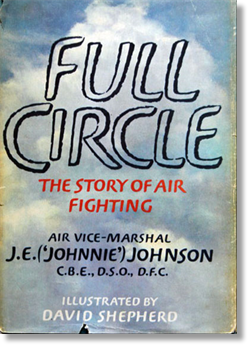
Stim bar
Each squadron had their own Stim bar and they varied in the services provided, depending on who was running it. They were all equipped with fridges and other facilities for preparing food and drink. By and large, I never heard of any hygienic problems. Ours was housed, I think, in a modified aero engine packing case – or at least this was the basis. The name came from a soft drink brand. Now a Stim bar was an interesting business model. It was run by the wing or section and all profits stayed there. As there was money involved, it had to be overseen by a commissioned officer.
Nairobi
I managed to get away to Nairobi to visit my family, as my father was on an accompanied tour at RAF Eastleigh. The flight was courtesy of a 205 Squadron Argosy. The co-pilot I remember very well, as he was a very friendly young chap called Martin Willing – a Flying Officer at that time. He wore a red baseball cap (of which you see millions these days) which of course clashed with his greenish flying suit. I later met him again, when I was OC Air Movements Squadron at RAF Benson in 1970 and he was still flying Argosies. We still chuckled at my red hat recollection six years later.
Photography
It was Roger, who taught me how to develop and print black and white films. My interest in photography continues to this day, but it is no longer film, but digital. I bought an enlarger and all the other stuff you needed to print negatives, but I had the films themselves developed locally. I took over the bearer’s room (he had already gone home for the night), blacked it out and set up the enlarger. Then I mixed the developing and fixing chemicals and got started. There was no fan in the room; the window was blacked out and you can probably imagine the stifling air already! However, I persevered and was not too displeased with my results. Pete Bagley – SAC and drummer with a band called “The Casuals”, which had a regular series of bookings, gave me my first commercial photography job. I soon discovered that I still had a lot to learn about taking action shots on stage outdoor in the evening. Sadly, despite having taken possibly hundreds of pictures, I no longer have them any more.
Charity drives
One of the nicer things about the Services is their willingness to contribute to charity. This takes many forms from sponsored events, lotteries and cash drives. Whilst I was in SCAS, I helped organise a charity drive for the “Wireless for the Blind” fund. I created a map of the world, showing all the countries from UK to Aden and a flight route from Aden to the UK, total distance 3,600 miles, divided into segments of 100. An aeroplane was affixed to the corresponding segment, representing the amount of cash we had raised. This translated as one EAS per flight mile. We collected EAS 3,600 and accompanied by the beautiful Jane, daughter of an SNCO, Flt Sgt Thompson in SCAS, I went along to BFBS, where we were interviewed and handed over the cash for the “Wireless for the Blind” Fund.
Christmas
The first Christmas I spent there (1963) was on the beach, as I was too new to have the kind of close friends who invited me for Christmas. The second Christmas in 1964, was spent with the family of a Warrant Officer from SHQ and Cpls Terry Fowler and Gerry (forgive me, your surname escapes me, as also the name of the WO). Not that I was particularly homesick or anything, but it was nice to be in a home and not in a barrack or clubhouse or mess. I did really appreciate this friendship, despite the disparity in rank again. The WO and his family had Married Quarters in the compound just outside the camp. We were there fairly often for a meal or drinks and sometimes we stayed over, as they had two spare bedrooms. The WO was later posted to RAF Innsworth and sometime after I was commissioned, I visited him and his wife there.
Snorkelling in Elephant Bay
Quite soon after I arrived, I bought a face mask, snorkel and a harpoon gun. I had noticed from earlier swims in the sea that there was a lot of fish around. I thought that I would try my hand at catching them.
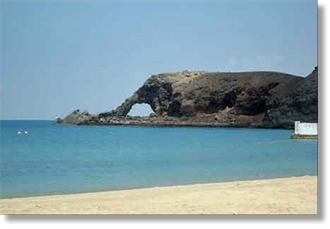
Catching the fish, however, was not as easy as I had imagined. They were always too quick for me or more likely I was too slow for them. The only thing I distinctly remember catching was a squid. However, the problem I had was how to remove it, because its tentacles were entwined around the harpoon. With friends giving the usual bizarre advice, I finally decided to reload the harpoon into the gun and fire it into the air. This was done and when the harpoon line ran out, the squid continued on its maiden flight into the sea. This made me feel bad and shortly afterwards, I sold the harpoon to somebody else.
The stinking whale
One summer’s day in 1964, a whale went off course and erred into the shallow waters of Elephant Bay. It could not get back into deep water and I’m not sure if any rescue attempt was made or would have even been possible. The whale lay there, beached. Gradually, under the murderously hot sun and high humiditiy, the carcass began to decompose and the smell was carried by the sea breezes to those using the beach. It was an intense and disagreeable stench. Weeks, it seems, must have gone past before the smell subsided.
Being there and getting away
The tour of duty in Aden was 2 years and many had a chart on which they counted the days still to go and delighted in crossing of the “time served”. There was a name for it (Tourex or Blighty chart?), but it escapes me right now. I didn’t recall anymore who was there saying that they enjoyed it, but some were definitively better off there than others – at least in the financial sense. Depending on your rank and marital status, you got a “Local Overseas Allowance”, which was useful and of course, it was tax-free. Other things too were tax-free, like cigarettes and booze. BOR’s (British Other Ranks) (what a dreadful expression – very colonial!) could not buy spirits (by the bottle) – this was a privilege reserved for NCOs and officers.
Within the tour, you were entitled to one free air travel ticket to the UK (renown as LUKFREE). Most took this after the first year. There was also an entitlement to spend 14 days at the Silver Sands Resort, run by the Services, in Mombasa, Kenya. Due to my being sent home for the Officer and Aircrew Selection Board (OASC) at Biggin Hill during the May of my second year, I never went to Mombasa. For the OASC trip, I was allowed to tag on some leave in the UK and I spent it with my family in Headley Court. From hearsay, the Silver Sands sojourn seemed quite idyllic. It was said that when you arrived, you chose an African lady (or she chose you), who looked after you in all senses of the word during your stay. She was remunerated by her current “client” and took care of all the cooking, cleaning and laundry.
Within the tour, you were entitled to one free air travel ticket to the UK (renown as LUKFREE). Most took this after the first year. There was also an entitlement to spend 14 days at the Silver Sands Resort, run by the Services, in Mombasa, Kenya. Due to my being sent home for the Officer and Aircrew Selection Board (OASC) at Biggin Hill during the May of my second year, I never went to Mombasa. For the OASC trip, I was allowed to tag on some leave in the UK and I spent it with my family in Headley Court. From hearsay, the Silver Sands sojourn seemed quite idyllic. It was said that when you arrived, you chose an African lady (or she chose you), who looked after you in all senses of the word during your stay. She was remunerated by her current “client” and took care of all the cooking, cleaning and laundry.
Elephant Bay
Getting around
Prior to the increasing terrorist activities in 1965, life was quite bearable and you could travel freely within the areas, commonly frequented by us. That is to say, Khormaksar, Maalla, Crater, Steamer Point and Elephant Bay. I didn’t have a car and the majority of single personnel didn’t have one. So we went by taxi or bus. These latter vehicles generally had no windows, so that as long as you were moving, being inside the bus was bearable. They were somewhat antiquated, where they originally come from, I have no idea. By and large, they got you from A to B very cheaply. One day, I was in one going from Maalla to Steamer Point, when it had an accident with a car. The bus stopped, the Aden Police came and I had to go to the station and make a statement. I no longer remember any more details.
Local currency
For a long time, Aden was administered by the Raj in India and the local currency was rupees and annas. When India gained its independence in 1947, the local currency was changed to “East African Shillings”. Local pay was in this currency and you used it to pay for everything both in the Service facilities (e.g. NAAFI) or the local economy. I’m not quite sure about the changeover date, to dinars and fils, but remember distinctly a saying which was quite clever, namely that “I’ve had more fils, than you’ve had hot dinars!”
An Argosy lands in the sea
This was indeed a big crowd puller - the Argosy which ditched in the sea. I also went down a few times to have a look. Here are two accounts as to how this happened:
“While on crew training on 23rd of March 1964, Argosy XP 413 ditched in Aden harbour. Due to the prompt action of the engineering team it was recovered, dismantled and returned to Hawker Siddley Aviation in the UK on the 20th of June 1964 by surface transport. In the UK it was totally refurbished and transferred to 242 Operational Conversion Unit (OCU) on the 5th of May 1966.”
Roger Wilkins [Radfan Hunters Web Page] recalls: “We were driving in our little Fiat 600 along a road which bordered the inner harbour and as we rounded a bend there was an Argosy, for all the world like a flying boat, lying in the water not 50 yards from the shore.
Roger Wilkins [Radfan Hunters Web Page] recalls: “We were driving in our little Fiat 600 along a road which bordered the inner harbour and as we rounded a bend there was an Argosy, for all the world like a flying boat, lying in the water not 50 yards from the shore.
"It turned out that it was a ‘feathering’ classic. The Argosy (XP413 from 105 Squadron) had been up on training mission for a newly arrived pilot and one of the exercises was a practise engine failure on the approach to land at Khormaksar. The instructor pilot had shut down the port inner expecting the trainee pilot to feather that engine. Unfortunately in his anxiety to cope with the emergency the co-pilot feathered the port outer. The Argosy does not fly well on two engines particularly if they happen to be on the same side! As there was not enough time to relight the port inner or un-feather the port outer the Captain had no alternative but to ditch the Argosy in about three feet of water.”
The local population
If not all, then most of the Service personnel had little or no contact with the local Arab population beyond those who provided the usual services a major air base required. But the local population also included a large number of Indians, who had been there for a couple of generations. These people ran shops and businesses and I made friends with an Indian lad about my age called “Adi” Patel. His dad ran a fairly big shop in Steamer Point and they lived nearby or even above the shop. My mate, Arthur, who also worked in Supply, went along as well and it was quite a nice change to be in a different culture.
Haircut and shave, please
As far as I recall, the barbers were Indians and their shop was in or near the Airmens’ NAAFI. Prices were not exorbitant and hair tended to be worn short anyway. One day, I thought I would find out what it was like to be shaved by a barber. It seemed a bit funny, but I thought I’d give it a try anyway. In the chair, head tilted back the barber began lathering my chin. Then he honed his cutthroat razor on the strop and began to scrape my stubble. He was so efficient, that it was all over in five minutes flat. I don’t believe I thought it was the closest shave I’d ever had, but it was an experience - which I have never repeated since.
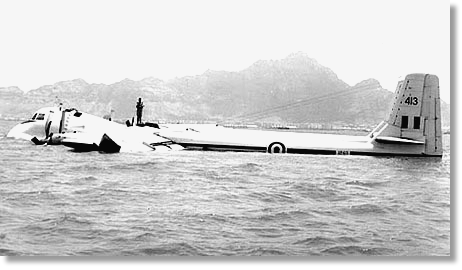
Arabic
For day-to-day contact with the Adeni population, many of whom spoke some English, we had a basic vocabulary of Arabic. Together with body language, signs and sometimes a picture, we seemed to muddle through with the following limited range of Arabic:
Hay fever adieu!
From the age of about ten, I dreaded sunny days in summer, when the grass pollen was in the air. Itchy eyes, runny nose and basically had to take shelter inside. I loved rainy days, then I could go out. Arriving in Aden, I entered a pollen-free zone, although I did not consciously register this fact. After a year’s sojourn in Aden, I went back to the UK on leave in the summer months and had no attacks of hay fever. After almost 2 years in Aden, I was completely cured and have never had any problems since. No one really thinks of Aden as a therapeutic location, but I am grateful for the fact that there were billions of grains of sand, but not a single grain of grass pollen!
A birthday to remember - the next day, anyway!
The 7th March 1964 was a Saturday and also my 21st birthday. As we worked on Saturday mornings, I invited a few friends to the Camel Club, which was across the road from the mess, for a few drinks. Well, we had a few drinks, everything was going well and I must admit I felt fine. Unbeknownst to me my drinks were being doctored….! With rum and Coke, it’s difficult for an occasional drinker (as I was then) to tell the difference in proportionate taste (strong Coke, this!). At another table, some lads had a pet monkey, which they fed with rum and Coke as well and it was actually quite funny to watch. Then all the lights around me went out and I knew nothing until I woke up in my bed the next morning. What was that saying: “Never again?”
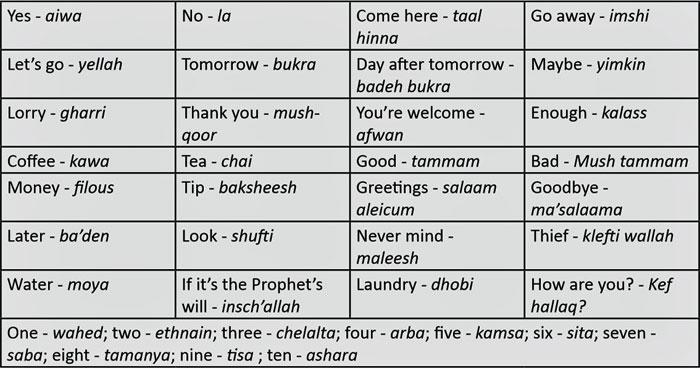
Terrorism gathers pace
Chicken wire
As terrorist activities started to increase, am no longer sure if it was 1964 or 1965 – I remember being part of a detail to affix chicken wire to the outside of all the windows of the married quarters. The idea was to screen the windows, which were usually open (normal – as there was no air conditioning) against a terrorist lobbing a hand grenade through the window. So off we went – a pair of pliers to cut the chicken wire to size and a hammer and nails to secure it in place. I don’t remember how many windows I “secured”, but it was quite a few. I just hope that the residents appreciated our efforts!
Guard duty
Guard duty definitively put a mocker on my social life and that of almost everyone else in Aden. Security became ever tighter and restrictions to movements became severe during the latter part of 1965, when guard duty was significantly increased. During the early part of my stay, it wasn’t too onerous – maybe once a fortnight. “Buying” guard duties was a lucrative trade for those who had no outside interests. Those with an outside interest, like my friend Pete Bagley, who was the drummer in a band heavily booked by the Sergeant’s Mess, Corporals Club etc, could easily afford to pay someone to do his guard duty. How much it cost, I have no idea, but it was well worth it, if you had nothing better to do.
You went on your guard duty at 18.00 hrs. You reported to your detail, wherever that may have been and were issued with a Lee Enfield rifle, calibre .303 and five rounds of ammunition (ball) as well as the “yellow card”. This latter contained the circumstances when you could shoot your rifle (shoot to wound!). I no longer have a copy, but after you read what was written, it made you think twice of the dire consequences, before loosing off a round! After drawing your weapon and five rounds, you were divided into watches of two hours on and four hours off.
You went on your guard duty at 18.00 hrs. You reported to your detail, wherever that may have been and were issued with a Lee Enfield rifle, calibre .303 and five rounds of ammunition (ball) as well as the “yellow card”. This latter contained the circumstances when you could shoot your rifle (shoot to wound!). I no longer have a copy, but after you read what was written, it made you think twice of the dire consequences, before loosing off a round! After drawing your weapon and five rounds, you were divided into watches of two hours on and four hours off.
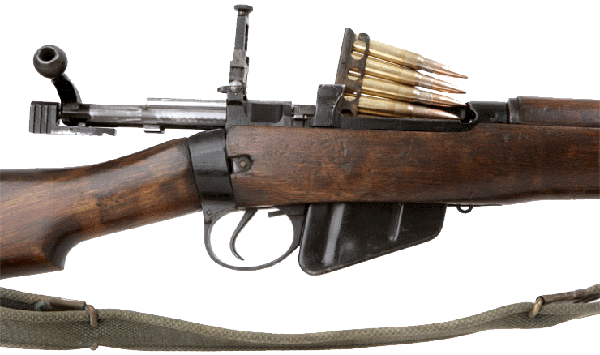
The Lee Enfield rifle weighed 4 kg and the magazine could hold ten rounds of .303 ammunition. It had a kick like a mule into your shoulder. Basically this rifle served the British Armed Forces during both World Wars and other conflicts since, until it was replaced by the FN rifle.
The shift system
First shift: 18:00-20:00; 24:00-02:00
Second shift: 20:00-22:00; 02:00-04:00
Third shift: 22:00-24:00; 04:00-06:00
I’m no longer sure how the shifts were allocated; the most unpopular shift was naturally 02:00-04:00. I think the sergeant in charge of the guard allocated the shift according to how he wanted – by calling for volunteers or arbitrarily allocating the slots as he wished. What was the best shift? All had their advantages and disadvantages. For me, there is no doubt that the 02:00-04:00 slot was the killer, as you had no “rhythm” in your body clock to operate at this hour of the morning! Between patrols, you could get your head down and young as we were, we could sleep anywhere. To be rudely awoken (not really – let’s face it – it was a system and nothing personal) shortly before two a.m. was awful, but it had to be done and so we staggered up, got our rifles and went out into the night.
Second shift: 20:00-22:00; 02:00-04:00
Third shift: 22:00-24:00; 04:00-06:00
I’m no longer sure how the shifts were allocated; the most unpopular shift was naturally 02:00-04:00. I think the sergeant in charge of the guard allocated the shift according to how he wanted – by calling for volunteers or arbitrarily allocating the slots as he wished. What was the best shift? All had their advantages and disadvantages. For me, there is no doubt that the 02:00-04:00 slot was the killer, as you had no “rhythm” in your body clock to operate at this hour of the morning! Between patrols, you could get your head down and young as we were, we could sleep anywhere. To be rudely awoken (not really – let’s face it – it was a system and nothing personal) shortly before two a.m. was awful, but it had to be done and so we staggered up, got our rifles and went out into the night.
We patrolled the hangar areas and around the aircraft parking areas in particular (please note: in the Royal Air Force, all aircraft are referred to as - AIRCRAFT – and not as planes, aeroplanes, kites or other derogatory forms of these magnificent machines that take to the air). So you slogged around your beat, with your .303 Lee Enfield on your shoulder (and it was heavy) together with your mate, as guard duty was always in pairs. Depending on who your mate was and the subjects you talked about, the time went quicker. In all the many guard duties that I did, I never had one incident, which caused me (or my buddy) to shoulder my rifle and fire – thank God! As an aside, doing guard, unpleasant though it may have been, was bearable because the night in Aden was relatively pleasant and in the cold season, even enjoyable – so called “Millionaire’s Weather”. I cannot remember what the stand-down regulations were after a guard duty. Whether you had to report for duty at 07:00 hrs the next morning as usual, I cannot remember!
Being realistic about terrorist threats
Something which does stick in my mind was a remark by a Rockape, as the members of the RAF Regiment were affectionately known, patrolling our segment in a Land Rover. We were near a “chowkidar” or guard/caretaker, who was brewing tea. He said to me: “Don’t trust him; don’t turn your back on him.” and drove on. I thought “What a load of bollocks, this old man had been there for all the times I had been doing guard”. In the light of the subsequent developments in terrorist techniques as we know today, the Rockape was right - and I was totally ignorant! But it was not embedded into our thinking of that time. I’m not sure exactly when this took place, but it must have been around the end of 1964 or the beginning of 1965.
The captured Ilyushin
Whilst doing rounds on guard duty, I do recall “guarding” the Egyptian Air Force Ilyushin 14 aircraft, which had acquired permanent visitor status out on the pan. It had a fascinating history as to why it was there.
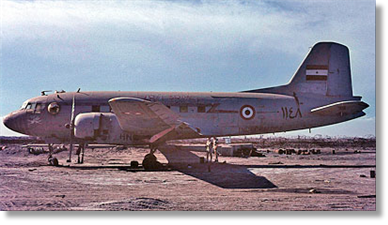
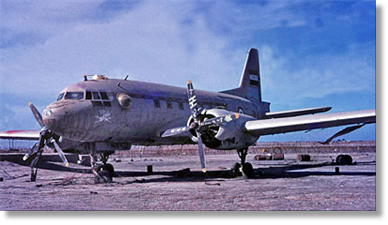
In late 1964, somewhere “up-country”, the aircraft had accidentally landed at one of our forward air bases. Before the pilot realised his mistake and attempted to take off again, one quick-thinking Army captain (think about that: “quick-thinking” and “Army captain” - this is typical blue job’s disdain for brown jobs) drove his Land Rover in front of the aircraft, causing it to abort its take-off. To cut a long story short, the aircraft was brought back to Khormaksar, never flew again and was still there, I hear, when we pulled out in 1967. So that this bit of history does not fade into oblivion, (like the railway story) here is the full story as reported by Peter Pickering’s faithful research and his citation from the “Dhow” newspaper on the next page:

Refuelling
Sometime in 1965, the terrorist threat caused an increase in the amount of personnel sent to combat it. These reinforcements all came in by Air Transport Command aircraft (Britannias mainly) and chartered aircraft. The Supply Wing was also responsible for POL (Petrol, Oil and Lubricants) and this meant our chaps operated the petrol pumps for vehicles and the refuelling bowsers for aircraft. As three shifts were required, I was seconded to POL duties and began to work shifts. This was quite new to me and, in a way, a welcome change. However, you were always within the smell (or stink) of petrol, diesel, AVTAG, AVGAS AVTUR or whatever was at that point of delivery or back in the section building. The smell was everywhere, your body, your clothes, everything. Get some diesel on your good KD and it was ruined. Wearing Bondi boots with their crepe soles was very dangerous as you could slip if you weren’t careful. Most memorable and most scary was when I was on nights and some charter aircraft had to be refuelled. By and large, no big problem, I generally had to do the paperwork and get a receipt for the thousands of gallons we pumped into the aircraft.
Never volunteer!
Usually the bowser driver and the aircraft engineer took care of the refuelling process. On this particular night, however, the engineer of a Super Constellation complained about a back injury and suckered me into doing the actual refuelling. This entailed walking on top of the wing, opening the fuel intake (rather like filling a car), and holding the pistol grip of the fuel line into the tank until it was full. I’m not good at heights at the best of times and I had my Bondi boots on an ideal slide to oblivion, if any fuel spilled onto the wing. I was scared, really. This was something I should not have done and if anything had happened to me, then it would have been my own fault. Soft touch, but there again, I was always willing to help out where I could. Nothing did happen; my guardian angel was up there with me. When I was finished, the flight engineer gave me a fistful of notes and heartfelt gratitude. How much he gave me, I can’t remember – but I did learn a big lesson about volunteering from that episode!
The General Service Medal (GSM)
For simply being there (well, I suppose I did do my bit, however small that may have been), I was entitled to the General Service Medal. Having been in the theatre of operations for at least 30 days, I could have the clasps “Radfan” and “South Arabia”.
The clasp for “Radfan” came with the medal, when it was issued, but you will have noticed, that the clasp “South Arabia” is brand-spanking new. I only claimed it in 2010 ...and yes, I cleaned the medal, prior to my taking its picture for these recollections!
The clasp for “Radfan” came with the medal, when it was issued, but you will have noticed, that the clasp “South Arabia” is brand-spanking new. I only claimed it in 2010 ...and yes, I cleaned the medal, prior to my taking its picture for these recollections!
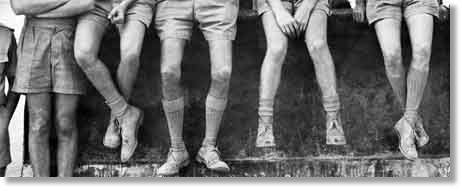
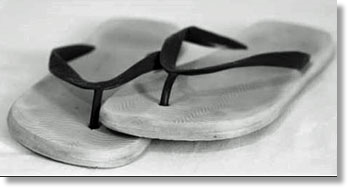
The ubiquitous flip-flops
Here’s a line-up of desert boots. Note that the shorts are definitely not an inch and a half above the knee!
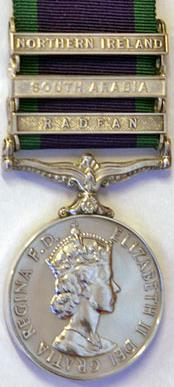
The long road to a commission and goodbye Aden
The long road to a commission and goodbye Aden After quite a bit of consideration and encouragement from my friends, I decided to apply for a commission in the Equipment Branch (as it was called then) and submitted my application in December 1964. Just over a month later in early February 1965, I was recommended to appear before a commissioning board at HQ Middle East Command in Steamer Point. Four weeks later on the 10th March, I was notified that I had been selected to attend the Officers and Aircrew Selection Centre (OASC) at RAF Biggin Hill for the selection process beginning on 5th May 1965. I was also allowed to take 20 days leave after finishing the OASC.
I left Aden on the 1st May and did the 12 hour trip to Lyneham on a Britannia. I duly reported to Biggin Hill on the appointed date and underwent the 3 day selection process, which I found quite interesting. After this was over, I then went home on leave to spend with my family at RAF Headley Court, which gave me a chance to see my still very little brothers and sisters again. At the end of my leave, I had to report to RAF Innsworth to wait until I was allocated a flight back. This took another seven or eight days, mainly hanging about, not knowing if you had to up sticks and away at short notice. So I arrived back around the 10th of June and was met off the aircraft by a mate who worked in Station Headquarters. He told me that I had been selected for officer training. This was indeed great news and I was dying to know when this would take place.
I found out soon enough, that I was to report to the Officer Cadet Training Unit (OCTU) to attend No 183 Officers Initial Course at RAF Feltwell on 10th November 1965. The best news was that I was scheduled to depart Aden on 29th September and was under orders not to report early to RAF Feltwell. This meant in effect, that I had 42 days leave – on top of the 20 I had already had in May – so all was well with my little world. I just had to get through the rest of July, August and September and then goodbye Aden, I hope, forever!
I left Aden on the 1st May and did the 12 hour trip to Lyneham on a Britannia. I duly reported to Biggin Hill on the appointed date and underwent the 3 day selection process, which I found quite interesting. After this was over, I then went home on leave to spend with my family at RAF Headley Court, which gave me a chance to see my still very little brothers and sisters again. At the end of my leave, I had to report to RAF Innsworth to wait until I was allocated a flight back. This took another seven or eight days, mainly hanging about, not knowing if you had to up sticks and away at short notice. So I arrived back around the 10th of June and was met off the aircraft by a mate who worked in Station Headquarters. He told me that I had been selected for officer training. This was indeed great news and I was dying to know when this would take place.
I found out soon enough, that I was to report to the Officer Cadet Training Unit (OCTU) to attend No 183 Officers Initial Course at RAF Feltwell on 10th November 1965. The best news was that I was scheduled to depart Aden on 29th September and was under orders not to report early to RAF Feltwell. This meant in effect, that I had 42 days leave – on top of the 20 I had already had in May – so all was well with my little world. I just had to get through the rest of July, August and September and then goodbye Aden, I hope, forever!
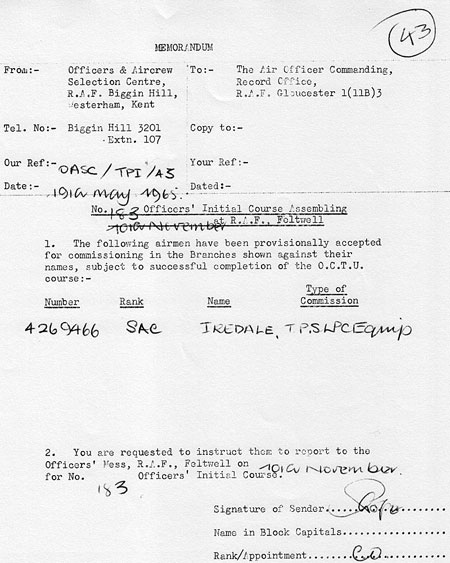
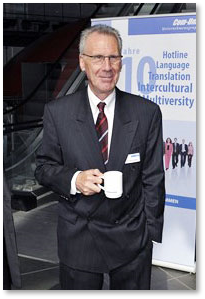
The author - 50 years on
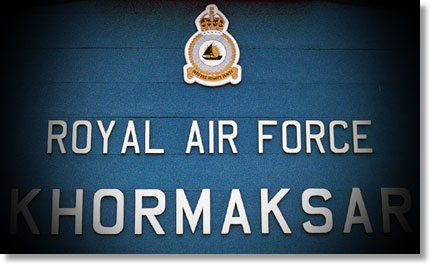
Goodbye Aden!

It was, I suppose, early in 1963 that I found myself clambering aboard a troopship (I think it was the "Nevasa“), as OC RAF en-route for Aden with a party of green young airmen. I use the term advisedly because the Army, always kind to its sister service, had decided to stow them in the pointy bit. Their reasoning became clear as we ploughed through a stormy Bay of Biscay!
I found myself in Aden. Many times in the past I had sailed in and out of the place with its forbidding grey volcanic rock, virtually devoid of greenery. This time I was to stay. Our first view of Aden did not altogether fill us with joy, a first impression which was to prove only too accurate in the years ahead.
The main areas were the port of Steamer Point, Crater, which as its name suggests, was at the core of the extinct volcano and the airfield at Khormaksar some seven miles from Steamer Point. Linked by a causeway was the oil refinery area of Little Aden. Both the Officers’ Mess and Headquarters Middle East Command overlooked Steamer Point.
I booked into the HQ MEC Mess and was duly allocated my cell. As a form of greeting I found myself blasted by a sandstorm which, on later inspection, proved to have found its way even into my drawers, of both varieties!
My working day on the Joint Movements Planning Staff, which had special responsibility for the MAMS Teams, started at seven. This was where we wrote war plans designed to cater for possible eventualities using the forces available in the theatre. There was a simple rule... you write the plan... it happens... you go and do it. This concentrates the mind! We, in this context, were one Wing Commander, one Major, and me. There was no air conditioning and to put it mildly it was hot. The volcanic rock soaked up the heat during the day and pushed it out again at night. The working day ended at one (or thereabouts) whereafter the sensible ones made their way to the Club and bathed both insides and out with suitable liquid.
In due course I was joined by my family and we found ourselves in a hot-box flatlet on 'Murder Mile', aka the Maalla Strait. Our near neighbours were the medicos in their block which was quickly named Bedside Manor. Aden was very inhospitable, even allowing for the various atrocities of the time, and very much a man’s world. Without dwelling on the local situation unduly, mention of the Warrant Officer dragged off a bus and incinerated in front of his family, and the hand grenade thrown onto the veranda of the PMO's house where his daughter was holding a 21st birthday party celebration. We always moved with one eye over the shoulder.
I found myself in Aden. Many times in the past I had sailed in and out of the place with its forbidding grey volcanic rock, virtually devoid of greenery. This time I was to stay. Our first view of Aden did not altogether fill us with joy, a first impression which was to prove only too accurate in the years ahead.
The main areas were the port of Steamer Point, Crater, which as its name suggests, was at the core of the extinct volcano and the airfield at Khormaksar some seven miles from Steamer Point. Linked by a causeway was the oil refinery area of Little Aden. Both the Officers’ Mess and Headquarters Middle East Command overlooked Steamer Point.
I booked into the HQ MEC Mess and was duly allocated my cell. As a form of greeting I found myself blasted by a sandstorm which, on later inspection, proved to have found its way even into my drawers, of both varieties!
My working day on the Joint Movements Planning Staff, which had special responsibility for the MAMS Teams, started at seven. This was where we wrote war plans designed to cater for possible eventualities using the forces available in the theatre. There was a simple rule... you write the plan... it happens... you go and do it. This concentrates the mind! We, in this context, were one Wing Commander, one Major, and me. There was no air conditioning and to put it mildly it was hot. The volcanic rock soaked up the heat during the day and pushed it out again at night. The working day ended at one (or thereabouts) whereafter the sensible ones made their way to the Club and bathed both insides and out with suitable liquid.
In due course I was joined by my family and we found ourselves in a hot-box flatlet on 'Murder Mile', aka the Maalla Strait. Our near neighbours were the medicos in their block which was quickly named Bedside Manor. Aden was very inhospitable, even allowing for the various atrocities of the time, and very much a man’s world. Without dwelling on the local situation unduly, mention of the Warrant Officer dragged off a bus and incinerated in front of his family, and the hand grenade thrown onto the veranda of the PMO's house where his daughter was holding a 21st birthday party celebration. We always moved with one eye over the shoulder.
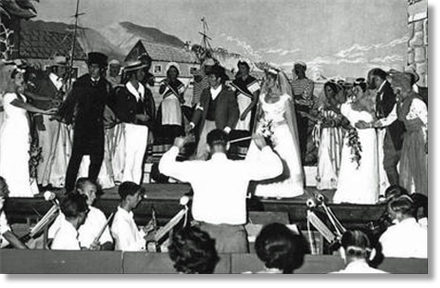
Despite everything we managed to make our own amusement. I had had some experience in Singapore running the Changi Theatre Club and had been headhunted to stage shows in Aden and this we did in the Khormaksar School.
With a company about sixty strong, service, civilian, wives and camp followers we managed to stage three productions in the next three years. All Gilbert and Sullivan, the first was "The Sorcerer" which ran for six nights in November 63.
This was followed in '64 by “Ruddigore" (or “The Witch’s Curse”) and, by courtesy of Bridgit D'Oyly Carte, presented the operetta in its original form using the old F Copy musical scores which she loaned me.
Then, in February 1965, came "The Pirates of Penzance." That's me in the picture at left with the conductor's baton during a dress rehearsal of Pirates. For all these the original costumes were researched, designed and made under the supervision of Maisie Jones, wife of Flt Lt Dave Jones, an Air Mover there.
With a company about sixty strong, service, civilian, wives and camp followers we managed to stage three productions in the next three years. All Gilbert and Sullivan, the first was "The Sorcerer" which ran for six nights in November 63.
This was followed in '64 by “Ruddigore" (or “The Witch’s Curse”) and, by courtesy of Bridgit D'Oyly Carte, presented the operetta in its original form using the old F Copy musical scores which she loaned me.
Then, in February 1965, came "The Pirates of Penzance." That's me in the picture at left with the conductor's baton during a dress rehearsal of Pirates. For all these the original costumes were researched, designed and made under the supervision of Maisie Jones, wife of Flt Lt Dave Jones, an Air Mover there.
During all this time movements experience was at a premium as the Movers, and particularly the MAMS Teams, coped with such things as operations in the Radfan and the deployment of the UK Stategic Reserve and the Beverleys from Bahrain into places such as Kenya, and down into Swaziland and the then Southern Rhodesia. I found myself, and our theatre Mobile Air Movements Team, moving into East Africa.
Don't ask who had the whole of the Reserve chalked up on Nairobi Airport only to be told the winds and thus the fuel loads had changed. And don't ask who stripped the seats out and fitted floor chains. And don't ask who despatched the brutal and licentious sitting on the floors clutching them. Stick us at the pointy end indeed! And don't ask who was met by his Wing Commander late at night on return to Khormaksar after a week without sleep worth talking about with the greeting "Report to my office at seven tomorrow morning to brief me!" Movers were ever resourceful!
Don't ask who had the whole of the Reserve chalked up on Nairobi Airport only to be told the winds and thus the fuel loads had changed. And don't ask who stripped the seats out and fitted floor chains. And don't ask who despatched the brutal and licentious sitting on the floors clutching them. Stick us at the pointy end indeed! And don't ask who was met by his Wing Commander late at night on return to Khormaksar after a week without sleep worth talking about with the greeting "Report to my office at seven tomorrow morning to brief me!" Movers were ever resourceful!

RCAF supports emergency response to wildfires in British Columbia

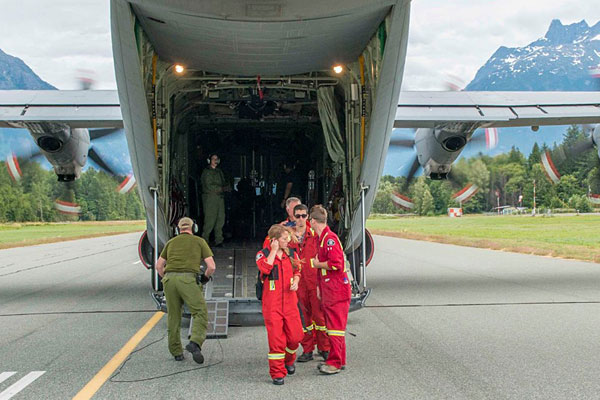
On July 9, 2017, the Canadian Armed Forces (CAF) sent air assets, liaison officers and other personnel to support the ongoing emergency response to the wildfires in British Columbia.
The Royal Canadian Air Force (RCAF) has deployed a CC-177 Globemaster III, a CC-130J Hercules, two CH-147F Chinooks, and three CH-146 Griffons to British Columbia to support the wildfires operations.
The Province of British Columbia requested Government of Canada assistance in the form of RCAF air assets to conduct a variety of tasks, including assisting with the evacuation of the local population affected by the wildfires and assisting the ground operations by providing airlift capacities for first responders and equipment. CAF personnel will not conduct law enforcement or security tasks during their deployment.
The CAF stand ready to provide highly-trained personnel and unique resources tailored to help Canadians during periods of uncertainty and distress following natural disasters.
The Royal Canadian Air Force (RCAF) has deployed a CC-177 Globemaster III, a CC-130J Hercules, two CH-147F Chinooks, and three CH-146 Griffons to British Columbia to support the wildfires operations.
The Province of British Columbia requested Government of Canada assistance in the form of RCAF air assets to conduct a variety of tasks, including assisting with the evacuation of the local population affected by the wildfires and assisting the ground operations by providing airlift capacities for first responders and equipment. CAF personnel will not conduct law enforcement or security tasks during their deployment.
The CAF stand ready to provide highly-trained personnel and unique resources tailored to help Canadians during periods of uncertainty and distress following natural disasters.
“Skilled and dedicated Canadian Armed Forces personnel always stand ready to help fellow Canadians in need,” said Defence Minister Harjit Sajjan.”Partners across the Government of Canada, including the Canadian Armed Forces, will continue to provide support to the province of British Columbia as they fight these wildfires and will continue to do so as long as the need exists.”
Public Safety Canada is responsible for coordinating the Government of Canada emergency response. Canadian Armed Forces personnel are in continuous liaison with public safety, other federal partners, and the province of British Columbia to ensure a synchronized response to situation.
CAF assistance in support of the province of British Columbia’s emergency response is undertaken as part of Operation Lentus, the CAF contingency plan that outlines the joint response to provide support for Humanitarian Assistance and Disaster Response to provincial and territorial authorities in the case of a major natural disaster.
www.skiesmag.com
Public Safety Canada is responsible for coordinating the Government of Canada emergency response. Canadian Armed Forces personnel are in continuous liaison with public safety, other federal partners, and the province of British Columbia to ensure a synchronized response to situation.
CAF assistance in support of the province of British Columbia’s emergency response is undertaken as part of Operation Lentus, the CAF contingency plan that outlines the joint response to provide support for Humanitarian Assistance and Disaster Response to provincial and territorial authorities in the case of a major natural disaster.
www.skiesmag.com

From: Keri Eynon, Thatcham Berks
Subject: Two-Six!
Hi Tony,
Once again thanks for the excellent newsletter; they bring back such fond memories of places and people.
Regarding the use of "Two-Six!" when moving an item. I remember being told by a navy chap that it comes from the days of cannons being fired on ships and every time one was fired it recoiled across the deck and had to be re-positioned at the port hole for the next shot to be fired, obviously after the cannon ball had been rammed down the barrell.
Apparently there were 8 men on each cannon, each with their own particular job when firing. Once the cannon was again ready to be moved back into firing position the numbers 2 and 6 crewmen were called out and it was their job to move the canon back into the firing position - it was easier to call out numbers during battle than names.
Cheers, Keri
Subject: Two-Six!
Hi Tony,
Once again thanks for the excellent newsletter; they bring back such fond memories of places and people.
Regarding the use of "Two-Six!" when moving an item. I remember being told by a navy chap that it comes from the days of cannons being fired on ships and every time one was fired it recoiled across the deck and had to be re-positioned at the port hole for the next shot to be fired, obviously after the cannon ball had been rammed down the barrell.
Apparently there were 8 men on each cannon, each with their own particular job when firing. Once the cannon was again ready to be moved back into firing position the numbers 2 and 6 crewmen were called out and it was their job to move the canon back into the firing position - it was easier to call out numbers during battle than names.
Cheers, Keri
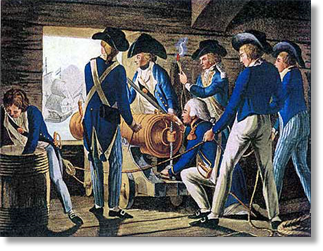
From: John Guy, Northampton
Subject: Two Six
Hi Tony,
Let’s put this subject to bed once & for all. The Royal Navy is the origin of the call two six. It was a call used by a gun crew on a galleon. The cry two six was uttered when the gun was manhandled into, or from a firing position. I’m not sure if the gun orders were from 1-6, or if there were 6 personnel in a gun crew, with numbers 2 & 6 responsible for manhandling the gun. If there is anyone interested enough to trawl the internet they may be able to confirm, whether I am right or wrong!
Regards,
John
Subject: Two Six
Hi Tony,
Let’s put this subject to bed once & for all. The Royal Navy is the origin of the call two six. It was a call used by a gun crew on a galleon. The cry two six was uttered when the gun was manhandled into, or from a firing position. I’m not sure if the gun orders were from 1-6, or if there were 6 personnel in a gun crew, with numbers 2 & 6 responsible for manhandling the gun. If there is anyone interested enough to trawl the internet they may be able to confirm, whether I am right or wrong!
Regards,
John

Bangladesh To Buy Two RAF C130J Transport Planes
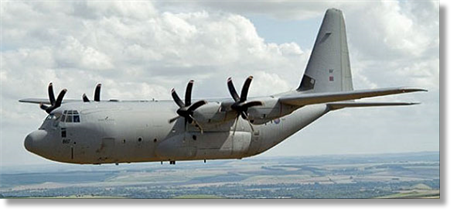
Bangladesh has entered into a Government-to-government deal with the United Kingdom to purchase two C-130J C5 tactical transport aircraft to boost transport capabilities of its air force. Financed under the FY 2017-2018 defense budget, Bangladesh will become the ninth operator of the C-130J C5 in Asia, however, the details are not known yet. Dhaka currently has four Lockheed C-130E Hercules aircraft and two Let L-410 Turbolet Transport aircraft in its transport aircraft fleet.
The C5 variant of the C-130J has been modified and upgraded to include new Allison AE turboprop engines and Dowty Aerospace six-bladed composite propellers. The C-130J is used for tactical operations, parachute insertions and air dispatch of cargo.
The C5 variant of the C-130J has been modified and upgraded to include new Allison AE turboprop engines and Dowty Aerospace six-bladed composite propellers. The C-130J is used for tactical operations, parachute insertions and air dispatch of cargo.
www.defenseworld.net

From: David King, Bury St Edmunds, Suffolk
Subject: Borneo-Newsletter
A comment from David Powell in last month's OBB brought back more memories from Muharrraq of Army personnel due to on-move to Sharjah, Masirah or Salalah arriving with railway warrants. They were always subject to much hilarity and comments about the timing of the next camel train heading down the Gulf!
David
Subject: Borneo-Newsletter
A comment from David Powell in last month's OBB brought back more memories from Muharrraq of Army personnel due to on-move to Sharjah, Masirah or Salalah arriving with railway warrants. They were always subject to much hilarity and comments about the timing of the next camel train heading down the Gulf!
David

2 Air Movements Squadron gets a New Leader
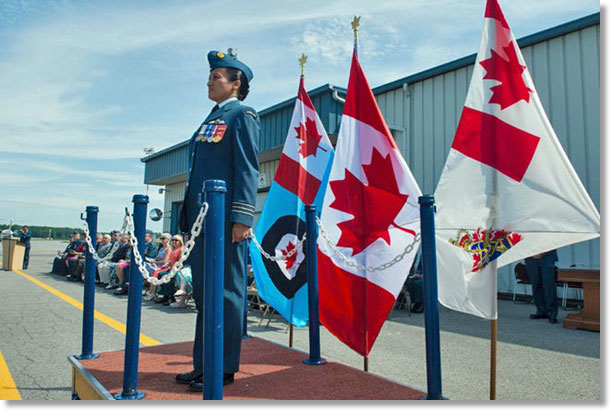
Lieutenant-Colonel Teresa Brown can now add Commanding Officer of CFB Trenton’s 2 Air Movements Squadron to her resume. Brown took over the reins from Lieutenant-Colonel Paul Young at Thursday morning’s Change of Command ceremony outside the base’s passenger terminal.
The squadron, first established in 1951, is responsible for airlift traffic of passengers, freight, mail and other items coming to and from the base. Based on information found on the Royal Canadian Air Force’s (RCAF) government website, the squadron deals with an average of 23 million pounds of freight and 42,000 passengers each year.
Although having never been the Commanding Officer of the aerial-based unit, Brown is no stranger to the squadron or Quinte West. She was first posted to Trenton from 2002 to 2005 when she served as the Cabin Crew Leader with 437 Transport Squadron. Brown also was the Officer Commanding the Transportation and Electrical Mechanical Engineering Squadron in 2007. Now back in the Quinte region, she said she, her husband and children were happy to be back.
inquinte.ca
The squadron, first established in 1951, is responsible for airlift traffic of passengers, freight, mail and other items coming to and from the base. Based on information found on the Royal Canadian Air Force’s (RCAF) government website, the squadron deals with an average of 23 million pounds of freight and 42,000 passengers each year.
Although having never been the Commanding Officer of the aerial-based unit, Brown is no stranger to the squadron or Quinte West. She was first posted to Trenton from 2002 to 2005 when she served as the Cabin Crew Leader with 437 Transport Squadron. Brown also was the Officer Commanding the Transportation and Electrical Mechanical Engineering Squadron in 2007. Now back in the Quinte region, she said she, her husband and children were happy to be back.
inquinte.ca

From: Ian Envis, Crowborough, East Sussex
Subject: Re: UKMAMS OBA OBB #063017
Afternoon Tony,
Apologies for the below being late and not exactly a ''I served in Borneo'' item, however...
With the Brunei Revolt and subsequent actions by Indonesia and riots in Singapore etc., for what became known as the Indonesian Confrontation, the UK moved considerable military forces (aided by the Ozzies and Kiwis) into the forward area resulting in large RAF presence at Kuching etc.
As a schoolboy at RAF Changi Grammar School and living at RAF Seletar (father was SNCO Discip for 389MU), we suddenly found our school holidays in 1964 taking on a new role - digging weapon pits/air raid trenches and sandbag filler-uppers to assist the recently deployed 22nd LAA from BAOR (40mm Bofor guns). The HQ folks in Singapore felt their rapid deployment and lack of acclimatisation would cause lots of heatstroke and the like for some very ''white young conscripts''. The actual troops spent their time setting up the Bofors units and doing training in respect of possible Indonesian attacks.
Subject: Re: UKMAMS OBA OBB #063017
Afternoon Tony,
Apologies for the below being late and not exactly a ''I served in Borneo'' item, however...
With the Brunei Revolt and subsequent actions by Indonesia and riots in Singapore etc., for what became known as the Indonesian Confrontation, the UK moved considerable military forces (aided by the Ozzies and Kiwis) into the forward area resulting in large RAF presence at Kuching etc.
As a schoolboy at RAF Changi Grammar School and living at RAF Seletar (father was SNCO Discip for 389MU), we suddenly found our school holidays in 1964 taking on a new role - digging weapon pits/air raid trenches and sandbag filler-uppers to assist the recently deployed 22nd LAA from BAOR (40mm Bofor guns). The HQ folks in Singapore felt their rapid deployment and lack of acclimatisation would cause lots of heatstroke and the like for some very ''white young conscripts''. The actual troops spent their time setting up the Bofors units and doing training in respect of possible Indonesian attacks.
I do remember the corporals and sergeants from the RAF Regiment and others who were controlling us treated us in a similar vein to those characters on the old TV show, "Get Some In'' i.e. lots of shouting! By the end of our assistance the trenches and sandbags passed muster.
Of course in those days Seletar was home to the Beverleys and Belvederes (later known as Flying Long Houses after deploying to Borneo's numerous bases and I suppose a principle target would have been 389MU, X-Site being the munitions storage MU for all RAF activities).
I suppose being relatively fit and certainly acclimatised we had fun, being fed and watered in the Airman's Mess as our ''inducement'' for services rendered. Not exactly ''war or service'' but part of my experiences of the RAF Far East..
Cheers, Ian
Of course in those days Seletar was home to the Beverleys and Belvederes (later known as Flying Long Houses after deploying to Borneo's numerous bases and I suppose a principle target would have been 389MU, X-Site being the munitions storage MU for all RAF activities).
I suppose being relatively fit and certainly acclimatised we had fun, being fed and watered in the Airman's Mess as our ''inducement'' for services rendered. Not exactly ''war or service'' but part of my experiences of the RAF Far East..
Cheers, Ian

RAF will allow women to fight close combat from September
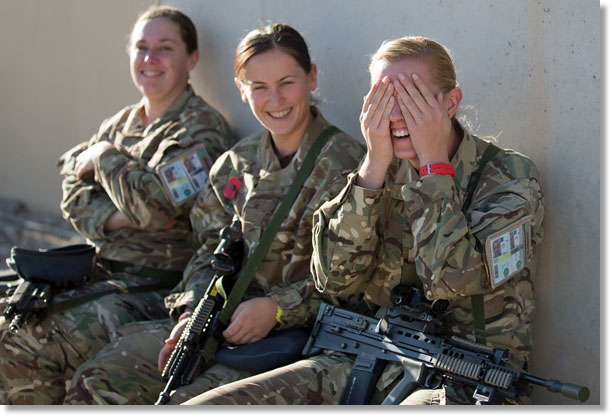
The RAF will allow women to take part in close combat roles in their ground fighting force from September – more than a year ahead of schedule. Recruitment to women was due to open in the RAF Regiment by the end of next year, alongside the Infantry and Royal Marines, but a recent review of work practices found in terms of risks, it was closer to the Royal Armoured Corps, which is already admitting women to its training ranks.
Defence Secretary Sir Michael Fallon declared the move a “defining moment”. Speaking at the annual RAF Air Power Conference in London, he said: “A diverse force is a more operationally effective force. So I’m delighted that the RAF Regiment will be open to recruitment to women from September.
“Individuals who are capable of meeting the standards for the regiment will be given the opportunity to serve, regardless of their gender. Women will be allowed to fight close combat with the RAF Regiment from September [Moody Air Force Base]. This is a defining moment for the RAF as it becomes the first service to have every trade and branch open to both genders.”
Defence Secretary Sir Michael Fallon declared the move a “defining moment”. Speaking at the annual RAF Air Power Conference in London, he said: “A diverse force is a more operationally effective force. So I’m delighted that the RAF Regiment will be open to recruitment to women from September.
“Individuals who are capable of meeting the standards for the regiment will be given the opportunity to serve, regardless of their gender. Women will be allowed to fight close combat with the RAF Regiment from September [Moody Air Force Base]. This is a defining moment for the RAF as it becomes the first service to have every trade and branch open to both genders.”
Chief of the Air Staff, Air Chief Marshal Sir Stephen Hillier, added: “The RAF is committed to providing equal opportunity to all so it’s fantastic to be able to open recruitment to the RAF Regiment to women ahead of schedule. We want the best and most talented individuals to join the Air Force, regardless of their gender, race or background. A diverse force is a more effective force and we need the best people to deliver the important work we do, be it defeating Daesh in Iraq and Syria or protecting Britain’s skies.”
The regiment protects RAF bases, aircraft and equipment at home and abroad.
uk.news.yahoo.com
The regiment protects RAF bases, aircraft and equipment at home and abroad.
uk.news.yahoo.com

From: Len Bowen, Chisholm, ACT
Subject: The RAF in Borneo
Subject: The RAF in Borneo
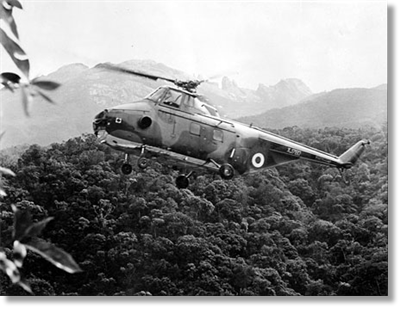
My first Bev AD was with Flight Lieutenant Hugh Crawley, on 29th August, when we dropped 8 x 1 Ton containers of AVTUR at Long Sumado. I say ‘we’ dropped the containers, but I was simply an amazed passenger hanging on for grim death with one hand and wielding my brand new Pentax SV camera with the other while the Air Dispatch boys did their thing.
Sometimes, however, my flying wasn’t a ‘swan’, and they actually made me work for my passage. Though FEAF MAMS had six Teams based at RAF Seletar, in Singapore, it wasn’t worth flying them over for some of the smaller internal troop deployments and redeployments that were necessary from time to time. Hence I was airborne out of Lab on the 29th October 65 for my first, but by no means my last, ‘interesting’ ride in Beverley XH116. I recorded what happened next in the story ‘Oops!’ that I had printed in the ‘Tales’ Column of ‘Australian Aviation’, and subsequently in the Beverly Assn House Magazine ‘MagDrop’.
Sometimes, however, my flying wasn’t a ‘swan’, and they actually made me work for my passage. Though FEAF MAMS had six Teams based at RAF Seletar, in Singapore, it wasn’t worth flying them over for some of the smaller internal troop deployments and redeployments that were necessary from time to time. Hence I was airborne out of Lab on the 29th October 65 for my first, but by no means my last, ‘interesting’ ride in Beverley XH116. I recorded what happened next in the story ‘Oops!’ that I had printed in the ‘Tales’ Column of ‘Australian Aviation’, and subsequently in the Beverly Assn House Magazine ‘MagDrop’.
BORNEO DAYS (DAZE?)
I arrived at RAF Labuan on 4th August 1965, and found that I was working Day On / Day Off with one other DAMO. Because there were few strips on the mainland with lights, and also because of the daily afternoon weather build-up Up Country, there were few after hours movements, and our Day On was generally finished by 1800 – 1830 local time – about beer-o’clock in the Mess before dinner.
I quickly found that the usual Day Off options were: a) lying on the beach; b) sleeping; c) drinking; or, d) a combination of all three. My Scots complexion’s reaction to sun & sand quickly showed me that a) and b) were out, especially when mixed. This in turn eliminated d). c) was fine on occasions, but with One Year Tour even my idiot youth knew that my 20 year-old liver could not hack that mission. So what to do for 24 hours out of every 48? Answer: Go flying! - And I did. On every possible chance I could get, and with every crew that would take me. Later on my interest in, and reasonable skill with firearms saw me flying (highly unofficially) as ‘Safety Pilot’ on 103 and 110 Squadron Whirlwinds, but initially it was as ‘super-cargo’ on 215 Sqn Argosies and 34 Sqn Beverlys, doing air drops (ADs) at such exotic places as Bario, Bakalalan and Pensiangan.
I arrived at RAF Labuan on 4th August 1965, and found that I was working Day On / Day Off with one other DAMO. Because there were few strips on the mainland with lights, and also because of the daily afternoon weather build-up Up Country, there were few after hours movements, and our Day On was generally finished by 1800 – 1830 local time – about beer-o’clock in the Mess before dinner.
I quickly found that the usual Day Off options were: a) lying on the beach; b) sleeping; c) drinking; or, d) a combination of all three. My Scots complexion’s reaction to sun & sand quickly showed me that a) and b) were out, especially when mixed. This in turn eliminated d). c) was fine on occasions, but with One Year Tour even my idiot youth knew that my 20 year-old liver could not hack that mission. So what to do for 24 hours out of every 48? Answer: Go flying! - And I did. On every possible chance I could get, and with every crew that would take me. Later on my interest in, and reasonable skill with firearms saw me flying (highly unofficially) as ‘Safety Pilot’ on 103 and 110 Squadron Whirlwinds, but initially it was as ‘super-cargo’ on 215 Sqn Argosies and 34 Sqn Beverlys, doing air drops (ADs) at such exotic places as Bario, Bakalalan and Pensiangan.
OOPS!
On the 29th we left Labuan for Jesselton (now Kota Kinabalu) to uplift a platoon of Ghurkhas to Tawau and then return to Labuan via Sandakan to drop of a platoon of Royal Malaysian Regiment (RMR) personnel. Yours truly was flying on the task as the Air Movements Officer.
All went well until start-up and taxi at Sandakan. For a number of reasons, not least the late arrival of both our Ghurkha and RMR passengers at their respective enplanement airfields, we were well behind schedule. Though my Log Book only shows a little over two hours flying for the day (in 116), it was mid-afternoon when we left Sandakan - or at least tried to!
There may have been just a little bit of ‘get-home-itis’ around up on the flight deck as we rolled along the unfamiliar taxiway - and ran our port wing tip straight into a power pole-cum-lamp post about 500 yards from the runway threshold; coming to an abrupt and embarrassing halt in a cloud of dust and a shower of sparks!
We had just refuelled, so seeing a sizeable chunk of wing tip hanging off the shorting-out power pole, and not knowing if a fuel tank had been ruptured, we rapidly vacated first the aircraft, then the immediate area.
“Rapidly” may be something of an overstatement, actually, considering that both the Bev’s cockpit and passenger boom were 20+ feet above the ground, and no passenger steps or inter-deck ladders were in place. Nevertheless my Air Movements team certainly would have given the local orang-outangs a good run in the speed and agility stakes that day as we scrambled down the inside of the fuselage and left the aircraft through the nearest door.
After the dust had settled, and no immediate conflagration had occurred, we made our way gingerly back to the poor old Bev. She had lost a sizeable chunk off the port wing tip, the port aileron was bent off the outboard hinge, and, yes, the out-board tank was seeping AVGAS. Clearly 116 wasn’t going anywhere for some time! Nor, with the fuel leak, was anyone keen to reboard the aircraft, crank up the generators and call Labuan to inform them of our predicament. Instead we trooped forlornly back to the huddle of airport buildings. Sandakan was then just a small airport with limited facilities. As we arrived at what passed for a Passenger Terminal we met a small, dapper Anglo-Indian gentleman in an immaculate khaki uniform leaving the building.
On the 29th we left Labuan for Jesselton (now Kota Kinabalu) to uplift a platoon of Ghurkhas to Tawau and then return to Labuan via Sandakan to drop of a platoon of Royal Malaysian Regiment (RMR) personnel. Yours truly was flying on the task as the Air Movements Officer.
All went well until start-up and taxi at Sandakan. For a number of reasons, not least the late arrival of both our Ghurkha and RMR passengers at their respective enplanement airfields, we were well behind schedule. Though my Log Book only shows a little over two hours flying for the day (in 116), it was mid-afternoon when we left Sandakan - or at least tried to!
There may have been just a little bit of ‘get-home-itis’ around up on the flight deck as we rolled along the unfamiliar taxiway - and ran our port wing tip straight into a power pole-cum-lamp post about 500 yards from the runway threshold; coming to an abrupt and embarrassing halt in a cloud of dust and a shower of sparks!
We had just refuelled, so seeing a sizeable chunk of wing tip hanging off the shorting-out power pole, and not knowing if a fuel tank had been ruptured, we rapidly vacated first the aircraft, then the immediate area.
“Rapidly” may be something of an overstatement, actually, considering that both the Bev’s cockpit and passenger boom were 20+ feet above the ground, and no passenger steps or inter-deck ladders were in place. Nevertheless my Air Movements team certainly would have given the local orang-outangs a good run in the speed and agility stakes that day as we scrambled down the inside of the fuselage and left the aircraft through the nearest door.
After the dust had settled, and no immediate conflagration had occurred, we made our way gingerly back to the poor old Bev. She had lost a sizeable chunk off the port wing tip, the port aileron was bent off the outboard hinge, and, yes, the out-board tank was seeping AVGAS. Clearly 116 wasn’t going anywhere for some time! Nor, with the fuel leak, was anyone keen to reboard the aircraft, crank up the generators and call Labuan to inform them of our predicament. Instead we trooped forlornly back to the huddle of airport buildings. Sandakan was then just a small airport with limited facilities. As we arrived at what passed for a Passenger Terminal we met a small, dapper Anglo-Indian gentleman in an immaculate khaki uniform leaving the building.
Aircraft Captain: “Can we use your telephone, please? We’ve got a bit of a problem”.
Airport Official: “Oh dear me no, Sir. We are having no telephone service in the Terminal at this time”. (Peter Sellers would have been proud of the accent!).
Captain: “Can we use the radio in the Tower, then, please? We really need to contact Labuan urgently”.
Official: “I am most exceedingly sorry, Sir, but the Air Traffic Control Tower is having no radio either. Some bloody fool has knocked down a power pole somewhere, and we are having no electricity or telephone whatsoever to the airport”.
We left the Captain to explain the situation, slunk back to 116, where the crew drew lots for who would fire up the system (unfortunate choice of words) and radio Air Headquarters at Lab. We eventually returned home ignominiously in the back of an RMAF Herald much later that night !
BODY HANDLING 101
Airport Official: “Oh dear me no, Sir. We are having no telephone service in the Terminal at this time”. (Peter Sellers would have been proud of the accent!).
Captain: “Can we use the radio in the Tower, then, please? We really need to contact Labuan urgently”.
Official: “I am most exceedingly sorry, Sir, but the Air Traffic Control Tower is having no radio either. Some bloody fool has knocked down a power pole somewhere, and we are having no electricity or telephone whatsoever to the airport”.
We left the Captain to explain the situation, slunk back to 116, where the crew drew lots for who would fire up the system (unfortunate choice of words) and radio Air Headquarters at Lab. We eventually returned home ignominiously in the back of an RMAF Herald much later that night !
BODY HANDLING 101
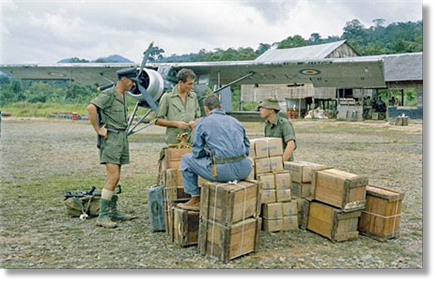
One afternoon early in 1966 we got word that a 209 Sqn Single Pioneer was inbound with a body on board. We thought that this was unusual, as most of the casualties were taken to the much better equipped hospital at Brunei.
While we were pondering the matter, a Malaysian Army ambulance and a Malaysian Army Land Rover arrived at the AMS building. A young Malaysian Army Captain comes in and introduces himself. Apparently the in-bound body was a senior Malaysian officer who has died, not of a war wound but of a brain hemorrhage.
He was - or rather had been - a very strict Muslim, and was being brought back to Labuan for burial within the required 24 hour period after death. The young Captain was there to meet the aircraft and conduct the body for immediate burial.
While we were pondering the matter, a Malaysian Army ambulance and a Malaysian Army Land Rover arrived at the AMS building. A young Malaysian Army Captain comes in and introduces himself. Apparently the in-bound body was a senior Malaysian officer who has died, not of a war wound but of a brain hemorrhage.
He was - or rather had been - a very strict Muslim, and was being brought back to Labuan for burial within the required 24 hour period after death. The young Captain was there to meet the aircraft and conduct the body for immediate burial.
OK, no problem, so we go out to meet the aircraft. Now if you have ever handled a stretcher into or out of a Single Pin, you will know that this is a bit of a juggling act. The port rear seat was removed and the stretcher fed down behind the aircraft captain's seat, with the feet (usually) diagonally down into the rear fuselage. When we got to the aircraft, the position was reversed, and the head of the casualty was 'down hill' in the back.
The ambulance backed up to the aircraft and we looked at the problem. While the body was well secured - we thought - to the stretcher, it was just wound in what appeared to be couple of white bed-sheets. No body bag, no heavy wrapping, no nothing. OK, as the Duty MOVO I took the up-hill end of the stretcher and one of my AMS lads worked inside the aircraft to move the litter up and out. The pilot had disappeared, and as soon as the smell hit us I knew why.
OK again, I had been directly involved in the clear-up of the Hastings crash near Abingdon before I left UK, so nothing could or should phase me (oh yeah?). We started to manoeuvre the stretcher out of the aircraft and the young Malaysian Captain stepped forward to take the weight of the head end. Just as the stretcher came clear of the aircraft, the sheets round the casualty's head fell back, and exposed the face and head. Yes, the brain hemorrhage had been confirmed by a ragged removal of the top of the skull, which had then been roughly held back in place by a couple of turns of field dressing bandage. Needless to say there had been some significant leakage, and the deceased looked like something out of a 'Walking Dead' movie (had we had them back then).
At this point the Captain left us in a dead faint, falling backwards onto the tarmac, and the body started to fall, not just out of the aircraft but also out of the stretcher. Now I knew even then that after death a Muslim’s body was not supposed to touch the earth without the proper burial ceremony, and if it did so, it should be interred where it fell. My AMS Sergeant, Nobby Clark, saved the day by executing an immaculate slip catch of the body's shoulders about 18" off the ground and then flick-passed his hold to two of the Malaysian MedOrds who were with the ambulance. Meanwhile I had relinquished hold of 'my' end of the now-redundant stretcher, and had grabbed the body's feet instead. Together we got the deceased onto one of the ambulance's litters and safely into the vehicle.
Crisis over we looked at the young Captain... who had cracked HIS head on the tarmac and was bleeding like a stuck ....err .... sheep. He, too was quickly loaded into the ambulance on the other side of the vehicle, and 'escort' and deceased departed the RAF Labuan tarmac as both religious requirements and protocol dictated .... though I'm not sure that the young Captain, or his immediate superiors, would have agreed.
The ambulance backed up to the aircraft and we looked at the problem. While the body was well secured - we thought - to the stretcher, it was just wound in what appeared to be couple of white bed-sheets. No body bag, no heavy wrapping, no nothing. OK, as the Duty MOVO I took the up-hill end of the stretcher and one of my AMS lads worked inside the aircraft to move the litter up and out. The pilot had disappeared, and as soon as the smell hit us I knew why.
OK again, I had been directly involved in the clear-up of the Hastings crash near Abingdon before I left UK, so nothing could or should phase me (oh yeah?). We started to manoeuvre the stretcher out of the aircraft and the young Malaysian Captain stepped forward to take the weight of the head end. Just as the stretcher came clear of the aircraft, the sheets round the casualty's head fell back, and exposed the face and head. Yes, the brain hemorrhage had been confirmed by a ragged removal of the top of the skull, which had then been roughly held back in place by a couple of turns of field dressing bandage. Needless to say there had been some significant leakage, and the deceased looked like something out of a 'Walking Dead' movie (had we had them back then).
At this point the Captain left us in a dead faint, falling backwards onto the tarmac, and the body started to fall, not just out of the aircraft but also out of the stretcher. Now I knew even then that after death a Muslim’s body was not supposed to touch the earth without the proper burial ceremony, and if it did so, it should be interred where it fell. My AMS Sergeant, Nobby Clark, saved the day by executing an immaculate slip catch of the body's shoulders about 18" off the ground and then flick-passed his hold to two of the Malaysian MedOrds who were with the ambulance. Meanwhile I had relinquished hold of 'my' end of the now-redundant stretcher, and had grabbed the body's feet instead. Together we got the deceased onto one of the ambulance's litters and safely into the vehicle.
Crisis over we looked at the young Captain... who had cracked HIS head on the tarmac and was bleeding like a stuck ....err .... sheep. He, too was quickly loaded into the ambulance on the other side of the vehicle, and 'escort' and deceased departed the RAF Labuan tarmac as both religious requirements and protocol dictated .... though I'm not sure that the young Captain, or his immediate superiors, would have agreed.
By early 1966 I knew that my request to extend my tour in the Far East, with two years on MAMS had been approved. Accordingly when my fortnights’ mid-tour leave came due, I didn’t feel inclined to do what most ‘One Year’ blokes did - head for Singapore or ‘Honkers’ and blow all their Overseas Allowance savings on booze, women, cameras or stereos – or all four if they has been real ‘Posbie’ during the preceding months.
Instead I booked a slow boat to China – or rather Singapore. I’d always loved Joseph Conrad’s novels about the South China Sea, so I bought a passage from Labuan to Singapore on one of the Borneo Steamship Company’s coasters, calling at every little port along the Sabah and Sarawak coast. It was a memorable experience, and the smell of raw latex and mangroves still brings back fond memories – but that’s another story.
Before embarking on the MV ‘Rajah Brook’, however, I had a week’s leave to kill. Accordingly I managed to wangle a few day up-country, at Sepulot, where I could get in a bit of chopper flying and shooting.
IF CHOOKS COULD FLY
One of the highlights of most days at Splot was watching the Bev airdrop. The size of the DZ on the strip was such that only two x 1 Ton Container could be delivered at once. If we were to receive a full load, usually AVTUR, at four 44 gallon drums per Container, we were treated to four separate passes, with two Contained dropped on each pass. About my second or third day at ‘Splot’, we were idly watching the drop from the veranda of the basha that acted as the Officers’/Sergeants’ Mess, when somebody with better eyes than myself said, “What are those little puffs of smoke behind the Bev?”
We knew it couldn’t be Indon anti-aircraft fire, as the presence of a Company of Gurkhas at Splot ensured that there wasn’t an Indon within 50 miles of the place – at least not one with both ears still in their pre-ordained location! So what were the small puffs of ‘smoke’ that accompanied the appearance of each Container out of the back of the Bev? One of the blokes disappeared back into the basha and reappeared with a pair of binoculars. He watched intently as the Bev circled the DZ and made its next run – then dissolved into near-hysterical laughter! The bloke next to him grabbed the binoculars, then joined him in hilarity as the next drop occurred. Both were laughing too much to clearly explain what was happening, but we caught the odd strangled words such as “chickens” and “lowest tenders”.
Instead I booked a slow boat to China – or rather Singapore. I’d always loved Joseph Conrad’s novels about the South China Sea, so I bought a passage from Labuan to Singapore on one of the Borneo Steamship Company’s coasters, calling at every little port along the Sabah and Sarawak coast. It was a memorable experience, and the smell of raw latex and mangroves still brings back fond memories – but that’s another story.
Before embarking on the MV ‘Rajah Brook’, however, I had a week’s leave to kill. Accordingly I managed to wangle a few day up-country, at Sepulot, where I could get in a bit of chopper flying and shooting.
IF CHOOKS COULD FLY
One of the highlights of most days at Splot was watching the Bev airdrop. The size of the DZ on the strip was such that only two x 1 Ton Container could be delivered at once. If we were to receive a full load, usually AVTUR, at four 44 gallon drums per Container, we were treated to four separate passes, with two Contained dropped on each pass. About my second or third day at ‘Splot’, we were idly watching the drop from the veranda of the basha that acted as the Officers’/Sergeants’ Mess, when somebody with better eyes than myself said, “What are those little puffs of smoke behind the Bev?”
We knew it couldn’t be Indon anti-aircraft fire, as the presence of a Company of Gurkhas at Splot ensured that there wasn’t an Indon within 50 miles of the place – at least not one with both ears still in their pre-ordained location! So what were the small puffs of ‘smoke’ that accompanied the appearance of each Container out of the back of the Bev? One of the blokes disappeared back into the basha and reappeared with a pair of binoculars. He watched intently as the Bev circled the DZ and made its next run – then dissolved into near-hysterical laughter! The bloke next to him grabbed the binoculars, then joined him in hilarity as the next drop occurred. Both were laughing too much to clearly explain what was happening, but we caught the odd strangled words such as “chickens” and “lowest tenders”.
It was my turn with the binoculars for the next pass, and all was revealed. The Gurkhas liked their rations fresh, and some bright spark back at Labuan had decided to strap a cage of live chickens onto the top of the AVTUR drums on each Container. Unfortunately the cages were locally produced, obviously of the cheapest material possible – hence the “lowest tender” comment – and the shock of the static line on the Container’s web harness was breaking open the cages just as the ‘chute deployed. This in turn was liberating the chickens – at about 130 knots and 500 feet AGL.
This is not a natural environment for a kampong-raised chook, and their predicament was made worse by them being almost completely and instantaneously plucked by the slipstream; hence the puff of ‘smoke’ – or rather feathers – as each container left the aircraft!
As far as I could see through the binoculars, once liberated, the chooks would try one or two vain beats of their now largely-featherless wings, then, with a metaphorical shrug, bow to the inevitable and go into free fall. Their impact with the ground was spectacular, but somewhat messy. Some bounced like footballs, but most simply went splat – or rather splot! By the time the AD was over, the DZ and the surrounding area was littered with sorry little piles of minced chicken.
That evening we were invited to dine with the Gurkha officers – on chicken curry. In the absence of a major refrigeration facility at Sepulot, and the weeks’ worth of the Company’s fresh rations having been dead on arrival, there was no alternative but to consume the lot immediately. The evening was somewhat marred by the necessity to pick slivers of shattered chicken bone out of each mouthful of curry.
Fortunately, the Company Commander Major didn’t hold the RAF responsible for the debacle. The loads were rigged, loaded and dispatched by Royal Army Service Corps personnel, the Air Force only provided the delivery platform – and at least 75% of the chickens had in fact landed on the DZ. Only the few retaining some flight feathers has ‘spun out’ into the surrounding ulu, so the Bev crew at least were ‘on the ball’.
I believe that the delivery of ‘live’ chooks in this way was suspended immediately, and the RASC proponent of the idea was invited to ‘morning tea’ by the Colonel of the Ghurkha Regiment – but was not offered any chicken sandwiches.
This is not a natural environment for a kampong-raised chook, and their predicament was made worse by them being almost completely and instantaneously plucked by the slipstream; hence the puff of ‘smoke’ – or rather feathers – as each container left the aircraft!
As far as I could see through the binoculars, once liberated, the chooks would try one or two vain beats of their now largely-featherless wings, then, with a metaphorical shrug, bow to the inevitable and go into free fall. Their impact with the ground was spectacular, but somewhat messy. Some bounced like footballs, but most simply went splat – or rather splot! By the time the AD was over, the DZ and the surrounding area was littered with sorry little piles of minced chicken.
That evening we were invited to dine with the Gurkha officers – on chicken curry. In the absence of a major refrigeration facility at Sepulot, and the weeks’ worth of the Company’s fresh rations having been dead on arrival, there was no alternative but to consume the lot immediately. The evening was somewhat marred by the necessity to pick slivers of shattered chicken bone out of each mouthful of curry.
Fortunately, the Company Commander Major didn’t hold the RAF responsible for the debacle. The loads were rigged, loaded and dispatched by Royal Army Service Corps personnel, the Air Force only provided the delivery platform – and at least 75% of the chickens had in fact landed on the DZ. Only the few retaining some flight feathers has ‘spun out’ into the surrounding ulu, so the Bev crew at least were ‘on the ball’.
I believe that the delivery of ‘live’ chooks in this way was suspended immediately, and the RASC proponent of the idea was invited to ‘morning tea’ by the Colonel of the Ghurkha Regiment – but was not offered any chicken sandwiches.
Had a ride in a Shackleton Mk 2 from Lab in January 1966. Eight hour patrol round the North Borneo coast watching/searching for Indon gun runners. About an hour into the sortie a clipboard came round asking for meal options e.g. "How do you like your steak? With or without chips / mushrooms / peas" etc. Thought that this was a 'take the piss out of the young Plt Off MOVO' and when he opts for a full steak dinner, serve him up the usual Lab in-flight tired sandwiches and over-ripe fruit.
Oh how wrong I was. I had forgotten that the Shack boys did their own rationing out of Changi, and I had my first real rare steak with all the trimmings for five months! Food at Lab wasn't too bad, but steak that hadn't had its origins in a kampong water buffalo --- or at least tasted and chewed that way --- just didn't happen. Should have remembered Dad's tales of WWII Kipper Fleet with the galleys on Sunderlands and Catalinas, and full cooked meal 12 - 18 hours into a North Atlantic mission.
………………………………………………
Oh how wrong I was. I had forgotten that the Shack boys did their own rationing out of Changi, and I had my first real rare steak with all the trimmings for five months! Food at Lab wasn't too bad, but steak that hadn't had its origins in a kampong water buffalo --- or at least tasted and chewed that way --- just didn't happen. Should have remembered Dad's tales of WWII Kipper Fleet with the galleys on Sunderlands and Catalinas, and full cooked meal 12 - 18 hours into a North Atlantic mission.
………………………………………………
HOW DO YOU LIKE YOUR STEAK?
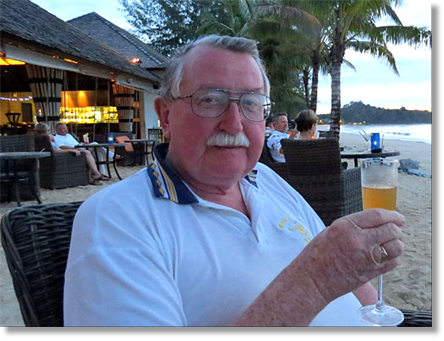
On 30 July 1965, I flew out of Labuan on Argosy XC496, ‘Tour-X’ in Borneo. ‘Confrontation’ was over; what the late Neil Davies, the famous Australian war cameraman, called “The last of the gentlemen’s wars” was over, and we felt justifiably proud of ourselves.
I joined FEAF MAMS with enthusiasm and anticipation – mainly anticipation of spending a lot of time in the back of Beverleys over the next two years!
I joined FEAF MAMS with enthusiasm and anticipation – mainly anticipation of spending a lot of time in the back of Beverleys over the next two years!
Len Bowen
Canberra
July 2017
Canberra
July 2017

Memories of Aden
British Forces Aden was originally formed as Aden Command in 1928. On its establishment, Aden Command was a Royal Air Force (RAF) command which was responsible for the control of all British armed forces in the Protectorate.
It was renamed British Forces in Aden, or simply British Forces Aden, in 1936 and renamed again in 1956 as British Forces Arabian Peninsula. In 1959 Middle East Command was divided into two commands split by the Suez canal.
The two parts were British Forces Arabian Peninsular, which was based at Aden, and the rump of Middle East Command which was based in Cyprus and which on 1 March 1961 was renamed Near East Command.
In 1961 the command was renamed, again, this time as Middle East Command (Aden). In 1967, following the British withdrawal from Aden at the end of the Emergency, the remaining British Forces in the Arabian Peninsula, including units at Salalah and Masirah, were reorganized under Headquarters British Forces Gulf, which was based at RAF Muharraq in Bahrain.
It was renamed British Forces in Aden, or simply British Forces Aden, in 1936 and renamed again in 1956 as British Forces Arabian Peninsula. In 1959 Middle East Command was divided into two commands split by the Suez canal.
The two parts were British Forces Arabian Peninsular, which was based at Aden, and the rump of Middle East Command which was based in Cyprus and which on 1 March 1961 was renamed Near East Command.
In 1961 the command was renamed, again, this time as Middle East Command (Aden). In 1967, following the British withdrawal from Aden at the end of the Emergency, the remaining British Forces in the Arabian Peninsula, including units at Salalah and Masirah, were reorganized under Headquarters British Forces Gulf, which was based at RAF Muharraq in Bahrain.
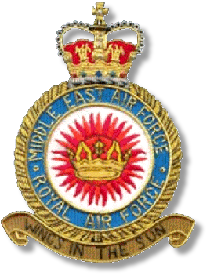

Lieutenant-Colonel "Mad Mitch" Mitchell
Lieutenant-Colonel Colin Campbell Mitchell (17 November 1925 – 20 July 1996) was a British Army lieutenant-colonel and politician. He became famous in July 1967 when he led the Argyll and Sutherland Highlanders in the British reoccupation of the Crater district of Aden. At that time, Aden was a British colony and the Crater district had briefly been taken over by nationalist insurgents. Mitchell became widely known as “Mad Mitch”. His reoccupation of the Crater became known as "the Last Battle of the British Empire". Although some observers questioned whether the Last Battle was ever worth fighting, the event marked the end of an era in British history and made Mitchell an iconic figure.
After leaving the British Army in 1968, Mitchell embarked on a career in politics. He was elected as a Member of the British Parliament in 1970 but stood down at the February 1974 general election. After subsequent involvement in a failed business venture he made his living until 1989 as a military consultant. From 1989 until his death in 1996 he managed a charitable trust involved in the removal of land mines from former war zones.
After leaving the British Army in 1968, Mitchell embarked on a career in politics. He was elected as a Member of the British Parliament in 1970 but stood down at the February 1974 general election. After subsequent involvement in a failed business venture he made his living until 1989 as a military consultant. From 1989 until his death in 1996 he managed a charitable trust involved in the removal of land mines from former war zones.
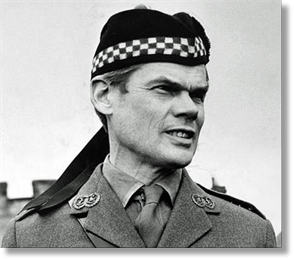
Recommended - watch "Mad Mitch and his Tribal Laws" https://www.youtube.com/watch?v=R6OOsoqSKaw

From: Phil Smith, Exmouth, Devon
Subject: Memories of Aden
Tony,
During 1967 both my father, Maj (QM) Ron Smith MBE, and I were stationed in Aden. I was at RAF Steamer Point and he was based at Waterloo Lines and of course, being in the Argyll and Sutherland Highlanders, latterly in Crater. I had volunteered for the emergency draft while at RAF Kinloss thinking I would not get a suntan in the north of Scotland at that time of year, but I would in Aden (18 years of age at that time and very stupid!).
Subject: Memories of Aden
Tony,
During 1967 both my father, Maj (QM) Ron Smith MBE, and I were stationed in Aden. I was at RAF Steamer Point and he was based at Waterloo Lines and of course, being in the Argyll and Sutherland Highlanders, latterly in Crater. I had volunteered for the emergency draft while at RAF Kinloss thinking I would not get a suntan in the north of Scotland at that time of year, but I would in Aden (18 years of age at that time and very stupid!).
Mad Mitch - my Dad is over his right shoulder
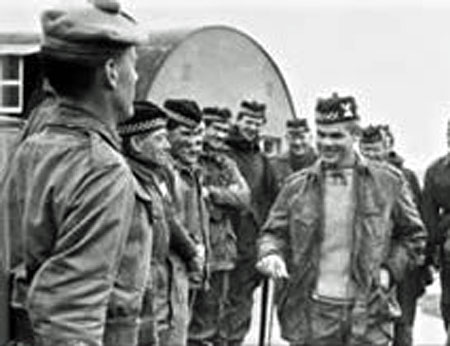
I remember vividly how my father would arrive at the Supply Squadron, Steamer Point, complete with his 10 man escort, armed to the teeth, to whisk me away for a tour of Crater.
Their landrovers did not have doors or roofs on to facilitate a rapid exit if required. It was a hell of a sight to see them arrive and jump out of the vehicles and take up defensive positions outside the Receipt and Despatch Section. They really seemed the real deal compared to RAF blokes dressed in KD that did not fit and wearing black leather shoes in 100 degrees of heat!
My mother was not too impressed when she found out her husband was dragging her son into a very dangerous situation unnecessarily. After all, RAF blokes only received a days' Ground Defence Training which did not include a visit to a very dangerous place!
Crater was the chosen base in Aden for nationalist insurgents, due to the narrow streets and Mosques used to conceal themselves in. The Argylls were not allowed to enter any Mosque without the Aden Police entering first. The problem was that the Police were just as bad as the terrorists, being responsible for a number of British servicemen's deaths.
Their landrovers did not have doors or roofs on to facilitate a rapid exit if required. It was a hell of a sight to see them arrive and jump out of the vehicles and take up defensive positions outside the Receipt and Despatch Section. They really seemed the real deal compared to RAF blokes dressed in KD that did not fit and wearing black leather shoes in 100 degrees of heat!
My mother was not too impressed when she found out her husband was dragging her son into a very dangerous situation unnecessarily. After all, RAF blokes only received a days' Ground Defence Training which did not include a visit to a very dangerous place!
Crater was the chosen base in Aden for nationalist insurgents, due to the narrow streets and Mosques used to conceal themselves in. The Argylls were not allowed to enter any Mosque without the Aden Police entering first. The problem was that the Police were just as bad as the terrorists, being responsible for a number of British servicemen's deaths.
Lt Col Mitchell was an iconic figure. When based at Waterloo Lines, British Intelligence informed him terrorist and indeed mercenaries operated from Crater as there was no British presence in the city. Mad Mitch informed his superiors that a presence was indeed necessary to stop British servicemen being killed. He was informed to do as he was told and not to occupy the area. He refused and promptly invaded. He basically defied the British Government. From that point on his long term Army career was, in effect, over.
The British people and the British press loved him; the British Government did not. His actions were completely justified as post Crater occupation British casualties were minimal compared to the period before.
Defence cuts were announced just after the Argylls returned to Seaton Barracks in Plymouth with the Regiment being top of the list. A Battalion Commander would receive a DSO after a campaign like Aden. He and my father were Mentioned in Despatches for Distinguished Conduct. Colin Mitchell left the Army in 1968 without being promoted, having trod on too many toes. He entered politics as a Tory MP from 1970 to 1974.
He left the Government for a well paid job in the private sector stating "he could not afford to be an MP". That statement came back to haunt him as the job fell through and he spent the next 10 years attempting to get back into politics, unsuccessfully. He found himself unemployed at times and dissatisfied with his situation. He died in 1996 after a short illness. His family have never disclosed the nature of that illness.
The British people and the British press loved him; the British Government did not. His actions were completely justified as post Crater occupation British casualties were minimal compared to the period before.
Defence cuts were announced just after the Argylls returned to Seaton Barracks in Plymouth with the Regiment being top of the list. A Battalion Commander would receive a DSO after a campaign like Aden. He and my father were Mentioned in Despatches for Distinguished Conduct. Colin Mitchell left the Army in 1968 without being promoted, having trod on too many toes. He entered politics as a Tory MP from 1970 to 1974.
He left the Government for a well paid job in the private sector stating "he could not afford to be an MP". That statement came back to haunt him as the job fell through and he spent the next 10 years attempting to get back into politics, unsuccessfully. He found himself unemployed at times and dissatisfied with his situation. He died in 1996 after a short illness. His family have never disclosed the nature of that illness.
ADEN
By the late Sqn Ldr Jack Riley RAF
By the late Sqn Ldr Jack Riley RAF

From: Alexander Angus, Kippax, Yorkshire
Subject: Memories of Aden
Subject: Memories of Aden
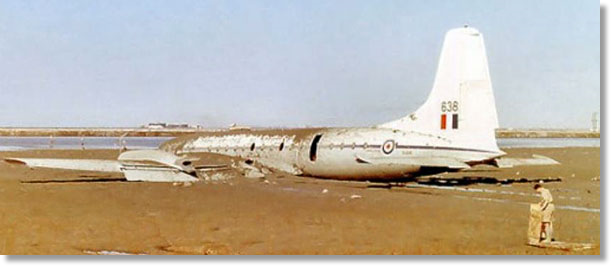
Where to begin? There are so many memories, although 50 years on some details are sketchy. The most prominent memory is of the Britannia that didn't stop at the end of the runway.
Two of us were sent to retrieve the diplomatic mail, and although duckboards (of a sort) were put down, somehow the mud reached half way to the knee, and did it stink! After we had retrieved the mail, the DAMO wouldn't let us anywhere near the Land Rover, so we set off walking back to the Movements Section.
There's more to come though. We were halfway back and the boss came out again. "You'll have to go back out there - someone is missing, go have a look."
Two of us were sent to retrieve the diplomatic mail, and although duckboards (of a sort) were put down, somehow the mud reached half way to the knee, and did it stink! After we had retrieved the mail, the DAMO wouldn't let us anywhere near the Land Rover, so we set off walking back to the Movements Section.
There's more to come though. We were halfway back and the boss came out again. "You'll have to go back out there - someone is missing, go have a look."
We really weren't in the mood for finding a corpse, still, back through that foul stench with torches, thankfully turned up no one. It transpired that the missing pillock was knocking whiskies back in the comfort of Neddies bar. I wish I could remember who else endured that little jaunt.
I also remember the one time it rained while we there in '67. It started to pour during the last hour of our night on D shift. Couldn't sleep, had to watch it all day, how very sad - memories of home I suppose.
I have loads of other memories, best not prattle on though. Anyway, great to read all the correspondence that you put out for us all, keep the faith.
Regards, Alex
I also remember the one time it rained while we there in '67. It started to pour during the last hour of our night on D shift. Couldn't sleep, had to watch it all day, how very sad - memories of home I suppose.
I have loads of other memories, best not prattle on though. Anyway, great to read all the correspondence that you put out for us all, keep the faith.
Regards, Alex

From: Fred Martin, Godalming, Surrey
Subject: Memories of Aden
Hi Tony, just one of my many "Memories of Aden "
It was late 1961, I was an 18 year old LAC Air Movements Clerk, I had been posted to Aden straight from Movements School Kidbrooke, having gone there after square bashing at Bridgnorth. My total RAF service at that point was about 9 months. We had been exempted guard duty for the first couple of months as the big 1961 Kuwait pull out had meant we were working 12 hours on 12 hours off shifts, 7 days a week, for my first 2 months at Khormaksar.
With that shout over, Air Movements staff had to take their turn to guard the airfield at night. Although the colony was relatively quiet at that time, the powers that be decided that armed guards should be mounted on the airfield. We were sent out in pairs with a torch, whistle, an ammo belt with 50 rounds and the almost obsolete Lee Enfield rifle. We were told we were not to open fire unless our lives were directly threatened or RAF property was being damaged!
Subject: Memories of Aden
Hi Tony, just one of my many "Memories of Aden "
It was late 1961, I was an 18 year old LAC Air Movements Clerk, I had been posted to Aden straight from Movements School Kidbrooke, having gone there after square bashing at Bridgnorth. My total RAF service at that point was about 9 months. We had been exempted guard duty for the first couple of months as the big 1961 Kuwait pull out had meant we were working 12 hours on 12 hours off shifts, 7 days a week, for my first 2 months at Khormaksar.
With that shout over, Air Movements staff had to take their turn to guard the airfield at night. Although the colony was relatively quiet at that time, the powers that be decided that armed guards should be mounted on the airfield. We were sent out in pairs with a torch, whistle, an ammo belt with 50 rounds and the almost obsolete Lee Enfield rifle. We were told we were not to open fire unless our lives were directly threatened or RAF property was being damaged!
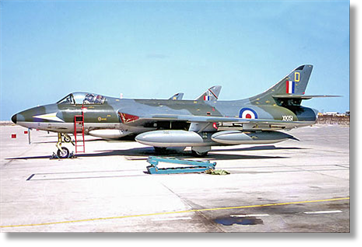
My colleague and myself were wandering around amongst rows of parked Hawker Hunters feeling totally bored and dreaming of home. Nothing was going to happen was it? Suddenly we heard a noise and saw a shadowy figure moving close to one of the aircraft. Bloody hell, what do we do now? We're RAF clerks not infantrymen! We gave the standard challenge in Arabic as we had been told . No response. We gave a second challenge. Still no response. Now this was getting serious, the criteria to open fire had not been met, a thousand thoughts went through my mind in a matter of seconds, we both put one "up the spout".
The mysterious figure suddenly shouted, "Don't shoot, me Chowkidar He was a uniformed Arab civilian guard who had probably fallen asleep under the wing of a Hunter and woke up when he heard us approaching.
I have reflected on that incident many times in the past 56 years and asked myself "would I have opened fire had the criteria been met?" My conclusion was that as an 18 year old keen young serviceman I probably would have. I now thank God I never had to make that decision.
Thanks for all you do for this site, Tony
Best regards, Fred Martin
The mysterious figure suddenly shouted, "Don't shoot, me Chowkidar He was a uniformed Arab civilian guard who had probably fallen asleep under the wing of a Hunter and woke up when he heard us approaching.
I have reflected on that incident many times in the past 56 years and asked myself "would I have opened fire had the criteria been met?" My conclusion was that as an 18 year old keen young serviceman I probably would have. I now thank God I never had to make that decision.
Thanks for all you do for this site, Tony
Best regards, Fred Martin

From: David King, Bury St Edmunds, Suffolk
Subject: Memories of Aden
In mid-November 1967, I took party of 18 Suppliers to RAF Sharjah to assist in unloading ships and aircraft with equipment from Aden, prior to it being closed down.
We got a flight in an empty Hercules, ostensibly, to help Movers in Aden in the wrapping up. At Kormaksar, while wandering around looking at the deserted camp, I was approached by a local dohbi-wallah with a list of customers; Dick Turpin, Robin Hood and Robin Bastard, to name just a few. Did I know where they were?
Cheers, David
Subject: Memories of Aden
In mid-November 1967, I took party of 18 Suppliers to RAF Sharjah to assist in unloading ships and aircraft with equipment from Aden, prior to it being closed down.
We got a flight in an empty Hercules, ostensibly, to help Movers in Aden in the wrapping up. At Kormaksar, while wandering around looking at the deserted camp, I was approached by a local dohbi-wallah with a list of customers; Dick Turpin, Robin Hood and Robin Bastard, to name just a few. Did I know where they were?
Cheers, David
From: John Anderson, Darlington, County Durham
Subject: Memories of Aden
In 1967, as a young 19 year old SAC, I was posted to Khormaksar not actually knowing where it was on the map, or knowing what it was all about. I soon found out though. Within two days of landing I was on my first 24 hour guard shift with my .303 and five rounds. There was gunfire on the causeway that night and it focused my mind I can tell you. The tracers were going nowhere near me, but I hunkered down behind the wheels of a Beverley until it stopped.
I was to work in SCAF on the Hunter demands desk and it wasn’t too bad because there was the luxury of air conditioning. I had met up with a few of my 50th Entry mates and we got into a regular pattern of “beer meetings” in the Camel Club. My memory fails me, but I can remember Bob Chadwick, John Calvert (mad or what!), and a few others. Enough of us to be hosted in the Sergeants Mess (back patio) by our old DI from Hereford, Terry Graham. He was now a sergeant and running the bedding store. What a great guy he was and tended to “father” us, making sure we were back over the wall and scurrying down the storm drains back to our billets to avoid the curfew.
After three months or so of guard, work, guard, work, my desk was closed down because the Hawker Hunters had flown out. I moved to Inventories. What a bummer of a job and I wasn’t welcomed as the civilians working there thought I was going to take over their jobs. In fact after just one week I had had enough and Bob (he had been shoved in there as well) and I hatched a plan. There was no work for us in there so we told the civvy in charge we were off back to SCAF. From that point on we used to walk through SCAF each morning so that W.O. Golding could see us, on our way supposedly to Sec. Accts. We then hot footed it back to our billet, into swimming gear, onto the bus for Steamer Point which left at 8am, and spent the day on the beach.
Subject: Memories of Aden
In 1967, as a young 19 year old SAC, I was posted to Khormaksar not actually knowing where it was on the map, or knowing what it was all about. I soon found out though. Within two days of landing I was on my first 24 hour guard shift with my .303 and five rounds. There was gunfire on the causeway that night and it focused my mind I can tell you. The tracers were going nowhere near me, but I hunkered down behind the wheels of a Beverley until it stopped.
I was to work in SCAF on the Hunter demands desk and it wasn’t too bad because there was the luxury of air conditioning. I had met up with a few of my 50th Entry mates and we got into a regular pattern of “beer meetings” in the Camel Club. My memory fails me, but I can remember Bob Chadwick, John Calvert (mad or what!), and a few others. Enough of us to be hosted in the Sergeants Mess (back patio) by our old DI from Hereford, Terry Graham. He was now a sergeant and running the bedding store. What a great guy he was and tended to “father” us, making sure we were back over the wall and scurrying down the storm drains back to our billets to avoid the curfew.
After three months or so of guard, work, guard, work, my desk was closed down because the Hawker Hunters had flown out. I moved to Inventories. What a bummer of a job and I wasn’t welcomed as the civilians working there thought I was going to take over their jobs. In fact after just one week I had had enough and Bob (he had been shoved in there as well) and I hatched a plan. There was no work for us in there so we told the civvy in charge we were off back to SCAF. From that point on we used to walk through SCAF each morning so that W.O. Golding could see us, on our way supposedly to Sec. Accts. We then hot footed it back to our billet, into swimming gear, onto the bus for Steamer Point which left at 8am, and spent the day on the beach.
We did this every day, unless on guard, for about a month. On weekly pay parade we also had the nerve to “appear” in SCAF with our hands out. How we got away with it I will never know. Bob, the sensible one between us, said enough was enough and we declared our jobs in Sec. Accts. were completed to the W.O. and he suggested we go to R&D and offer up our services for “equipment capture”, along with a large gang of other guys This entailed trawling round the camp on 4 tonners and collecting any kit that was no longer in use. We were leaving Khormaksar for good remember. We happily did this, helping out at Air Movements as well whenever needed. We were on 24 hours work, 24 hours guard by this stage.
The last two weeks before the withdrawal completion were frantic. Hercs, Beverleys and Argosys virtually queuing up for loading and take off. The pan was a definite no-go unless you were working there. We were also on standby, with bags packed, ready for evacuation. We had to listen for our name over the Tannoy then it was off to SHQ with our bags to be told which flight out we were on.
Dismay! 13 of us were called forward and instead of a VC10 back to the UK, it was a Argosy up to Bahrain to assist with the withdrawal and onward movement of kit from there. To say we were not pleased was an understatement. Still, what could we do. Into the Argosy with a boxed meal and 350 chirping budgies in cages in the back end (new homes for them awaited) and off we went. It took 11 hours with a stop off at Salalah. There was a reception party in Bahrain to receive us, led by Sqn Ldr Glading (OC Supply), who apologised for us drawing the short straws and he gave us two weeks stand down, not leave, in recompense. He turned out to be a really nice guy. I could tell many a story about Bahrain, but we will leave that for another day.
Dismay! 13 of us were called forward and instead of a VC10 back to the UK, it was a Argosy up to Bahrain to assist with the withdrawal and onward movement of kit from there. To say we were not pleased was an understatement. Still, what could we do. Into the Argosy with a boxed meal and 350 chirping budgies in cages in the back end (new homes for them awaited) and off we went. It took 11 hours with a stop off at Salalah. There was a reception party in Bahrain to receive us, led by Sqn Ldr Glading (OC Supply), who apologised for us drawing the short straws and he gave us two weeks stand down, not leave, in recompense. He turned out to be a really nice guy. I could tell many a story about Bahrain, but we will leave that for another day.
Although my “memories” have been rather protracted, I could in fact write a book on all that happened in Aden. I was shot at just twice and returned fire (one round) once. We should recall that many of our troops did not make it back from that conflict; 17 in one day in Crater with my childhood mate Jimmy Lilly being one of them.
My contribution was small, but when you add together everything we all did, be it Supply or Air Movements bods, we were proud to have served and come away in one piece, with memories that will last forever.
Addendum – My medal was presented to me by the SWO at RAF Leconfield, thrown into his tray, still in its box, with “That’s yours airman, sign here”. Happy days!
Cheers,
John
My contribution was small, but when you add together everything we all did, be it Supply or Air Movements bods, we were proud to have served and come away in one piece, with memories that will last forever.
Addendum – My medal was presented to me by the SWO at RAF Leconfield, thrown into his tray, still in its box, with “That’s yours airman, sign here”. Happy days!
Cheers,
John
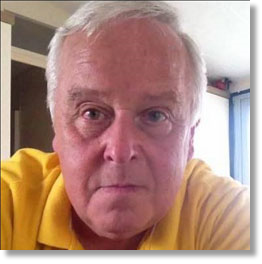
John - 2017
From: Terry Joint, Murcia
Subject: Memories of Aden
Hi Tony,
I was at Public boarding school in 1962 when my father told me he was posted to Aden (as PA to SASO Air Cmdr Mike Le Bas). I had no clue at all of even where it was in the world. After he had been there a few weeks it was school holiday time. My Mother and sister would come out a few days later and I was to go on ahead on my own. We flew via Libya and Khartoum. I remember my first taste of Lemoon in Khartoum, a fantastic still lemon drink and so welcome after who knows how many hours on a Britannia.
Our first married quarter was in the Maala straight, I remember the heat as we dis-embarked at Khormaksar, like walking straight into a pre-heated oven. I thought how on earth could people live in this. My mother and sister arrived the next day and so family life began in Aden. My parents loved it there, despite the start of the troubles and I spent many school holidays with them, mostly happy times but by the end with the increasing security and bombs going off all the time, life was more difficult.
I joined the RAF at Hereford in September 1965 (304 Entry). Then at Xmas I went back home to Aden and found my father had volunteered to stay until the base was closed, due to be in November 1967. So, after having been recoursed once (I was a useless storeman!), I arranged to get claimed to be with my Father in Aden. At this time it was an active duty post and as I was only 17.5 years old, I could go but no war like duties were allowed, i.e. guard duty etc. You can Imagine how I was ribbed over this at Supply Sqn Steamer Point: "Baby, too young to be on guard, don’t worry it'll be your turn soon ha ha, you wait!"
The Supply Sqn was situated right next to the RAF Police Intelligence Centre and the sounds that came from that building will be with me for the rest of my life. It was the interrogation centre for the whole area.
Subject: Memories of Aden
Hi Tony,
I was at Public boarding school in 1962 when my father told me he was posted to Aden (as PA to SASO Air Cmdr Mike Le Bas). I had no clue at all of even where it was in the world. After he had been there a few weeks it was school holiday time. My Mother and sister would come out a few days later and I was to go on ahead on my own. We flew via Libya and Khartoum. I remember my first taste of Lemoon in Khartoum, a fantastic still lemon drink and so welcome after who knows how many hours on a Britannia.
Our first married quarter was in the Maala straight, I remember the heat as we dis-embarked at Khormaksar, like walking straight into a pre-heated oven. I thought how on earth could people live in this. My mother and sister arrived the next day and so family life began in Aden. My parents loved it there, despite the start of the troubles and I spent many school holidays with them, mostly happy times but by the end with the increasing security and bombs going off all the time, life was more difficult.
I joined the RAF at Hereford in September 1965 (304 Entry). Then at Xmas I went back home to Aden and found my father had volunteered to stay until the base was closed, due to be in November 1967. So, after having been recoursed once (I was a useless storeman!), I arranged to get claimed to be with my Father in Aden. At this time it was an active duty post and as I was only 17.5 years old, I could go but no war like duties were allowed, i.e. guard duty etc. You can Imagine how I was ribbed over this at Supply Sqn Steamer Point: "Baby, too young to be on guard, don’t worry it'll be your turn soon ha ha, you wait!"
The Supply Sqn was situated right next to the RAF Police Intelligence Centre and the sounds that came from that building will be with me for the rest of my life. It was the interrogation centre for the whole area.
When I turned 18, I volunteered (yes, I know) to join what was called "Buchan’s Buccaneers", mainly because we got issued with the new 7.62 mm SLR and didn’t have to use the old .303 any more. The Buccaneers were led by Flt Lt Buchan and his RAF Regiment team. We used to go downtown and patrol areas given to us by the army. One time we were out, three or four either side of a narrow street, when someone shouted, "GRENADE!" and, as trained, we all dropped to the ground and after the explosion we looked up to see the perpetrator looking down from the rooftop, presumably to see how many he got. It was either six or eight of us that emptied our entire magazines into him in a very short time. None of us had been injured as luckily the grenade had landed on an area of very soft sand.
My best friend whilst there - I have forgotten his name due the sands of time - was a guy from Barbados, an MT driver. We used to go spear fishing every afternoon after work and generally hang out. His favorite trick was to dress up as an Arab and get down town to Steamer Point for shopping (by this time we were not allowed off base at all except on duty and fully armed). One day he did not come back, the RAF Police came to our barracks and emptied his lockers etc. It turns out he had been challenged by an Army patrol. He was scared of being caught and charged, so he ran away. They shot him dead, his F1250 was in his left shoe.
I left Steamer Point with many more stories like the above in November 1967, transferred to the Crystal Bank in Muharraq. I went in an Argosy out of Khormaksar and we had an engine failure just after take off. The Captain said he was not going back to the F-in hell hole and we carried on with just three engines. Besides making me grow up very quickly, Aden formed me for life, and I have no regrets.
Terry Joint
I left Steamer Point with many more stories like the above in November 1967, transferred to the Crystal Bank in Muharraq. I went in an Argosy out of Khormaksar and we had an engine failure just after take off. The Captain said he was not going back to the F-in hell hole and we carried on with just three engines. Besides making me grow up very quickly, Aden formed me for life, and I have no regrets.
Terry Joint
Terry - 2016
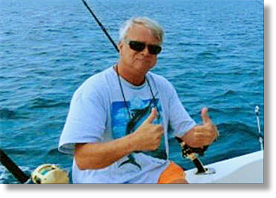
From: Tony Street, Buffalo, NY
Subject: Aden
In April of ’64 I was part an RCAF crew flying a Yukon a/c modeled after the UK’s Britannia and we transited through Aden, where in the space of 48 hours my emotions were stretched to both ends of the spectrum, from hilarity to utter disgust for some species of humanity.
Aden is where, I believe, I first heard the expression, “Aden is not the a**hole of the world, but you can see it from here.” We got off to a bad start.
As was the procedure at the time, spraying the a/c for bugs etc. while taxiing in was a common procedure in some places, and if no requirement was known for a destination, we sprayed “Just in case.” Now, to spray the whole cabin was a tedious and noxious chore, so we sprayed just inside the door that the customs pukes were going to enter. (As we were arriving from France, de-infestation seemed prudent). In this case we sprayed, and upon opening the cabin door the tremendous blast of hot, dry air combined with the DDT stink literally took our breaths away and caused two of the guys to vomit.
After the arrival formalities were over, we six airmen, were swept away to the luxurious Red Sea Hotel where we were ushered into our quarters where we were told to select our accommodation. We each selected one cot out of 20 in a long narrow room on the second floor. The first thing that required our attention was the pervading stench that overwhelmed the place. We walked to the end of the room and looking down from the balcony, we saw the source, the goat market! Never having seen one prior, we were enthralled! There were goats of all stripes, big, little, white, brown, bearded and none-bearded. And, yes, some of them were striped. They arrived and departed in a variety of modes, in small herds, trunks of automobiles, beds of pickup trucks and wrapped around the necks of men and boys. The place was awash with the water used to wash them mixed with the endless supply of feces.
Subject: Aden
In April of ’64 I was part an RCAF crew flying a Yukon a/c modeled after the UK’s Britannia and we transited through Aden, where in the space of 48 hours my emotions were stretched to both ends of the spectrum, from hilarity to utter disgust for some species of humanity.
Aden is where, I believe, I first heard the expression, “Aden is not the a**hole of the world, but you can see it from here.” We got off to a bad start.
As was the procedure at the time, spraying the a/c for bugs etc. while taxiing in was a common procedure in some places, and if no requirement was known for a destination, we sprayed “Just in case.” Now, to spray the whole cabin was a tedious and noxious chore, so we sprayed just inside the door that the customs pukes were going to enter. (As we were arriving from France, de-infestation seemed prudent). In this case we sprayed, and upon opening the cabin door the tremendous blast of hot, dry air combined with the DDT stink literally took our breaths away and caused two of the guys to vomit.
After the arrival formalities were over, we six airmen, were swept away to the luxurious Red Sea Hotel where we were ushered into our quarters where we were told to select our accommodation. We each selected one cot out of 20 in a long narrow room on the second floor. The first thing that required our attention was the pervading stench that overwhelmed the place. We walked to the end of the room and looking down from the balcony, we saw the source, the goat market! Never having seen one prior, we were enthralled! There were goats of all stripes, big, little, white, brown, bearded and none-bearded. And, yes, some of them were striped. They arrived and departed in a variety of modes, in small herds, trunks of automobiles, beds of pickup trucks and wrapped around the necks of men and boys. The place was awash with the water used to wash them mixed with the endless supply of feces.
We also saw a strange ritual. A couple of shepherds, guarding their flocks, were sitting cross-legged against the building. In front of them were pails of, we found out later, goat feces. They had sticks about ½ inch in diameter and four feet long with one end in the pail, the other pointing straight up. They would reach into the pail, scoop up a handful and massage it into the stick from bottom to the top and when reaching the last six inches would introduce a twist into their wrist action. We were told they were making shepherds crooks, whatever. Watching this proved exhausting and, after a 16 hour day, it was de-briefing time
Off in search of mix and ice for our duty-free Canadian Club, we ran across a couple of RAF types who summonsed the houseboy, who we’ll call Omar. We took Omar to our room and pointy-talkied him until he understood our needs (the RAF chappies had warned us this would be difficult at best). We only wanted ice and mix, what could possibly go wrong?
His face beaming with a new understanding, Omar hastened from the room and down the stairs. Concerned that he had misunderstood us we followed his progress through the open brick architecture only to see him run out of the building, through the goat market, and down an alleyway to his right. We thought we had given him the day off by mistake. “Well, we’ll have to drink it straight,” was the consensus. This requires glasses, so the hunt was on. We found some in a cupboard that turned out to be Omar’s work station. They were grubby at best but gleamed after being swabbed out with Canadian Club and an unlaundered undershirt.
We were sitting, feet up, on the balcony contemplating about our luck, when one of the guys exclaimed, “Is that our Omar?” It certainly was. He was heading back to the hotel at a brisk trot with a large chunk of ice on his head. We were confused at this point because the closer he got to us the block of ice remained the same size. It was melting at a balanced rate. Amazing!
He took the stairs two at a time, bounced into the room, and dropped the remaining piece of ice, now reduced to the size of a bowling ball into the hollow of Dick’s bed. He held out his hand for payment as the ice continued to melt. Dick was a little cranky at this point having worked the trip while the rest of us swanned about. He started the pointy-talkie stuff again eventually getting through to Omar that it was ice cube size that we wanted. Omar ran to his cupboard and came back to Dick’s bed with a bowl and a rusty ball peen hammer and started to hammer the ice into small pieces. When he thought he had it right, he scooped it up with the bowl and proffered it to us along with his outstretched palm. Dick had had enough.
He looked into the bowl and found, floating in rusty water and specks of something or other, not enough ice to fill our glasses once. With an outburst of foul language, Dick defenestrated the lot causing Omar to run out in tears. We gave up and sat on the veranda drinking and watching the goats and stuff.
Our reverie was interrupted suddenly by the appearance of an RAF Sergent Police Officer trailing Omar. “ ‘Ello, ‘ello, ‘ello, wots going on ‘ere then?” He asked. Explanations ensued and eventually the incident was sorted with a large settlement laid upon Omar. The Sarge joined us in a tipple.
His face beaming with a new understanding, Omar hastened from the room and down the stairs. Concerned that he had misunderstood us we followed his progress through the open brick architecture only to see him run out of the building, through the goat market, and down an alleyway to his right. We thought we had given him the day off by mistake. “Well, we’ll have to drink it straight,” was the consensus. This requires glasses, so the hunt was on. We found some in a cupboard that turned out to be Omar’s work station. They were grubby at best but gleamed after being swabbed out with Canadian Club and an unlaundered undershirt.
We were sitting, feet up, on the balcony contemplating about our luck, when one of the guys exclaimed, “Is that our Omar?” It certainly was. He was heading back to the hotel at a brisk trot with a large chunk of ice on his head. We were confused at this point because the closer he got to us the block of ice remained the same size. It was melting at a balanced rate. Amazing!
He took the stairs two at a time, bounced into the room, and dropped the remaining piece of ice, now reduced to the size of a bowling ball into the hollow of Dick’s bed. He held out his hand for payment as the ice continued to melt. Dick was a little cranky at this point having worked the trip while the rest of us swanned about. He started the pointy-talkie stuff again eventually getting through to Omar that it was ice cube size that we wanted. Omar ran to his cupboard and came back to Dick’s bed with a bowl and a rusty ball peen hammer and started to hammer the ice into small pieces. When he thought he had it right, he scooped it up with the bowl and proffered it to us along with his outstretched palm. Dick had had enough.
He looked into the bowl and found, floating in rusty water and specks of something or other, not enough ice to fill our glasses once. With an outburst of foul language, Dick defenestrated the lot causing Omar to run out in tears. We gave up and sat on the veranda drinking and watching the goats and stuff.
Our reverie was interrupted suddenly by the appearance of an RAF Sergent Police Officer trailing Omar. “ ‘Ello, ‘ello, ‘ello, wots going on ‘ere then?” He asked. Explanations ensued and eventually the incident was sorted with a large settlement laid upon Omar. The Sarge joined us in a tipple.
The sergeant explained to us that Omar was not too troubled about the goings-on as it was mild compared to the RAF chaps fun and games. “But ‘e had to draw the line when you chucked his ablution bowl out the winder cos ‘e needs it five time a day to do ‘is prayer thingy.”
That was the funny part.
The next morning, hungover, Dick and I went in search of a greasy breakfast and a Bloody Mary. We were to be thwarted and sickened. As we made our way along a sidewalk we became aware of the intense heat and the beating sun, we also realized that in our weakened condition, breathing wasn’t the easiest thing going. Panting, we struggled on seeking shade and succor. It was then, we heard a gurgling, whiney sound behind us. Turning, at first we saw nothing, then our eyes dropped to see a sight that still sickens me.
There was a boy of approximately 8 or 9 years old with no limbs below his elbows and knees walking like a dog! His stumps were stuck into, what appeared to be dice cups, held in place with strings over his shoulders and hips. He wore an empty tin under his chin, again held by string. We were stunned. Suddenly, he reared up on his legs and said what we interpreted to be a request for alms. We were too shaken to respond. Dick and I turned simultaneously and took off at a smart pace wondering what to do. Behind us we heard the plop, plop, plop of the leather cups hitting the hot pavement as he gave chase. We saw a door and hastened in. It was a coffee shop. We closed the door behind us only to see the boy, again on his legs with his face and hands pressed against the window mewling for alms. The manager came to our rescue by opening the door and giving the lad some money. We collapsed onto a sofa, and when we regained some semblance of sanity, ordered coffee.
As we sat there drinking our coffee, the manager came over with a plate of sweet rolls and joined us. He told us that he wasn’t surprised at our reaction to the boy and pointed out that he was from a very poor family and such mutilation was common in his society of beggars. His explanation made sense to me but did not assuage my revulsion and has not to this day.
Tony Street
Buffalo, NY
July 2017
That was the funny part.
The next morning, hungover, Dick and I went in search of a greasy breakfast and a Bloody Mary. We were to be thwarted and sickened. As we made our way along a sidewalk we became aware of the intense heat and the beating sun, we also realized that in our weakened condition, breathing wasn’t the easiest thing going. Panting, we struggled on seeking shade and succor. It was then, we heard a gurgling, whiney sound behind us. Turning, at first we saw nothing, then our eyes dropped to see a sight that still sickens me.
There was a boy of approximately 8 or 9 years old with no limbs below his elbows and knees walking like a dog! His stumps were stuck into, what appeared to be dice cups, held in place with strings over his shoulders and hips. He wore an empty tin under his chin, again held by string. We were stunned. Suddenly, he reared up on his legs and said what we interpreted to be a request for alms. We were too shaken to respond. Dick and I turned simultaneously and took off at a smart pace wondering what to do. Behind us we heard the plop, plop, plop of the leather cups hitting the hot pavement as he gave chase. We saw a door and hastened in. It was a coffee shop. We closed the door behind us only to see the boy, again on his legs with his face and hands pressed against the window mewling for alms. The manager came to our rescue by opening the door and giving the lad some money. We collapsed onto a sofa, and when we regained some semblance of sanity, ordered coffee.
As we sat there drinking our coffee, the manager came over with a plate of sweet rolls and joined us. He told us that he wasn’t surprised at our reaction to the boy and pointed out that he was from a very poor family and such mutilation was common in his society of beggars. His explanation made sense to me but did not assuage my revulsion and has not to this day.
Tony Street
Buffalo, NY
July 2017

From: Bryan Morgan, Abingdon, Oxon
Subject: Memories of Aden
Tony,
Although I never served at Khormaksar I have one happy memory of transitting through. In 1962 I was selected for the Combined Services (CS) Rugby Tour to Kenya and Rhodesia (as was). After three weeks away it was discovered that no arrangements had been made for the return to the UK. Admiral Brockman, the tour Manager, was less than impressed and, as it was a flying matter, vented his spleen on Flt Lt Bill Thompson, the Secretary of the CS, who was tasked with a quick fix.
Subject: Memories of Aden
Tony,
Although I never served at Khormaksar I have one happy memory of transitting through. In 1962 I was selected for the Combined Services (CS) Rugby Tour to Kenya and Rhodesia (as was). After three weeks away it was discovered that no arrangements had been made for the return to the UK. Admiral Brockman, the tour Manager, was less than impressed and, as it was a flying matter, vented his spleen on Flt Lt Bill Thompson, the Secretary of the CS, who was tasked with a quick fix.
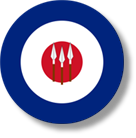
Two RRAF Dakotas were laid on to ferry us as far as RAF Eastleigh in Nairobi via Tabora, in what is now Tanzania. There the aircraft were refuelled by hand pumping from 45 gallon drums - not terribly reassuring. At Eastleigh we were prioritised into small groups which were emplaned on any aircraft en route to Aden. Claiming he had an urgent meeting to attend at MoD the Admiral disappeared first leaving Bill Thompson to sort the rest of us out. After a couple of days the last but one group of three, which included Leighton Jenkins the Captain, were hauled off to get on a Beverley en-route to Khormaksar. About two hours later the remaining three of us were called forward to fill the last seats on an aeromedical Comet IV, which had come through from Lagos in Nigeria.
After two hours of very comfortable flying we arrived at Khormaksar where we were offloaded to make room for patients. We enjoyed several beers in the Air Terminal knowing that Leighton & Co were still some hours away. I will not repeat the expletives that rained upon us when they finally turned up somewhat bedraggled and thirsty. I have never had so much pleasure in buying someone a pint! Finally, we did, at least, all get the back to the UK together on a 99 Sqn Britannia - it had taken us a full seven days to get home.
Bryan Morgan
Bryan Morgan

From: Andrew Tiny, Kent
Subject: Memories of Aden
Hi Tony,
My Dad (W/O Eric Batty), sent me this account of Aden, I hope it's of some use. Regards, Andrew
Subject: Memories of Aden
Hi Tony,
My Dad (W/O Eric Batty), sent me this account of Aden, I hope it's of some use. Regards, Andrew
Memories of Aden - fortunately very few.
We flew from Stanstead late at night, having been delayed due to a servicing problem. When we arrived in Aden at about midday, and the passenger doors were opened, we were greeted by a blast of Aden's superheated air. There was on board a lady passenger who had kept on, for the whole flight, a fur coat. She did not take it off even when she got off of the aircraft. She must have been in training for a long stay in Aden!
Those of us who were due to be moved on to the various staging posts were kept in transit for a few days. To keep us from getting bored, we were given various jobs. I was given the task of being an escort on a children's school bus. This was quite an experience. Those children would have scared Rommel's Afrika Corp. I only had to do it once before being flown out on a Hastings.
My next trip to Aden was by Beverley on my way to Mombassa and the Nyali Rest Centre. This was a trip to remember; whilst waiting to board I had the need to make use of the airport's toilets. Some of you may also have had to make use of this ancient and crude type of convenience. I understand that these appear on some of the French motorways!
To sum up, I can only say that Aden equates to heat and those serving there deserved a medal. Little did I know that in 1966-67 I should get to know the Hastings, Beverley and various other aircraft, now all museum pieces, whilst I was with FEAF MAMS.
Regards to all - Eric Batty.
We flew from Stanstead late at night, having been delayed due to a servicing problem. When we arrived in Aden at about midday, and the passenger doors were opened, we were greeted by a blast of Aden's superheated air. There was on board a lady passenger who had kept on, for the whole flight, a fur coat. She did not take it off even when she got off of the aircraft. She must have been in training for a long stay in Aden!
Those of us who were due to be moved on to the various staging posts were kept in transit for a few days. To keep us from getting bored, we were given various jobs. I was given the task of being an escort on a children's school bus. This was quite an experience. Those children would have scared Rommel's Afrika Corp. I only had to do it once before being flown out on a Hastings.
My next trip to Aden was by Beverley on my way to Mombassa and the Nyali Rest Centre. This was a trip to remember; whilst waiting to board I had the need to make use of the airport's toilets. Some of you may also have had to make use of this ancient and crude type of convenience. I understand that these appear on some of the French motorways!
To sum up, I can only say that Aden equates to heat and those serving there deserved a medal. Little did I know that in 1966-67 I should get to know the Hastings, Beverley and various other aircraft, now all museum pieces, whilst I was with FEAF MAMS.
Regards to all - Eric Batty.

From: Michael Craner, Yeovil, Somerset
Subject: Memories of the Far East and Aden
G’day Tony,
I have a lot of memories of Changi, I was posted there on AQM duties from Colerne in September 1964. At Changi I met a great mover, Flt Lt Frank Murray, a kind and helpful man who was always up for a laugh.
Changi was one of the best times and I have never met anyone who did not like it. Apart from the regular trips to Labuan, Kuching, Butterworth and Gan, I went to places I could only dream of. In November I went to to Whenuapai via Cocos, Pearce, Edinburgh Field and Richmond only to return with an engine change at Pearce on the way back. I saw Mary Poppins in the small Australian town called Midland and recall many exciting times in the Sgts Mess at Pearce. I had later trips to Kai Tak via Saigon, Clark Field, Tachikawa and Okinawa.
Subject: Memories of the Far East and Aden
G’day Tony,
I have a lot of memories of Changi, I was posted there on AQM duties from Colerne in September 1964. At Changi I met a great mover, Flt Lt Frank Murray, a kind and helpful man who was always up for a laugh.
Changi was one of the best times and I have never met anyone who did not like it. Apart from the regular trips to Labuan, Kuching, Butterworth and Gan, I went to places I could only dream of. In November I went to to Whenuapai via Cocos, Pearce, Edinburgh Field and Richmond only to return with an engine change at Pearce on the way back. I saw Mary Poppins in the small Australian town called Midland and recall many exciting times in the Sgts Mess at Pearce. I had later trips to Kai Tak via Saigon, Clark Field, Tachikawa and Okinawa.
Things came to an abrupt halt in July 1965 when Hastings TG577 crashed on a Para drop out of Abingdon, with the loss of 41 lives, we were grounded. Nothing to do. I was friends with a couple of Kiwis on 41 Sqn RNZAF, Bristol Freighters, so I did 3 trips to Labuan with them. Labuan was Laboon to the crew I flew with, terrific blokes.
I also did a “Changi Splash” a Parachute Jump into the sea from a 215 Sqn Argosy. When we were all mended, I went to Karachi via Gan, this to bring back workers from Karachi to Gan, enough said about that trip.
Back into a regular routine of Kuching, Labuan, Kauntan, Butterworth, Bangkok, Kai Tak, Darwin, Gan and Katunayake. I could not have had a better tour, met some great people. Not forgetting my Chinese neighbours on Fidelio Street, Opera Estate, Singapore.
I also did a “Changi Splash” a Parachute Jump into the sea from a 215 Sqn Argosy. When we were all mended, I went to Karachi via Gan, this to bring back workers from Karachi to Gan, enough said about that trip.
Back into a regular routine of Kuching, Labuan, Kauntan, Butterworth, Bangkok, Kai Tak, Darwin, Gan and Katunayake. I could not have had a better tour, met some great people. Not forgetting my Chinese neighbours on Fidelio Street, Opera Estate, Singapore.
I must mention Mr Lim's Makan stall in Changi Village, Prawns, Noodles and Tiger Beer. It would take forever to mention all the delights of Singapore, Bugis Street for one! Does anyone remember the “Banana Leaf Apollo” on Cuff road? Terrific curry!
Just two days ago I had a phone call from my ex Captain from 48 Sqn, Flt Lt Paul Janner, PAJ to his mates. The phone line was hot!
Just two days ago I had a phone call from my ex Captain from 48 Sqn, Flt Lt Paul Janner, PAJ to his mates. The phone line was hot!
Aden
Exercise Jacobin and we went to Muharraq for this. Arrived late, no digs as Britannia House was full. So, ten days in the Gulf Hotel. My good friend the late Thomas Ignatius Conway and I did our best to eat our way through the Al a Carte menu. We also did some trips to Khormaksar; the last on 29 November 1967, Hercules XV 208 about 10 minutes chox to chox - very smooth moving that day!
Picture is Hastings WJ 337 over the Angling Club at Changi; the very last flight of the Hastings at Changi. March 3rd 1967. Captain was Flt Lt Des Pankhurst.
Regards, Mick
Exercise Jacobin and we went to Muharraq for this. Arrived late, no digs as Britannia House was full. So, ten days in the Gulf Hotel. My good friend the late Thomas Ignatius Conway and I did our best to eat our way through the Al a Carte menu. We also did some trips to Khormaksar; the last on 29 November 1967, Hercules XV 208 about 10 minutes chox to chox - very smooth moving that day!
Picture is Hastings WJ 337 over the Angling Club at Changi; the very last flight of the Hastings at Changi. March 3rd 1967. Captain was Flt Lt Des Pankhurst.
Regards, Mick
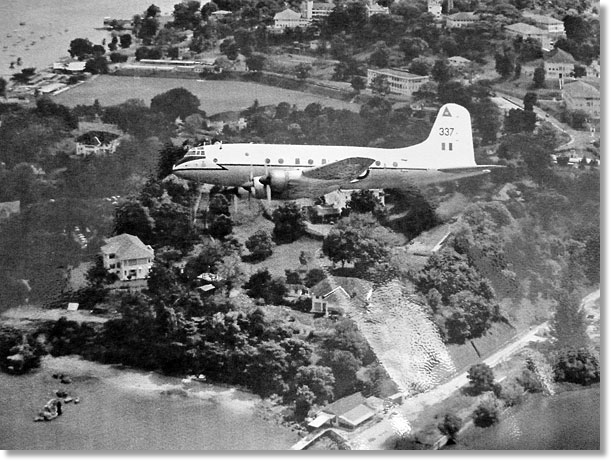

From: Arthur Taylor, Newcastle under Lyme, Staffs
Subject: Memories of Aden
Aden has many memories for me whilst I was an AQM on 30 Squadron (Beverleys). From our base at RAF Dishforth the normal Mid-East route itinery was via Abingdon, Istres, Luqa, El Adem, Khartoum and then onto Khormaksar. On that schedule we had a 24 hours layover and we were normally accommodated downtown in the Crescent Hotel. However, we had one outbound trip which was unusual via Istres, Idris, Kano and Entebbe; it was a more interesting route, and included nightstops.
There was also the detachment of 2 aircraft to Khormaksar where we had up-country schedules and the odd Riyan, Salalah, Masirah trips, some were extended to Sharjah and Muharraq, which was useful to use up the airframe hours (the legnth of the detachment was governed to so many airframe hours in those days). The detachment lasted about 3 months and we were usually accommodated in the Sgts Mess at Khormaksar.
Subject: Memories of Aden
Aden has many memories for me whilst I was an AQM on 30 Squadron (Beverleys). From our base at RAF Dishforth the normal Mid-East route itinery was via Abingdon, Istres, Luqa, El Adem, Khartoum and then onto Khormaksar. On that schedule we had a 24 hours layover and we were normally accommodated downtown in the Crescent Hotel. However, we had one outbound trip which was unusual via Istres, Idris, Kano and Entebbe; it was a more interesting route, and included nightstops.
There was also the detachment of 2 aircraft to Khormaksar where we had up-country schedules and the odd Riyan, Salalah, Masirah trips, some were extended to Sharjah and Muharraq, which was useful to use up the airframe hours (the legnth of the detachment was governed to so many airframe hours in those days). The detachment lasted about 3 months and we were usually accommodated in the Sgts Mess at Khormaksar.
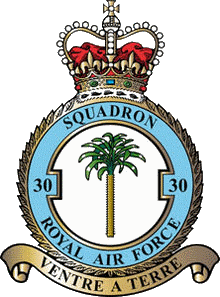
The up-country trips were in the main only an hour or so flight time, and some of the strips we landed at were to say the least a bit hair raising, but on the whole enjoyable, it was an experience!
Socially, I remember there wasn't a great deal going on other than the Astra station cinema. Then the CSE show with the star whose name has always stuck in my mind, Avril Angers. Never heard of her since that show. In fact, I hadn't heard of her before.
I have read other ex-colleagues experiences of Aden and found them enlightening and in some cases, we were on the same aircraft, they were my passengers. Small world, and from the readings, they were also Movers!
My personal experience was one that I am pleased I had the opportunity to go there. The only times I went downtown was when we were on the schedule and our accommodation was the Crescent Hotel. I have never been one for going shopping when on route either as AQM or when on MAMS. Actually, that's not strictly true. There was the time while on detachment from January to March, 1958, when my brother was a steward on the RMS Oronsay and was calling in at Aden enroute to the UK from Australia. That was a day to remember; I was on the quayside when a launch brought the passengers ashore, a chap shouted up for me to get on the launch which headed back to the ship and I went onboard.
Socially, I remember there wasn't a great deal going on other than the Astra station cinema. Then the CSE show with the star whose name has always stuck in my mind, Avril Angers. Never heard of her since that show. In fact, I hadn't heard of her before.
I have read other ex-colleagues experiences of Aden and found them enlightening and in some cases, we were on the same aircraft, they were my passengers. Small world, and from the readings, they were also Movers!
My personal experience was one that I am pleased I had the opportunity to go there. The only times I went downtown was when we were on the schedule and our accommodation was the Crescent Hotel. I have never been one for going shopping when on route either as AQM or when on MAMS. Actually, that's not strictly true. There was the time while on detachment from January to March, 1958, when my brother was a steward on the RMS Oronsay and was calling in at Aden enroute to the UK from Australia. That was a day to remember; I was on the quayside when a launch brought the passengers ashore, a chap shouted up for me to get on the launch which headed back to the ship and I went onboard.
I had a breakfast in the First Class dining room, met the ship's Captain, then my brother and I went ashore and ended up in the Sgt's Mess bar before he had to return to the ship. I had promised my brother that we would meet up at Mum's place when I got home, however, that never happened.
I was on the RSM (Riyan-Salalah-Masirah) schedule the next day. The other aircraft on the detachment with us was on the up-country schedule. Sadly there was an accident with this aircraft. We were grounded at Masirah. Eventually, we were allowed to recover to Aden, but enroute, we had No 3 engine problems and were diverted to Riyan. With no transit accommodation, the Signaller, other AQM and I were accommodated in Station Sick Quarters.
I was on the RSM (Riyan-Salalah-Masirah) schedule the next day. The other aircraft on the detachment with us was on the up-country schedule. Sadly there was an accident with this aircraft. We were grounded at Masirah. Eventually, we were allowed to recover to Aden, but enroute, we had No 3 engine problems and were diverted to Riyan. With no transit accommodation, the Signaller, other AQM and I were accommodated in Station Sick Quarters.
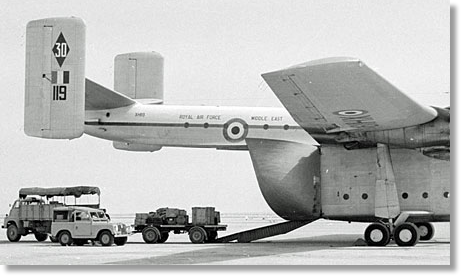
The end result was the need for an engine change and the only aircraft that could carry the Beverley engine was another Beverley. The first one bringing us an engine used it for themselves enroute, so we had to wait. Things were getting a bit worrying at Riyan, lack of kit etc, but we managed to get back to Aden in a Valetta aircraft. So we waited for an engine, eventually, got one. Collected the aircraft from Riyan, back to Aden and home.
Our delay meant that we missed our colleagues from the other crew, they had returned home before we got back to Aden. It also meant that I had missed my brother, who had been home, then had gone back to sea on the Oronsay.
In total, I did three detachments to Aden, which equated to a nine-months tour, however, it was in the days when there was relative peace in the area. What I remember most about the place was the heat and humidity, not too much fun when loading /offloading aircraft, however, we managed, and without the handling aids that are available today; how things have changed!
Our delay meant that we missed our colleagues from the other crew, they had returned home before we got back to Aden. It also meant that I had missed my brother, who had been home, then had gone back to sea on the Oronsay.
In total, I did three detachments to Aden, which equated to a nine-months tour, however, it was in the days when there was relative peace in the area. What I remember most about the place was the heat and humidity, not too much fun when loading /offloading aircraft, however, we managed, and without the handling aids that are available today; how things have changed!
From: Richard Lloyd, Dalgety Bay, Fife
Subject: Memories of Aden
Subject: Memories of Aden
As bunnies go, I was an unhappy one when at the end of the Senior Air Movements course in 1966, I was told I was being posted to Khormaksar in Feb 1967, and in the meantime I'd be going as supernumerary to Lyneham. Why not Changi? Or Kai Tak? There was a bit of a war on in Aden, no?
RAF Lyneham turned out to be a good experience, I hit it off with the 2 DAMOs I worked for - Flt Lts Pete Boggis and Harry Lawson. Harry was a fellow Fifer, a former Music Corps Major, who took time to educate me about classical music and in particular Mozart. He had a great sense of humour, being particularly fond of a practical joke. He ended his career at RAFSCC Hendon, where it is alleged that his parting gift was to plant many sunflowers round the huts, which sprang up long after his departure.
With 2 Squadrons of Britannias (99 & 511) and the Comet 2s & 4s of 216 Sqn, it meant that there was plenty of flying opportunities and I took the chance to get trips to Luqa, Akrotiri and Gibraltar, on my long off-shift weekends.
I also met a nice guy, Fg Off Dave Welch, who had just come back from Khormaksar - Dave was on a short service commission and retired from Lyneham, but we were to meet again when I was posted to Northolt. Dave said Khormaksar wasn't too bad, that he'd joined the Aden Forces Broadcasting Association (AFBA) & had a lot of fun there. So when the time came for me to go, I was less apprehensive. Also I knew that Martin Henderson was down at Steamer Point & Pete Kingwill was on AFME MAMS, so friends were there.
With 2 Squadrons of Britannias (99 & 511) and the Comet 2s & 4s of 216 Sqn, it meant that there was plenty of flying opportunities and I took the chance to get trips to Luqa, Akrotiri and Gibraltar, on my long off-shift weekends.
I also met a nice guy, Fg Off Dave Welch, who had just come back from Khormaksar - Dave was on a short service commission and retired from Lyneham, but we were to meet again when I was posted to Northolt. Dave said Khormaksar wasn't too bad, that he'd joined the Aden Forces Broadcasting Association (AFBA) & had a lot of fun there. So when the time came for me to go, I was less apprehensive. Also I knew that Martin Henderson was down at Steamer Point & Pete Kingwill was on AFME MAMS, so friends were there.
The Officers' Mess accommodation at Khormaksar was, for new arrivals, in a non-air-conditioned 2 storey block. Old stagers with brown knees eventually got accommodated in 'Shangri-La' - alleged to be air conditioned heaven. I shared a room with Flt Lt Brian ('Pricky') Price, who was a well-educated, but rather naive chap. Brian's idea of an exciting evening was a quiz using random pages of the dictionary to ask your opponent the meaning of obscure words.
Immediately below us lived an eccentric air trafficker, called Kiwi Francis, whose hobby was controlling the feral cat population by means of a powerful catapult. This catapult could punch a hole in a galvanised rubbish bin at 20 feet, so it was no mean weapon. Kiwi was very fussy about his appearance, washed and ironed his immaculate KD every day & hung it out to dry outside his room on the 'patio' fence.
One evening, when dictionary quizzing was palling, Brian decided to go to the bar & get slaughtered - nothing new there, but his tipple was not Tiger or Tennent's but crème de menthe! He was in a sorry state when came back to our room, and deposited recycled crème de menthe over our balcony onto Kiwi's uniform. Oh how we laughed, except Kiwi of course!
Immediately below us lived an eccentric air trafficker, called Kiwi Francis, whose hobby was controlling the feral cat population by means of a powerful catapult. This catapult could punch a hole in a galvanised rubbish bin at 20 feet, so it was no mean weapon. Kiwi was very fussy about his appearance, washed and ironed his immaculate KD every day & hung it out to dry outside his room on the 'patio' fence.
One evening, when dictionary quizzing was palling, Brian decided to go to the bar & get slaughtered - nothing new there, but his tipple was not Tiger or Tennent's but crème de menthe! He was in a sorry state when came back to our room, and deposited recycled crème de menthe over our balcony onto Kiwi's uniform. Oh how we laughed, except Kiwi of course!
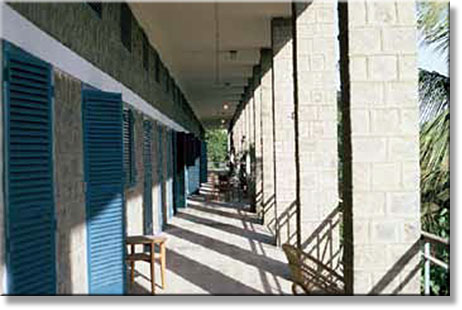
This is a picture of single officer‘s non air-conditioned accommodation. We were 2 to a room, with a big ceiling fan, and shower & toilet - never was cool.
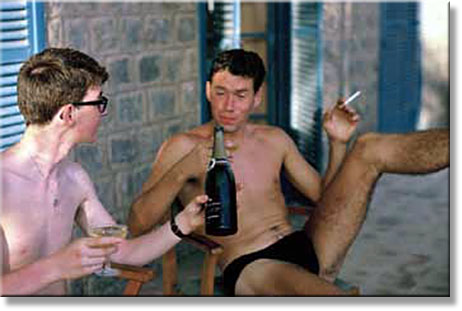
John MacDonald and I enjoying a glass of lemonade. I think I had just arrived in Aden, though it must be said that I am a fair-skinned Scot, and John could get a tan under a 5-Watt lightbulb!
By now I had joined a shift, and had met up with a couple of Movers in the Mess, Dave Benson and John MacDonald who became good friends. I can't recall in what order these guys were my DAMOs, but I worked as Traffic Officer for Dave Edwards, for John Damment and finally for Dick Whitworth. I had a great bunch of guys, Sgt Tony Thompson, Cpl Jim Brett, and 3 SACs of whom I only recall Ken Feast's name (Ken & I served together later in SCAF at Gütersloh).

Other notable station movers were Terry Watson, Tony Coleman, Pete Plowman, and of course the rather scary Sqn Ldr E C (Nobby) Clark, the Sqn No 2. I can't remember the name of the SAMO - I think it was Fred something, but I was just a humble Pilot Officer. Nor can I remember the name of the ATLO, a really nice RCT Major - Ken someone. It is alleged that Major Ken told a stroppy civil servant who was complaining about his seat allocation on the aircraft and that his equivalent military rank was lieutenant colonel, to shut up, and that his (Ken's) equivalent civilian rank was brain surgeon!
In 1967, Khormaksar was the biggest RAF Station in the world. Commanded by Gp Capt Michael ('Barmy') Beetham, (later MRAF Sir Michael), we had:
84 Sqn Beverlys.
105 Sqn Argosies.
37 Sqn Shackletons.
21 Sqn Twin Pioneers, an Andover & a Dakota.
78 Sqn Wessex & an SAR Whirlwind.
8 & 43 Sqn Hunters.
1417 Flight Hunters.
RAF Regiment Sqn (no 37).
I was told we numbered around 8,000 bods. Our shift pattern was great for a young man. An 11 hour day (0700 - 1800) followed by 24 hours off, then a 13 hour night (1800 - 0700) followed by 48 hours off. The days were usually followed by bar duty, and the nights quite often by an immediate transfer to the beach at Tarshyne.
84 Sqn Beverlys.
105 Sqn Argosies.
37 Sqn Shackletons.
21 Sqn Twin Pioneers, an Andover & a Dakota.
78 Sqn Wessex & an SAR Whirlwind.
8 & 43 Sqn Hunters.
1417 Flight Hunters.
RAF Regiment Sqn (no 37).
I was told we numbered around 8,000 bods. Our shift pattern was great for a young man. An 11 hour day (0700 - 1800) followed by 24 hours off, then a 13 hour night (1800 - 0700) followed by 48 hours off. The days were usually followed by bar duty, and the nights quite often by an immediate transfer to the beach at Tarshyne.
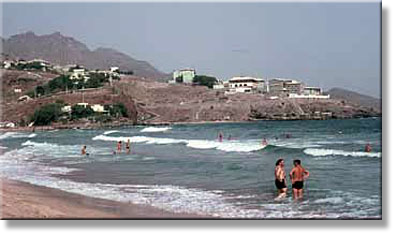
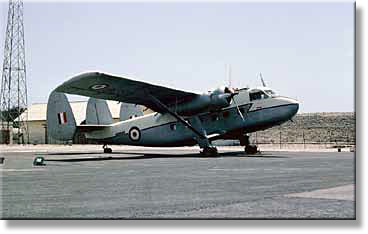
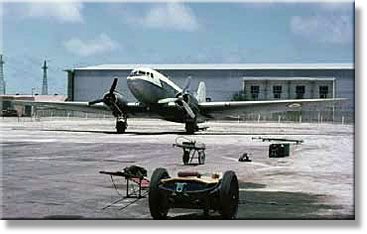
Tarshyne Beach - a shark net protected us, and the swimming, both inside & outside the net was terrific. I learned to surf here, a skill which stood me in good stead 10 years later, when stationed in Bordeaux, with access to the mighty Atlantic.
21 Squadron Twin Pioneer. A great little aircraft, built by Scottish Aviation in Prestwick.
21 Squadron Dakota. I believe this was the second-last RAF Dakota in service. When I went to Northolt after Aden I recall handling the last one, which was the aircraft “owned” by the Air Attaché in Norway.
All around the Station there were illicit bars, serving food and drink. Competition for trade was fierce. I seem to recall Jim Brett was involved in one of these, and of partaking of a very fine burger washed down with Stim.
Our AOC was Air Vice Marshal J E (Johnny) Johnson CB, CBE, DSO & Two Bars, DFC & Bar, the highest scoring RAF air ace of WW2. The AOC was known for, shall we say, his carefulness with money, like many a very senior officer before him and since. Apart from allegedly flying in 'Kenya Cold' i.e. prime beef in RAF aircraft, there's a widely-told story that many officers were invited to the Mess at Steamer Point for a reception given by the AOC. Everyone was looking forward to an evening boozing at the AVM's expense. Imagine their surprise when ordering a round, to find that their bar books had been shipped over from Khormaksar, and that they were funding this event themselves!
AVM Johnson was replaced by one of the finest senior officers I ever met, Andrew Humphrey, later Air Chief Marshal Sir Andrew GCB, OBE, DFC, AFC, whom I had the pleasure of moving in and out of RAF Northolt on numerous occasions as a DAMO there. And our CinC was the charismatic and memorable Admiral Sir Michael LeFanu. Stories about him are legendary, in particular his hatred of ceremony, typified by swapping his place with his driver, or, the story goes, jumping out of a window to see what really happened on base as opposed to what he was supposed to see, on a CinC's inspection.' Both these remarkable men sadly died before their time.
Our AOC was Air Vice Marshal J E (Johnny) Johnson CB, CBE, DSO & Two Bars, DFC & Bar, the highest scoring RAF air ace of WW2. The AOC was known for, shall we say, his carefulness with money, like many a very senior officer before him and since. Apart from allegedly flying in 'Kenya Cold' i.e. prime beef in RAF aircraft, there's a widely-told story that many officers were invited to the Mess at Steamer Point for a reception given by the AOC. Everyone was looking forward to an evening boozing at the AVM's expense. Imagine their surprise when ordering a round, to find that their bar books had been shipped over from Khormaksar, and that they were funding this event themselves!
AVM Johnson was replaced by one of the finest senior officers I ever met, Andrew Humphrey, later Air Chief Marshal Sir Andrew GCB, OBE, DFC, AFC, whom I had the pleasure of moving in and out of RAF Northolt on numerous occasions as a DAMO there. And our CinC was the charismatic and memorable Admiral Sir Michael LeFanu. Stories about him are legendary, in particular his hatred of ceremony, typified by swapping his place with his driver, or, the story goes, jumping out of a window to see what really happened on base as opposed to what he was supposed to see, on a CinC's inspection.' Both these remarkable men sadly died before their time.
After a while I joined AFBA (Aden Forces Broadcasting Association), and having passed the voice test, was assigned to Children's Programmes. My output was nothing special, but just OK. What all AFBA broadcasters wanted was to become a continuity announcer, regarded as the top job on the station. While not putting together programmes very few people listened to, I was learning to swim, coached by Nobby Clark & ATLO Major Ken. Spending time at the swimming pool was also good in other ways as off-duty BUA stewardesses could sometimes be persuaded to enjoy the delights of the pool.
By now, Tony Thompson & I were in a sort of competition for flying hours, and lots more off-duty time was spent flying up country with 84 or 21, or up the Gulf with 105. Personally, my favourite was helicopters, and I became friends with pilots Mike Tingle and Dave Ryall, and spent many happy hours in the Wessex.
I would serve with Mike again at Gütersloh, when he was on 18 Sqn. Sadly, Dave was subsequently killed in an HS748 civilian accident when a rear door detached & took the tail off. A highlight was a deck landing on HMS Bulwark. I became acquainted for the first time with the legendary Al Mathie, 8 Sqn Hunter pilot - we were to meet again at Gütersloh, when he was flying with 2 Sqn, and again when I was Jaguar liaison officer in Bordeaux in 1977, Al was flying Jaguars with l'Armée de l'Air Française. Al was killed in February 2012 by walking into a Piper Cub prop - he's hugely missed by very many.
I would serve with Mike again at Gütersloh, when he was on 18 Sqn. Sadly, Dave was subsequently killed in an HS748 civilian accident when a rear door detached & took the tail off. A highlight was a deck landing on HMS Bulwark. I became acquainted for the first time with the legendary Al Mathie, 8 Sqn Hunter pilot - we were to meet again at Gütersloh, when he was flying with 2 Sqn, and again when I was Jaguar liaison officer in Bordeaux in 1977, Al was flying Jaguars with l'Armée de l'Air Française. Al was killed in February 2012 by walking into a Piper Cub prop - he's hugely missed by very many.
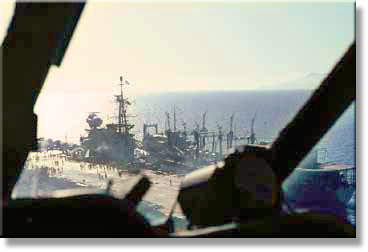
HMS Bulwark - Mike Tingle in the right-hand seat, I was in the left!
Work became pretty routine; load up Beverlys & Argosies at night, plus the occasional Belfast, send FRA and FRG troops up country every morning, deal with incoming pax from BUA flights, handle visiting aircraft like 30 Sqn Beverlys from Muharraq. Load up Britannias with troops on rotation. Send people on R & R to Kenya. Have breakfast in the middle of the night at Britannia House (the Khormaksar "Route Hotel"). It was a pity that the Catering Officer who ran it was so unpopular with Movers that when the time came for him to be posted back to the UK, his baggage mysteriously went to Changi.
I learned to play squash, coached by the enigmatic chopper pilot Mike Williams, whose 6' 5" height, experience and sheer skill made learning a painful process. One day it rained, and since it never did, the squash court had no roof - oh dear!
Lots of time was spent in Tawahi, negotiating for that very particular Seiko watch, that one you didn't really need, or that Pentax SLR that you'd never really learn to use properly unless you were Martin Henderson!
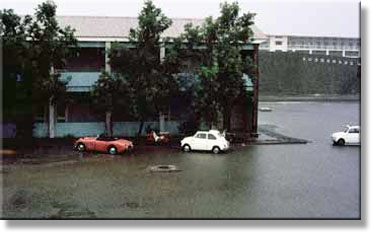
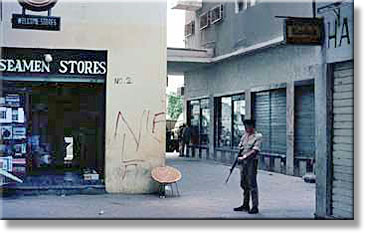
Yes, that’s rain! I think the white car is ‘Pricky’ Price’s Fiat 500. The building on the right, with the sloping circular windows is the squash court.
Shops in Tawahi with a Northumberland Fusilier on guard. It was useful to get negotiating techniques from an “old hand”- always accept a glass of tea, never expect really good results in under 5 visits, and using a poker face were all helpful bits of advice I got.
By now things were hotting up on the terrorist front - at that time it was all FLOSY (Front for the Liberation of South Yemen), and the NLF (National Liberation Front) were not really in it. There were daily rumours of massing troops coming to liberate Aden, there were acts of terrorism - blowing up the Pagoda Chinese Restaurant was both a crime and a non-crime, if you ever went there, you'd know why.
On a more serious note, I saw my first dead body, the German journalist Walther Mechtel, shot in Tawahi, when his body was being transferred at the Station main gate. Guard duty for someone like me was very scary. Armed with a Sterling with 2 magazines of ammo strapped to each other we had to visit various off-base locations. A combination of darkness & inexperience was an adrenaline-raiser, and not in a good way!
As time went on we had riots in Crater, subdued by the Argylls, under 'Mad Mitch' who became a client of ours when they shipped out of Aden. There were heroic, but unrecognised, acts of heroism by 78 Sqn helicopter pilots. The GOC, Maj Gen Philip Tower, was widely vilified. The politicians also. There was a great deal of uncertainty.
General Tower announced that we were on active service, and addressing the troops, said that they could now earn gallantry medals, he even suggested the VC. A wag shouted, 'the only VC we want is a VC10!'
On a more serious note, I saw my first dead body, the German journalist Walther Mechtel, shot in Tawahi, when his body was being transferred at the Station main gate. Guard duty for someone like me was very scary. Armed with a Sterling with 2 magazines of ammo strapped to each other we had to visit various off-base locations. A combination of darkness & inexperience was an adrenaline-raiser, and not in a good way!
As time went on we had riots in Crater, subdued by the Argylls, under 'Mad Mitch' who became a client of ours when they shipped out of Aden. There were heroic, but unrecognised, acts of heroism by 78 Sqn helicopter pilots. The GOC, Maj Gen Philip Tower, was widely vilified. The politicians also. There was a great deal of uncertainty.
General Tower announced that we were on active service, and addressing the troops, said that they could now earn gallantry medals, he even suggested the VC. A wag shouted, 'the only VC we want is a VC10!'
One day I had to go and meet an RN chopper - I think a Wessex - could it have been a Sea King? Anyhow, once the pax had disembarked I waited for the crew to check on turnaround arrangements. The captain descended, and I saluted Lt Cdr Hornblower! Many people do not believe this entirely true story.
I got a new SAC on pax handling duties - J T Whittle - real name Jude; as he explained it, when his father first saw him, he decided to call him Jude, after the patron saint of hopeless cases. J T hailed from Bolton, had a great sense of humour, & was a nice lad. Pax handling wasn't his thing, though & soon he was out on the pan loading Beverlys with the best of them. No-one ever discovered how a 40 gallon drum of aviation fuel, destined for Habilayn, came off the fork lift tines, but it did, and it killed J T. Fifty years on I remember him so well, and I remember his funeral in Silent Valley, the volley of shots over his grave, the utter silence and the searing heat, his grieving parents and the guys he worked with.
But there were lighter moments. John Damment was DAMO when a particularly difficult Belfast load happened during a night shift - a Beaver and a Scout come to mind? Anyway, after 13 hours of hard graft, the Loadmaster informed John 'It won't trim, sir!' John was furious, and standing next to the port sponson within which lay the APU, launched his hat at the aircraft, the while shouting one of his favourite phrases 'Oh my aching arse!' Hat enters APU intake - result - graunch, graunch & tech delay!
Opportunities to fly were pretty frequent, and the picture below (of Nisab) was taken on a Twin Pin flight, whose only real passenger was Sqn Ldr Alan D'Arcy, on his way to work political wonders with the local tribesmen.
I did a fair bit of flying with 21 Sqn - their trips were usually one-off, and interesting. I persuaded the irascible Dakota pilot Mike (Isherwood) Bennett to take me along to Kamaran Island, at the Southern end of the Red Sea. It was a fascinating trip, including the zero feet pass across the completely flat island. I spent the day snorkelling.
I did a fair bit of flying with 21 Sqn - their trips were usually one-off, and interesting. I persuaded the irascible Dakota pilot Mike (Isherwood) Bennett to take me along to Kamaran Island, at the Southern end of the Red Sea. It was a fascinating trip, including the zero feet pass across the completely flat island. I spent the day snorkelling.
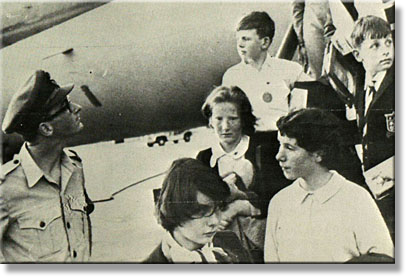
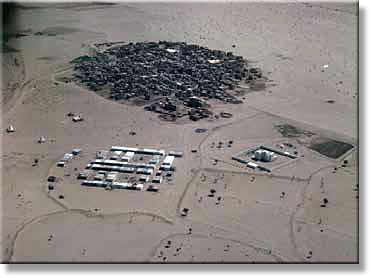
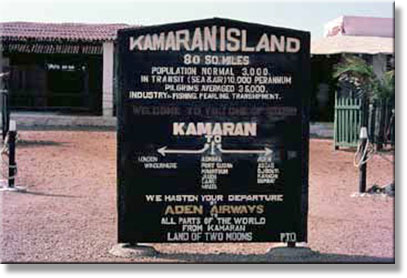
Meeting the "Lollipop Special"
Nisab looks amazingly large for an up-country town, but it was important politically - read Charles Collier‘s material. It‘s 250 km from Aden.
All about Kamaran
I was still doing a bit of flying, and so was my friend Martin Henderson. One day an Army Scout helicopter landed, piloted by an AAC Captain. We got into conversation & he offered to fly me over Crater. I called Martin & soon we were both sitting in the space behind the pilot, Martin with his smart SLR at the ready. On the ground, the lack of doors and seat belts was no problem at all... at 1500 feet over Crater executing sharp turns left and right it was the original white-knuckle ride! No photographs were taken on that flight.
The food in the Officers' Mess was surprisingly good, and gave me a lifelong enjoyment of saltwater crayfish and barracuda. Towards the end, various pranks were played in the Mess to the annoyance of the PMC. The fountain which lay between the dining room and the outside bar was attacked with a large quantity of Teepol, the resulting foam was on a heroic scale.
Sometime later an enormous dead fish was deposited in the fountain and a notice on the Mess board read 'The Phantom Fishmonger Strikes Again' - I can only think it was the heat and the stress that drove some young officer that far. It was all coming to an end in November 1967.
Sometime later an enormous dead fish was deposited in the fountain and a notice on the Mess board read 'The Phantom Fishmonger Strikes Again' - I can only think it was the heat and the stress that drove some young officer that far. It was all coming to an end in November 1967.
By now families had returned to the UK, and we single officers were moved into aircon OMQs just on the edge of the base. I shared with Jock Drysdale, Pete Kingwill & one other. We had our own bearer Mohammed, who looked after us well.
It was announced that we would leave Aden on the 30th November. Strange anti-shrapnel devices appeared on the pan. These were trollies, with walls of sand filled oil drums which greatly reduced aircraft handling capacity, but gave some protection from largely ill-aimed mortar fire.
It was announced that we would leave Aden on the 30th November. Strange anti-shrapnel devices appeared on the pan. These were trollies, with walls of sand filled oil drums which greatly reduced aircraft handling capacity, but gave some protection from largely ill-aimed mortar fire.
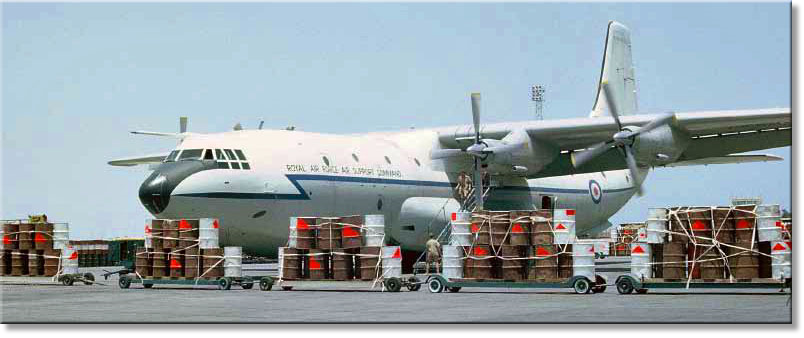
You can see the anti-shrapnel trollies around the aircraft here. There was a plan, if things got
really bad, to fly out 1000 people to safety, seated on the Belfast floor. Zero baggage allowance!
really bad, to fly out 1000 people to safety, seated on the Belfast floor. Zero baggage allowance!
Nobby Clark grabbed me one day and asked if I'd like to be seconded to him for the final weeks before we went home. You didn't say 'no' to Nobby and stay alive, so I agreed. We commandeered an office, and three walls out of four were covered with Perspex. Armed with the world's supply of china graph pencils, we proceeded to chart the exodus from Aden. Starting with, I think, 12,000 personnel and maybe 500,000 lbs of freight, we daily charted the reducing numbers, as Hercules after Hercules after Belfast was loaded up and dispatched.
n the last week, the battle between FLOSY and the NLF was won by the NLF & our bearer Mohammed turned up wearing their badge. The NLF flag flew over every building in sight. I left on the 30th November 1967, on a Hercules to Muharraq, 4 hours before the last Marine. The whole posting was a great experience, I learned a huge amount, and my Aden days have stayed with me vividly to this day.
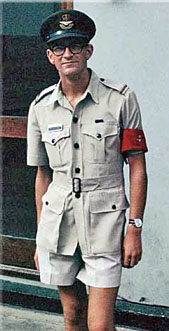
After spending 16 months helping to evacuate the Suez canal at 109 MU Abyad, (having returned following a 30 month tour at sunny 107 MU Kasfareet) I was posted to Aden and ended up in transit at the Sergeants Mess Khormaksar. I spent a few days pending a move to the Gulf but was redirected to the Equipment Section at the base where I took over the Reserve Pool (MTRP) . I cant quote any dates but soon after starting work I was asked to keep an eye on A group as the SNCO i/c had been flown home on compassionate leave; his dad was dying. With that job came the V&A Store.
The workload was reasonable for any SNCO who was used to doing a day's work, so far so good. Then a General Strike was called by the civilian labour in Aden proper. Our team continued to work well but the port came to a stop. For the first time in 50 years not a ship was allowed to dock. The CO ordered the reactivation of an old WW2 MT fuel site and I was asked as i/c MTRP to keep an eye on it. The pool involved me visiting the port whenever we expected vehicles shipped but for a short time did not happen.
When ships eventually got in to berth, SNCO equippers were sent to assist the offloading. On arrival at the berth we found an RAF Chief Tech Supplier liaising, shirt off, in the hold, working like a slave. I continued to collect my vehicles, mainly Landrovers.
The workload was reasonable for any SNCO who was used to doing a day's work, so far so good. Then a General Strike was called by the civilian labour in Aden proper. Our team continued to work well but the port came to a stop. For the first time in 50 years not a ship was allowed to dock. The CO ordered the reactivation of an old WW2 MT fuel site and I was asked as i/c MTRP to keep an eye on it. The pool involved me visiting the port whenever we expected vehicles shipped but for a short time did not happen.
When ships eventually got in to berth, SNCO equippers were sent to assist the offloading. On arrival at the berth we found an RAF Chief Tech Supplier liaising, shirt off, in the hold, working like a slave. I continued to collect my vehicles, mainly Landrovers.
At this time we started to receive large consignments of barrack stores and I was called in to see the Squadron Leader who told me that the Flt Sgt Barrack Warden was ill and I would be covering for him! I had just left Abyad, having spent 16 months closing down O and AMQs and now had the task of equipping 12 new officers plus 50 new airmen quarters. This was sod's law.
From: James Durkin, Stafford, Staffs
Subject: Memories of Aden
Subject: Memories of Aden
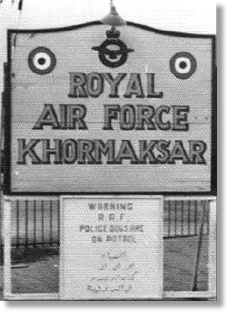
I had recently been told I was no longer on the waiting list for a house as I had six months or less to complete my tour! It was about now that I met my new boss, Plt Off Gerry Pengelly. He used to come into work after a game of rugby full of battle scars. He got on well with our team.
By now the fuel supply from Little Aden was at risk and we SNCOs were detailed to cover day and night time receipts. The tanker drivers did a great job getting to us and later one of the Besse staff was awarded the BEM. While all this was going on the Suez invasion had happened and lots of trouble in the Gulf and up country and a massive reinforcement of Aden took place; at least for regiments representing the KOYLI, the Shropshires and at least two Scots. Air wise we had two Vampires airborne every 15 minutes plus a Lincoln heavy on call to help when needed.
Just before my repatriation came I met (the then) Sgt John "Paddy" Guerin who had been in transit from Karachi to the UK when the embargo on us had happened and they had him working at the MU. I met him on repat at AMS Abingdon. I then went on the Movements course at Kidbrooke and left a letter to Gerry Pengally in my desk which was allocated to him on the following course. I met him once very briefly as he left a senior officer's office as I was arriving to go into the same office. We spoke a couple of times workwise on the phone a couple of times and similarly with John but did keep bumping into him over the years.
For me and many others, Aden was a busy and sometimes dirty tour at work. I enjoyed working with Gerry no matter what /which job I was on at the time and you think I learned about multi tasking too. Just a bit!
Cheers!
Jimmie
[Editor's Footnote: Gerry Pengelly eventually became D Mov(RAF) and just last week he honoured us by joining the ranks of the OBA]
By now the fuel supply from Little Aden was at risk and we SNCOs were detailed to cover day and night time receipts. The tanker drivers did a great job getting to us and later one of the Besse staff was awarded the BEM. While all this was going on the Suez invasion had happened and lots of trouble in the Gulf and up country and a massive reinforcement of Aden took place; at least for regiments representing the KOYLI, the Shropshires and at least two Scots. Air wise we had two Vampires airborne every 15 minutes plus a Lincoln heavy on call to help when needed.
Just before my repatriation came I met (the then) Sgt John "Paddy" Guerin who had been in transit from Karachi to the UK when the embargo on us had happened and they had him working at the MU. I met him on repat at AMS Abingdon. I then went on the Movements course at Kidbrooke and left a letter to Gerry Pengally in my desk which was allocated to him on the following course. I met him once very briefly as he left a senior officer's office as I was arriving to go into the same office. We spoke a couple of times workwise on the phone a couple of times and similarly with John but did keep bumping into him over the years.
For me and many others, Aden was a busy and sometimes dirty tour at work. I enjoyed working with Gerry no matter what /which job I was on at the time and you think I learned about multi tasking too. Just a bit!
Cheers!
Jimmie
[Editor's Footnote: Gerry Pengelly eventually became D Mov(RAF) and just last week he honoured us by joining the ranks of the OBA]

From: Len Bowen, Chisholm, ACT
Subject: Memories of Aden
G'day Tony,
Never served in Aden, but was there as a teenager 1956 -1958, so I don't know if that counts. The MQ we lived in was beautiful, especially after some of the dives we'd had to live in when we first arrived in Aden, but that's a long story with no relevance to AMS matters.
Subject: Memories of Aden
G'day Tony,
Never served in Aden, but was there as a teenager 1956 -1958, so I don't know if that counts. The MQ we lived in was beautiful, especially after some of the dives we'd had to live in when we first arrived in Aden, but that's a long story with no relevance to AMS matters.
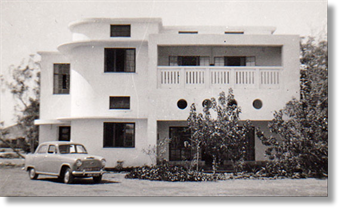
Only real problem was that the water tank was on the roof, so if you wanted a cool shower you had to be up by about 06:30, before the sun got up. By the time I came home from school (13:00) the water was too hot to even wash your hands in. Solar heating way, way before it became trendy!
The MQ was big, but of course we had a 'native bearer' as house boy to help Mum keep the place clean - though Mum, being a Scotswoman of the old school insisted on doing all the cooking even in 100F+ heat. No aircon in those days!
Our house boy, Mo Mohammed, was a young Somali lad. Very, very keen and very, very industrious... just a pity that about five years after we left Aden he became one of the leaders of one of the main anti-British terrorist groups! Wasn't anything we did or said to him; honest!
Rgds, Len b
The MQ was big, but of course we had a 'native bearer' as house boy to help Mum keep the place clean - though Mum, being a Scotswoman of the old school insisted on doing all the cooking even in 100F+ heat. No aircon in those days!
Our house boy, Mo Mohammed, was a young Somali lad. Very, very keen and very, very industrious... just a pity that about five years after we left Aden he became one of the leaders of one of the main anti-British terrorist groups! Wasn't anything we did or said to him; honest!
Rgds, Len b

Late message from Richard (Dick) Lloyd: There's a service in York Minster on 29th November 2017 to commemorate 50 years since our withdrawal. Organised by Aden Veterans Association, both Martin Henderson and I will be attending. More info e-mail me.

New members who have joined us recently:
Trevor Porter, Birgu
Gerry Pengelly, St Neots, Cambs
Welcome to the OBA!

More Relevant Stuff
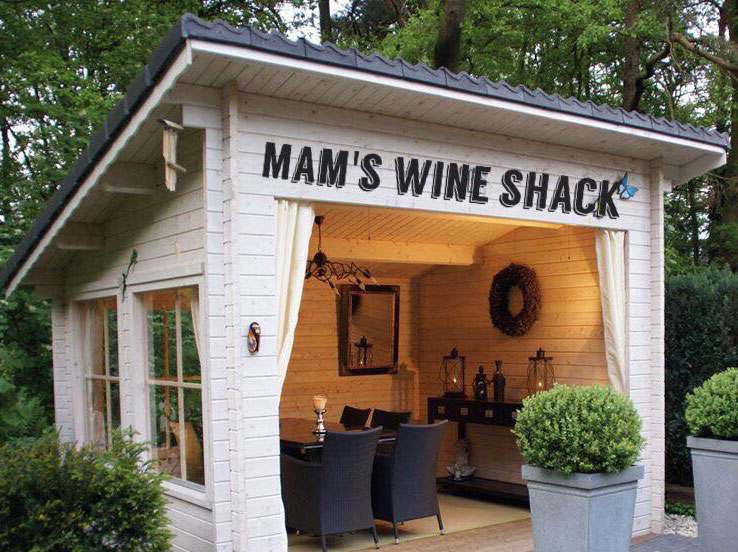
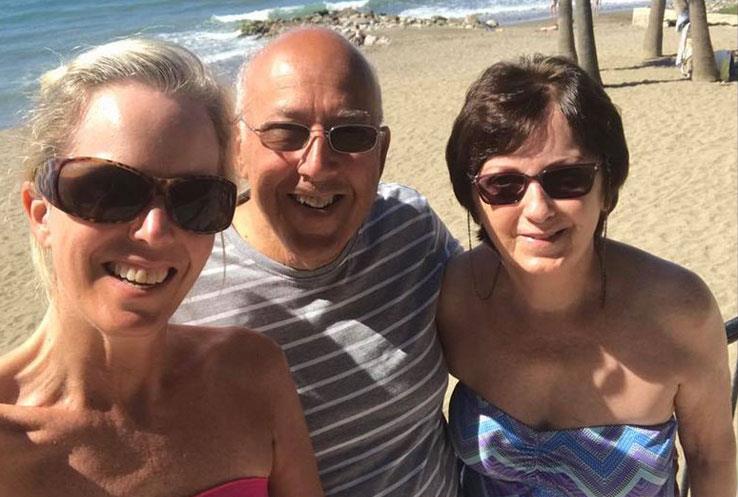
Duncan Grant (RAF) with two lovely ladies he met on
his morning "power walk" along Marbella sea front
his morning "power walk" along Marbella sea front
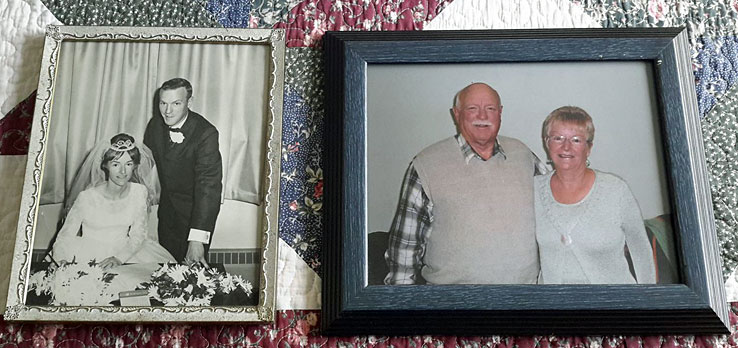
John Boates (RCAF) and his beautiful bride, Gail, celebrated their 50th Anniversary recently
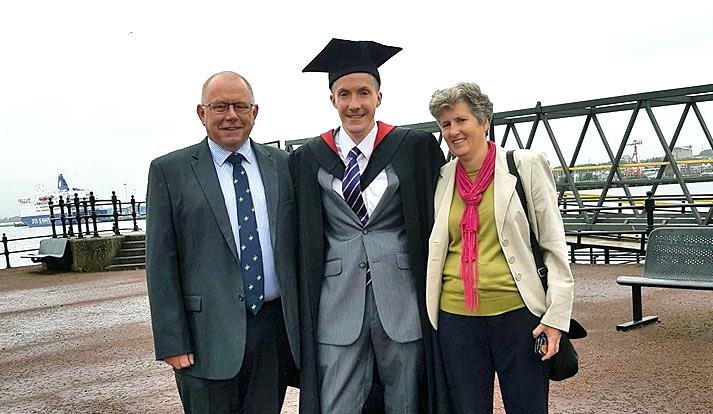
John, George & Rachel Belcher (RAF) - "It was George, my eldest’s, graduation from South Shields Marine School with a Foundation Degree in Marine Engineering. He now has to pass his oral exam to gain his Certificate of Competency and then he will be a 3rd Engineering Officer in the Merchant Navy….and looking for a job."
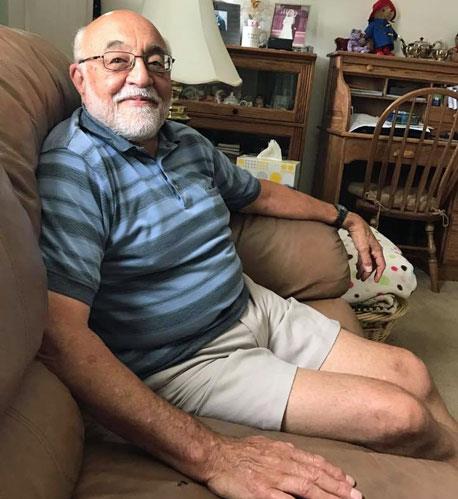
Roger Blow (RAF) at his home in Crown Point, Indiana - looking all patriotic on July 4th!

Frank Holmes (RAF) - "This is a picture taken at Twickenham when my daughter, Daisy, took her old dad to an English rugby match which we like doing together as much as we can."
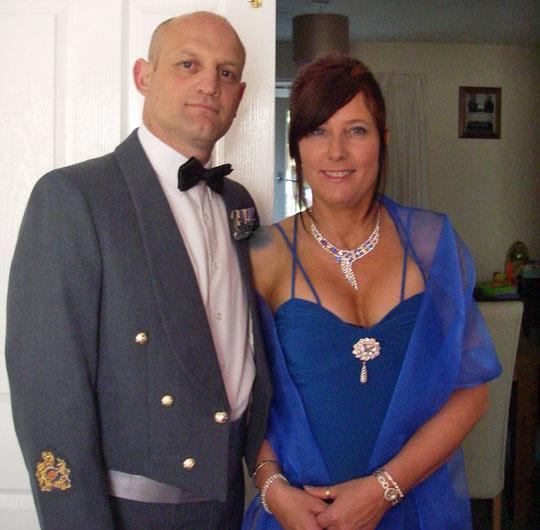
Neil and Michelle Cutler (RAF) - heading out for an evening of fun at Brize Norton
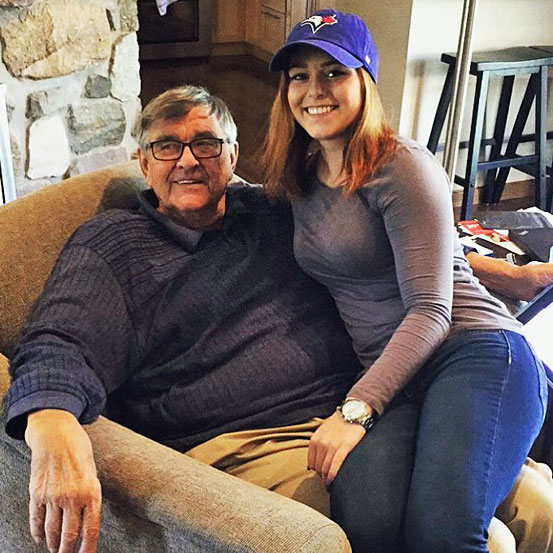
Tony Street (RCAF) along with granddaughter, Heather, chillaxin' at home in Buffalo, NY
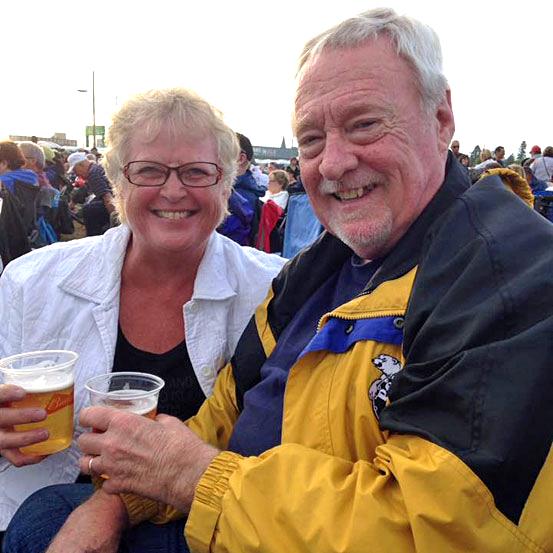
Janet Black and Harry Grace (RCAF) enjoying some wobbly pop in Fort Saskatchewan, AB
From: Sean Culligan, Valetta
Subject: A thought for a topic
Hi Tony
This is a long overdue thank you for the work that you put in, keeping us informed and doing so very much to hold us all together via the newsletter. Thank you!!!
One idea I had for a possible "running" input for the newsletter- "Pet hates/ Things that made movers roll their eyes and say "Why ME?! One of mine was the op order that sent us off to load band instruments... in the ventral of a VC10... on a short turn round!
Another one was picking up SAS / SBS from almost anywhere as they would always have twice as much kit as indicated in the op order.
You know the sort of thing I mean? It's just an idea and I won't be the least offended if it ends up in the bin!
Cheers
Sean
Subject: A thought for a topic
Hi Tony
This is a long overdue thank you for the work that you put in, keeping us informed and doing so very much to hold us all together via the newsletter. Thank you!!!
One idea I had for a possible "running" input for the newsletter- "Pet hates/ Things that made movers roll their eyes and say "Why ME?! One of mine was the op order that sent us off to load band instruments... in the ventral of a VC10... on a short turn round!
Another one was picking up SAS / SBS from almost anywhere as they would always have twice as much kit as indicated in the op order.
You know the sort of thing I mean? It's just an idea and I won't be the least offended if it ends up in the bin!
Cheers
Sean
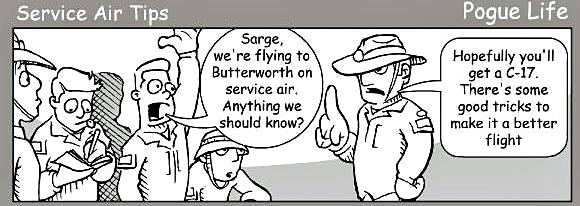



This Newsletter is dedicated
to the memories of
Ian 'Chrisso' Christensen (RAAF)
~ and ~
Rob Reidlinger (RAAF)
to the memories of
Ian 'Chrisso' Christensen (RAAF)
~ and ~
Rob Reidlinger (RAAF)
Tony Gale
ukmamsoba@gmail.com
ukmamsoba@gmail.com
